Archives: Reports
2018 State of American Energy
Energy Is Powering Innovation
Natural gas and oil are integral to innovations that safely and efficiently supply the daily energy Americans need, as well as the modern products that make lives safer, healthier and more convenient. Natural gas and oil also boost innovation in other fields that support growth, prosperity, discovery and human advancement.
- Pinpointing Energy Reserves
- Precise And Efficient Production
- 24/7 Infrastructure Monitoring
- Expanding Natural Gas Availability
Innovation Is Revolutionizing The Oilfield
 Eric Holderby
Eric Holderby
District Technology Manager, Halliburton – Oklahoma
“We collect data on everything and are constantly using it to learn more about our operations.”
The natural gas and oil industry will long be associated with the hard work of oilfield workers – iconic in their hard hats, coveralls, heavy-duty leather gloves and work boots as they maneuver lengths of steel pipe and perform other tasks on a drilling platform or at a well site.
While those men and women are still there, performing essential on-site functions, today’s industry has a high-tech dimension as well, with innovative technologies and computer-assisted data management and analysis playing leading roles in the ongoing quest to safely and responsibly develop the energy the United States needs.
What might surprise the 55 percent of American consumers recently surveyed, who immediately think of roughnecks when they think about industry, is that many industry jobs actually take place inside office buildings, laboratories and research facilities. And many of the men and women wearing hard hats and coveralls at a well site today are highly educated engineers and scientists.
Halliburton is among the many companies pioneering high-tech approaches to energy development. “The historic belief that our industry is slow to adopt technology simply doesn’t hold true,” says Stephen Ingram, the company’s vice president of technology solutions and innovation. “In the last 10 years the industry has been transformed through advances across every aspect of oil and gas development, from advances in the drill rig and in directional drilling technology, to innovations that improve logistics and infrastructure.”
Inside a hydraulic fracturing site control room is a great place to see the industry’s high-tech nature in action.
Halliburton District Technology Manager Eric Holderby, 31, leads a group of about 90 engineers, chemists and scientists, many of whom work alongside him on the front lines.
“Technology supports everything we do,” says Eric. “There are a lot of things going on at the well site, and we’re monitoring all of it. We can control and make adjustments from right inside these rooms – it’s pretty astonishing.”
Eric describes his team’s work as a continuous learning effort. “Our work has become incredibly data-driven. We collect data on everything and are constantly using it to learn more about our operations. Our industry has a huge impact on everyone’s daily lives, so optimizing deliverability is critical. With the data we collect, we’ve made huge gains in knowledge. That translates to more affordable energy, more efficiently delivered.”
These days, Eric is most excited about the company’s new Remote Operations Command Center (ROCC) in El Reno, Oklahoma, the largest Halliburton ROCC in North America. “We can see and make changes to jobs that are happening in locations all over the country from this flagship hub,” he says. “Five years ago, I wouldn’t even have thought this was possible, but this is where we are today.”
As Ingram explains, “The industry is transitioning in real-time. We’re moving away from old ways of doing business to how we will be doing business in the future.”
Fortunately, the labor force is changing, too. “A lot of the people reporting to me are just out of school,” Eric says. “And the more we advance technologies, the more we can attract young, talented people who want to be part of innovation. This is not the oilfield days of old.”
Innovating To Meet Challenges Today And Tomorrow
The future belongs to the innovators – people and industry sectors that can create and deploy advanced technologies, systems and processes to meet the challenges of tomorrow.
The men and women of the natural gas and oil industry are innovators, with a history of taking unique and technology-driven approaches to problem solving in the energy space. We innovate to bring energy to Americans safely and efficiently, recognizing that energy is essential to Americans’ security and the foundation of individual opportunity and well-being. We also support the innovation of others, supplying fuels, products and the chemical building blocks needed to foster growth, prosperity, discovery and human development.
Innovation is at the heart of what we do: finding and producing natural gas and oil. Innovation spurs safe operations, and it allows us to increasingly minimize our environmental footprint.
From Edwin Drake’s first oil well in Pennsylvania in 1859 to today’s advanced, computer-assisted technologies that leverage data analysis and science for precision in exploration and production, the natural gas and oil industry has come far by meeting challenges through innovation.
Innovation is apparent in virtually every step of natural gas and oil development.
We innovate to better locate and develop natural gas and oil reserves thousands of feet below the earth’s surface and tens of thousands of feet below the ocean floor. With cutting-edge imaging technologies, knowledge of petrophysics and the use of algorithmic data analysis, operators can understand where to explore in a given geologic profile. And, thanks to the technical ability to drill horizontally for thousands of feet in any direction from a single vertical shaft, our surface footprint is smaller, and there’s greater production and cost efficiency with each well.
There’s innovation once the well is developed, with portable control rooms that resemble those at NASA, managing hydraulic fracturing to safely release natural gas and oil molecules from tightrock formations – uneconomic just a decade or so ago. More energy is being developed from each natural gas and oil reserve through advancements in hydraulic fracturing, sand volume, spacing, lateral placements and enhanced recovery technologies. With fiber optics and other technologies, operators can monitor and manage downhole activity, including the process of completing a drilled well to start the flow of natural gas and oil.
America’s energy renaissance, which has made our country the world’s leading natural gas and oil producer, is driven by technology and innovation.
Innovation also is embedded in safety – for workers and the surrounding environment. Breakthrough, “smart” technologies are used to identify potential problems before an incident occurs and protect pipelines from threats such as corrosion. Innovative processes allow pipelines to cross well beneath river bottoms without disturbing the river or surrounding environment. Technology is helping reduce the emission of greenhouse gases, such as methane, through state-of-the-art leak detection and advanced equipment designs.
Natural gas and oil also fuel innovation in other fields. These include science, medicine, health care, communications technology, transportation and the arts, and they serve as the chemical building blocks for countless products. Natural gas and oil play these essential roles because they’re abundant, reliable, versatile and packed with energy content. Other energy sources don’t have the adaptability and usefulness of natural gas and oil when it comes to supporting innovation – from routine items like moisture-wicking clothing to high-tech, 14-layer space suits astronauts may one day wear on Mars. Natural gas and oil provide manufacturers with the chemical feedstocks to support drone technology, development of exoskeleton suits, robots and more.
Our companies are even investing in enhancing other energy sources, such as solar, wind and advanced biofuels, including those made from algae and cellulosic sugars. All of these are in addition to thousands of consumer products Americans use every single day.
Past and current natural gas and oil innovation set the foundation and shape the mindset for future innovation – for technologies on the drawing board as well as those that are just a glimmer in the mind of an industry scientist, geologist or engineer. We innovate and develop technologies for the future because it’s our history and mindset.
“[I]n a free society solutions are eventually found. And in the long run, the new developments leave us better off than if the problems had not arisen.” – Academic Julian Simon
The following cards describe just some of the innovations industry uses to make energy exploration more precise and production more efficient, which enhance environmental progress.
Innovation From Start To Finish
Across the industry, innovation is leading the way.
The technologies that follow are used by companies across the industry for safety, better and more efficient production, energy management and delivery, refining, and power generation and storage. Efficiency and safety protect workers and the environment, and help manage production costs.

Continuous, simultaneous management of multiple drilling rigs from centralized support centers helps ensure safe and efficient operations in real time.

Individual sites and service companies are using virtual reality tools to train plant crew members. This gives new employees, or those in need of a quick indoor refresher course, the opportunity to walk a refinery and learn about its processes without ever getting their boots dirty.

Data analytics increasingly guide industry operations, from exploration and development to transportation to refining. Operators can crunch data to determine the safest, most productive ways to develop, transport and process natural gas and oil. Companies analyze data from their operations to streamline processes and make the best tactical decisions possible.

IIoT-enabled facilities have transformed for the future. For example, refiners can monitor data closer to its source, coordinating maintenance and connecting workers. Companies carefully manage access to IIoT control systems and infrastructure, working with security firms to protect data integrity and process controls.
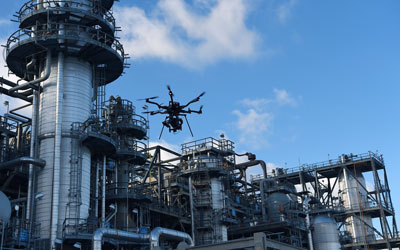
Drones and robots can make it easier to access difficult or remote operational areas to analyze equipment integrity, collect data and provide situational awareness with less risk to personnel. At refineries, for example, drones may be used to analyze gases and to check the integrity of the stack itself, reducing the need for interruptions to operations.
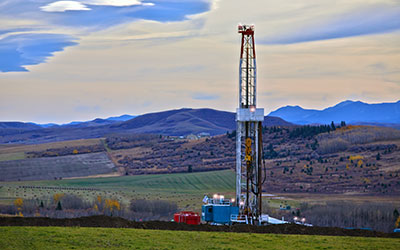
Listening devices at the surface and down the well help locate the origin of fractures in reservoir rock, to help plot the location of petroleum reserves, increasing production efficiency.
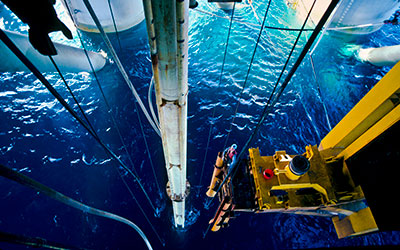
The most effective drilling locations may be predicted using physics and a technology known as machine learning. An algorithm also can help guide drilling, while multivariate statistical models can predict sweet spots in geologic formations.

Temporary fiber optic cables can be put inside a well to collect a variety of data and allow operators to observe the well’s performance in real time. Permanent fiber optics help measure production flow and the effectiveness of well completions work.

Sound waves and processing technologies, inversion modeling and imaging algorithms help map subsurface conditions – onshore and offshore – to provide greater certainty in exploration and production and minimize the surface footprint.
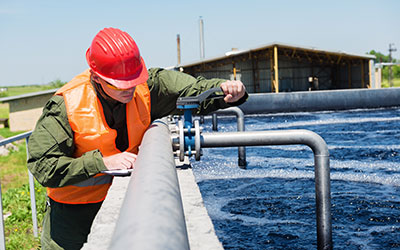
A number of strategies have the same goal – using less fresh water for hydraulic fracturing operations. Some companies use brackish water or wastewater, while others have invested in filtration and other processes to reuse water that is produced during well completion. These processes save water and reduce the number of trucks needed to haul in water for operations.

Through the use of sound waves, engineers can understand the physics of rocks and predict how much natural gas and/or oil may be produced.
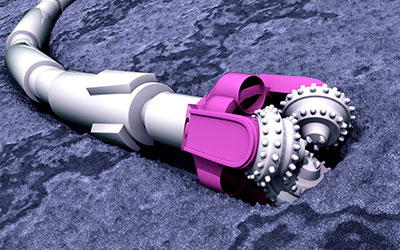
From a single vertical well, multiple horizontal wells can be developed, limiting the surface footprint. These laterals allow more efficient natural gas or oil recovery in energy-bearing strata, or the use of enhanced recovery methods, such as steam, to maximize production, especially in heavy oil plays.
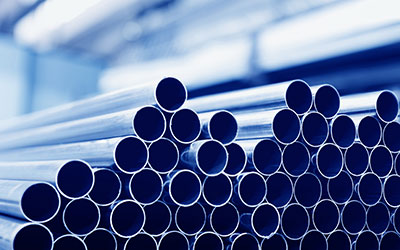
Industry uses specially advanced equipment and state-of-the-art processes to design and construct pipelines with the highest grade of steel, with strengths typically ranging from 70,000 to 80,000 pounds per square inch (psi). Armored tanks and personnel carriers use grades of steel in the range of 36,000 to 50,000 psi.

Diagnostic tools traveling inside pipelines scan the walls with technologies similar to an ultrasound or MRI to locate even microscopic cracks. They’re part of the reason operators are able to prevent incidents before they occur.
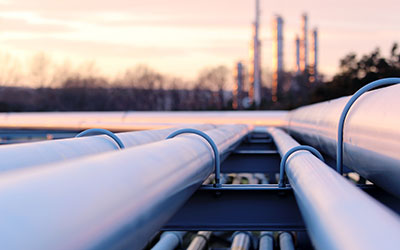
From infrared cameras to fiber optic cables installed alongside a pipeline, operators are employing new technologies and techniques allowing for 24/7 monitoring, ensuring if a leak does occur it can be quickly identified and potential impacts mitigated.

Operators often use steerable, trenchless tunneling to lay pipeline under a river or road without affecting the surface. Directional tunneling reduces the surface construction footprint and decreases the possibility of erosion.

Focused on preventative maintenance, operators are using robotic crawlers to scan and detect features in facility pipelines that are smaller diameter and have multiple bends.
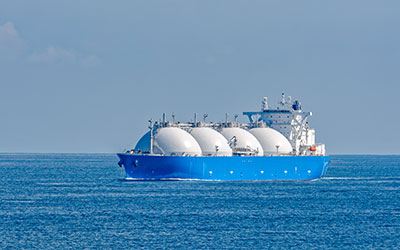
To meet new global standards, ships today use low-sulfur fuel types, including diesel, liquefied natural gas, methanol, ethanol and biofuels, among others. As the fuel industry expands, commercial economics, infrastructure and availability are the key factors that will continue to drive innovations in global shipping.

Technologies are being developed to capture carbon dioxide from power plants and factories, helping to reduce CO2 emissions and potentially making natural gas-fueled electricity generation even cleaner.

Working with rail tank car builders and railroads, industry has sought improved designs and effective standards – including thicker steel, enhanced thermal protection, extra shielding at the car’s ends and improved pressure release valves. These make shipping crude by rail, already with a 99.999 percent safety record, even safer.
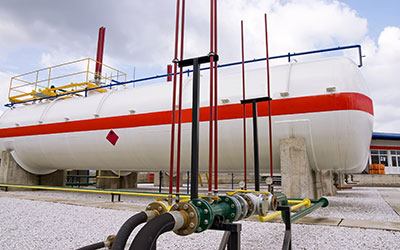
Refined products must be consistent in availability, cost and quality, yet raw materials and market conditions constantly change. Refiners continuously analyze each process unit – from distillation columns to hydrocrackers to naphtha processing units. Specially designed online processing control technologies help maintain safe and steady operations, optimizing production.
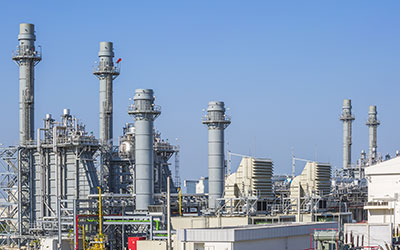
Natural gas to generate power, combined heat and power, microturbines and natural gas direct carbon fuel cells are examples of innovation bringing the benefits of natural gas to homes and businesses.
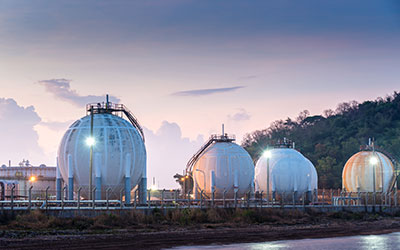
Companies are investing in technologies that help improve air quality by reducing refinery energy consumption. A good example is on-site cogeneration plants that recover a refinery’s waste heat from one process and use that to power another process.
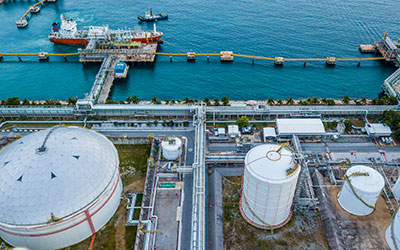
Vessels that can store, transport and return liquefied natural gas to a gaseous state right onboard help make natural gas available to more markets around the world.

Fuel cells provide critical energy backup for many large facilities, and they can provide primary energy for remote locations. Fuel cell technology generates electricity from hydrogen while emitting nothing but water.
Technology And Innovation Foster Safety And Integrity
 Leslie Fangue
Leslie Fangue
Facility Integrity Manager, Plains All American – Texas
“In reality, pipelines are one of the safest ways to transport crude oil and natural gas, especially across great distances.”
The U.S. pipeline industry safely and reliably operates hundreds of thousands of miles of delivery infrastructure across the country – bringing petroleum and petroleum products from production areas to refineries to consumers and manufacturers – thanks to a specially trained workforce that’s aided by continually advancing technology and innovation. It’s an equation that has produced a 99.999 percent transportation safety record.
Plains All American owns and operates 20,000 miles of North American pipelines, transporting crude oil, natural gas, natural gas liquids and the finished products that go into an endless list of items Americans count on every day. Pipeline integrity managers like Plains’ Leslie Fangue work to ensure that everything flows as planned. Leslie and her counterparts throughout the industry analyze operations and complex data gathered from inspections to identify and address anything that could affect a pipeline’s health as quickly as possible.
“I really connected with the idea of integrity, which is all about keeping the oil and gas inside the pipes, where it belongs,” explains Leslie, who was drawn into the midstream integrity specialty during a college internship on her way to a civil engineering degree. “I get to be directly involved with solving problems and managing risks that protect people and the environment. I feel like I’m doing the right thing every day.”
Like roads, bridges and all other kinds of infrastructure, pipelines may change over time. Pipeline facilities include an assortment of components such as pumps, sumps, compressors, meters, tanks and station piping – each of which is inspected using different technologies and techniques. For example, station pipes can be inspected using a technology called guided wave. This involves strapping a tool affixed to a collar around a section of pipe and using ultrasonic waves to detect changes in wall thickness – up to 30 feet in either direction. As the ultrasonic waves travel down the pipe, anomalies are detected, allowing operators to know where to make repairs.
For decades, mainline pipelines have been inspected using in-line tools known as “pigs,” so-called because of the squealing sound they make when moving through pipe. Today, “smart pigs” fitted with an array of high-tech sensors can detect conditions that could affect pipeline integrity, such as metal loss, changes in wall thickness, dents, gouges and cracking. Using onboard GPS, they can identify the location of each anomaly and tag it so that crews can quickly find the right spot for further analysis and repairs.
“Across the entire industry, we’re always working for continuous improvement,” Leslie says. “[P]ipelines are one of the safest ways to transport crude oil and natural gas, especially across great distances … API has a Pipeline Integrity Group that gives us a great forum for sharing best practices, improving industry standards and making sure all operators are on board. Most companies like ours are working hard to go above and beyond regulatory requirements.”
As the 99.999 percent safety statistic shows, they’re doing an excellent job – aided by innovative uses of technology and a commitment to safety.
Energy Is Powering Environmental Progress
Using advanced technologies, natural gas and oil are produced more cleanly and with a smaller environmental footprint. Companies are focused on reducing emissions of methane during production while refineries are producing cleaner fuels.
- Leading Emissions Reductions
- Empowering Renewable Energies
- Developing Cleaner Fuels
- Partnering To Advance Environmental Goals
The High-Tech Approach To Environmental Stewardship
 Colleen Faber
Colleen Faber
Environmental Health & Safety Supervisor, Anadarko Petroleum – Wyoming
“Any reduction in our impacts is as good for the industry as it is for the environment, for our communities, and for our own families.”
Today’s natural gas and oil companies are committed to safely developing the energy Americans use every day while also protecting the environment.
A health, safety and environment senior staff representative for Anadarko Petroleum, Colleen and environmental professionals like her at other companies across the natural gas and oil industry work to ensure that industry’s environmental progress continues – built on technology, innovation and ever-improving industry standards and best practices.
Colleen has a degree in agronomy from Montana State University, and she has dedicated her career to safe land use and environmental stewardship. Since she began working at Anadarko in 2004, industry has come a long way.
Engineering innovations like directional drilling are game changers in industry’s effort to limit its environmental impacts. “A single horizontal well can take the place of 10 vertical wells,” Colleen says. “This means less air emissions, less water usage and disposal, and a much smaller surface footprint to produce just as much oil and natural gas.”
Technology and data are also integral across every aspect of oil and natural gas development. “Before any kind of development begins we use geographic information systems data to vet locations, so we can evaluate risks and make the best possible selection,” she says. “Once we pick a location, we do extensive monitoring at the surface to understand the vegetation and soil, so we know exactly how to restore the land once it’s time to shrink our footprint.”
It takes about four to eight weeks to set up and perform a horizontal drilling and fracking operation. Once these activities are completed and the wells are flowing, the heavy equipment is removed and the land around the site pad is restored to its former state. All that remains on the pad are the well heads, valves, flow lines and storage tanks, which take up a fraction of the site’s original footprint.
“Improved practices during drilling and fracking make a significant difference,” she says. “By using surface pipelines to bring in water during drilling and fracking, along with remote telemetry that lets us monitor everything happening at the well sites without having to make daily visits, we’ve made huge reductions in vehicle traffic. This makes our operations safer and better for the environment, for wildlife and for communities.”
While oil and gas companies are busy developing energy from natural resources, they’re also partnering with universities and other facilities to support research and development that continues to move the industry’s environmental progress forward.
“Anadarko was the University of Wyoming’s Research Partner of the Year in 2015,” Colleen says with pride. “Investing in engineering innovations and new technologies is a win-win proposition. We may spend more up-front, but any reduction in our impacts is as good for the industry as it is for the environment, for our communities, and for our own families.”
Positive Change Through Leadership, Technology
Protecting The Environment Is A Core Industry Value.
The communities in which our companies operate expect that we will work to protect the air and water, that we will strive for the smallest possible footprint and that we will carefully restore areas when work is completed. Environmental stewardship is essential to sound corporate conduct. We’re committed to safely and responsibly supplying Americans with the energy they use every day because they’re our neighbors, and these are our communities, too.
Our industry invests in ongoing research into new technologies and other practices for cleaner, more efficient operations. Government data show this commitment has worked. Greenhouse gases have been greatly reduced, cleaner-burning fuels have helped improve air quality and our stewardship of valuable resources, such as water and surface spaces, has grown.
Since 2005, carbon dioxide emissions from power generation have decreased 25 percent.
- By 2030, power plant CO2 emissions could drop as much as 30 percent from 2005 levels
- Fuel switching to natural gas is responsible for the majority of power plant emissions reductions
- CO2 emissions from energy use across the entire economy are at the lowest levels in nearly 25 years
In our latest commitment to environmental performance, we launched The Environmental Partnership, whose participants will work together to further reduce emissions from natural gas development. The partnership also is designed to identify additional opportunities for action on other environmental issues in the future
Bottom line: The natural gas and oil industry will continue advancing environmental performance through innovative research, technology and operational practices.
Greater use of clean, reliable, affordable natural gas is driving significant environmental improvements. The United States is leading the world in CO2 emissions reductions because of abundant domestic natural gas and its use across our economy.
Growing use of natural gas as a fuel for electricity generation has helped lower emissions of carbon dioxide from the power sector to their lowest point in nearly three decades. By 2030, these emissions could drop as much as 30 percent from 2005 levels, primarily as a result of continued fuel switching to natural gas for generating power.
Methane Emissions Down by 16.3%
Between 1990-2015.
Natural Gas Production Up by 52%
Between 1990-2015.
Natural gas is also the essential partner to intermittent renewable energy sources, providing reliable fuel for power generation when the other power sources are unavailable. At the same time, natural gas goes into the production of wind turbine blades and photovoltaic cells – meaning that as more renewable power generation comes online, natural gas’ role will grow, too.
Industry continues to reduce its own emissions. While natural gas production rose nearly 52 percent between 1990 and 2015, emissions of methane from that production declined 16.3 percent. This is primarily because of industry investments in better, more efficient equipment, leak detection measures and other mitigating technologies.
The Environmental Partnership is industry’s voluntary commitment to continuous improvement in environmental performance, with its first initiative focused on taking actions to reduce emissions associated with natural gas and oil production.
The Environmental Partnership’s mission is continuous improvement of the natural gas and oil industry’s environmental performance. Program highlights:
- 27 participating companies
- Reducing methane and other emissions from onshore natural gas production
- Incorporating new technology and best practices
- Reporting and tracking progress
- Sharing data and knowledge

Initially, participating companies are focused on reducing methane emissions from onshore natural gas operations, because EPA identified these operations as a leading source of those emissions.
The foundational principles of the partnership include, first, a commitment to take action and to put technology and innovation to work to further cut methane emissions. Second, participants have agreed to share scientific data, to learn together and to expand what is known about emissions and effective emissions-cutting technologies and programs. The third founding principle, underlying the other two, is collaboration, a commitment to create a united industry effort to achieve emissions reduction goals.
The broader goal is steady environmental progress, which is why participants are committed to annual reporting, which will track that progress and help guide the program in the future. The partnership is adaptable, so that cooperation to reduce emissions may help tackle other important issues in the years ahead.
We have been able to produce more natural gas while also lowering emissions. But rather than rest on these accomplishments, this industry is seeking to build on them. The Environmental Partnership will help America’s natural gas and oil industry share goals, technologies and best practices that will make our environmental performance even stronger.” – Mark Berg, Pioneer Natural ResourcesEnvironmental Enhancements
Industry’s commitment to the environment is backed by hundreds of billions in investments: in technologies to reduce emissions during production, to improve air quality at refineries, to support ongoing environmental research and development and to make cleaner fuels for U.S. cars and trucks.
Cleaner fuels used in today’s more efficient vehicles are helping reduce pollutants in tailpipe emissions. Overall, new cars, trucks, SUVs and heavy-duty trucks and buses run about 99 percent cleaner than models produced in 1970, according to EPA. These helped reduce U.S. air pollution by 73 percent between 1970 and 2016, even as vehicle miles traveled increased 190 percent and the economy grew 253 percent.
The industry also is researching zero- and low-carbon technologies in support of substitute and less carbon-intensive fuels and other energy technologies. Investments totaled nearly $90 billion from 2000 to 2014 – almost as much as the rest of U.S.-based private industries combined. Our companies are investing in wind, solar, biofuels, geothermal and landfill digester gas. Since 2000, the industry accounted for $1 out of every $6 spent on non-hydrocarbon technologies.
Between 1990 and 2016, industry has invested more than $339 billion on environmental enhancements.
- Improved environmental performance: Fuels, operations, facilities
- Focus: Technologies, research & development $1,045 for every person in U.S.
- Includes $166 billion spent by U.S. refiners
Our industry is meeting the country’s energy needs while minimizing our environmental footprint. U.S. natural gas production reached an all-time high in 2015 – more than 27 trillion cubic feet – while crude oil production reached 3.4 billion barrels, output not seen in more than four and a half decades. At the same time, new technologies and more efficient operational practices shrank industry’s surface presence and reduced its use of freshwater. In 2015, nearly 77 percent of the most prolific U.S. wells – those producing more than 400 barrels of oil per day – were horizontally drilled, according to the U.S. Energy Information Administration (EIA) – meaning that multiple laterals can go out from a single vertical well, reducing the surface footprint by as much as 90 percent. Meanwhile, new innovations enable the use and reuse of many kinds of water in operations – including brackish water, produced water and municipal water of varying qualities. These uses, along with advances in hydraulic fracturing fluid chemistry and treatment, cut freshwater requirements, reducing truck volumes, associated noise and road wear and tear. This is a smart, maintainable water use and reuse cycle that can be repeated during natural gas and oil production. In Pennsylvania, for example, industry now recycles more than 90 percent of the wastewater produced from exploration and production activities. Accomplishments like this are becoming increasingly common – as is the repurposing of treated produced water for additional beneficial uses, such as in cooling towers at power plants and in range land restoration.
Pursuing Environmental Performance With Passion
 Lola Owolabi
Lola Owolabi
Environmental Engineer, Phillips66 – CA
“We take our impact on the environment, and our responsibility for operating safely, very seriously.”
As an Environmental Engineer at Phillips 66’s Los Angeles Refinery, Lola Owolabi is an expert on air – clean air and keeping it that way. She manages compliance under the refinery’s Title V operating permit, as well as the facility’s flares program. Both roles help ensure that the refinery’s air emissions are within or well below regulatory levels.
“I’m passionate about driving environmental compliance,” Lola says. “Right now, my expertise is in air, but my goal is to learn more about water and waste programs. Eventually, I hope to be in a leadership role as an environmental manager.”
Lola is one of a number of environmental experts working for natural gas and oil companies. Her zeal for environmental progress reflects the natural gas and oil industry’s broader commitment to protecting the air and water by enhancing the environmental performance of operations, products and facilities, such as P66’s L.A. refinery.
Born in Nigeria, Lola moved to the United States with her family as a teenager because her parents wanted her and her brother to attend college in the U.S. In 2008, Lola graduated with a chemical engineering degree and started working for ConocoPhillips. When the company split its upstream and downstream operations in 2011, Lola stayed with its downstream side, now known as Phillips 66. She has since parlayed her interest in environmental stewardship into a master’s degree in environmental engineering, which she completed in 2014.
For Lola, the best part of her job is feeling like a valuable part of a team that’s making a difference. “I like knowing my contributions matter,” she says.
“For instance, we recently needed to make repairs to a roof ladder on one of our storage tanks, and I was able to successfully petition the Air Quality Management District to let us make the repairs without taking the tank out of service.”
It was an important achievement. Taking a storage tank out of service means using degassing equipment – a source of air emissions – and it’s a costly process, she says. Her work showed that a major industrial facility like a refinery can conduct important operations and protect the environment in a way that’s cost-effective.
“One of the highlights of my career so far was working with a team to reduce flare emissions from planned maintenance work at our Carson, California, facility,” she says. Using an innovative, caustic scrubbing technology, the team significantly reduced flare emissions and set a new standard for Phillips 66.
“We were able to minimize our environmental footprint – and do the right thing for the local community,” she says. For their efforts, the Carson project team earned a Phillips 66 Golden Shield Award, the company’s highest recognition for outstanding commitment to the community by delivering best-in-class environmental performance.”
Lola is proud of the industry’s continuous investments in improved safety and environmental performance. “Our industry is highly regulated,” she says. “We take our impact on the environment, and our responsibility for operating safely, very seriously.”
Energy Is Powering The Economy
Natural gas and oil support jobs across the breadth of the U.S. economy and in all 50 states, generating tax revenues for governments at all levels that help individual communities. In turn, increased American energy production benefits consumers, strengthens the power grid, supports U.S. trade and increases our nation’s security.
- Creating Jobs, Income and Opportunity
- Boosting National Economic Growth
- Benefiting Consumers
- Fostering Energy Security
The Opportunity For A Career And Prosperity
 Carmen Segivia
Carmen Segivia
Advanced IT Business Analyst, Marathon Oil – Texas
“I come from an immigrant family that started with nothing … Me? I’m not starting from zero. I was given an opportunity.”
Advanced IT Business Analyst Carmen Segovia is living the American dream. At 25, she works in both her chosen field and her chosen industry, for a company – Marathon Oil – that has been a wellspring of opportunity since her undergraduate days at the University of Houston (UH). A first-generation Mexican American, Carmen’s achievements are the product of her own ambition and hard work. Hers is a story being repeated at companies across the natural gas and oil industry as more women and minorities join an increasingly diverse workforce. Neither of her parents went to college, and as the oldest of four children, Carmen had to blaze her own trail with scant practical guidance or financial support. Carmen’s introduction to Marathon Oil came while she was pursuing a bachelor’s degree in management information systems at UH. Marathon sponsors the Diversity Scholarship Fund. In her sophomore year, Carmen applied for the scholarship, as well as an internship at Marathon. “I really wanted the scholarship,” she says. “My dad always pushed college, so it was never a question of whether I would go. The question was how I would pay for it.” Carmen put her best foot forward when she visited Marathon Oil headquarters for her scholarship interview. She was ecstatic two months later when she learned that she’d won the scholarship – and a paid internship. “Mind-blown” is the term she used. “I was born and raised in Houston, and all you hear is how great it is to work for oil and gas. I always wanted to be part of it. I was so lucky how things fell into place.” Carmen’s scholarship lasted through her remaining two years at UH. When her first internship ended, she was offered another one. Once she graduated, Marathon offered Carmen a full-time job. Five years later, Carmen’s ambitions continue to grow. A natural leader, she’s thinking about pursuing an MBA, and hopes to her work her way up to Marathon’s C-suite. “There’s definitely room to grow here,” she says. “The company is always encouraging various training and development opportunities, and my supervisor fully supports the idea of me going back to school.” As an Hispanic, Carmen is part of industry’s active efforts to tap talents and contributions from all quarters of society by developing a workforce that better reflects the country’s growing diversity. Carmen’s story also is about more industry opportunities for women. A 2016 report estimates minorities and women will occupy tens of thousands of industry jobs by 2035. When thinking about her career today, what Carmen appreciates most is the opportunity the oil and natural gas industry provides. “I come from an immigrant family that started with nothing, and had to build from the ground up,” she says. “Me? I’m not starting from zero. I was given an opportunity – one that has benefitted me for several years now, and will continue doing so in the future.”
Fueling Growth And Opportunity
The United States And The World Are Powered By Natural Gas And Oil.
Access to affordable, reliable energy enables the modern standard of living Americans enjoy today. For the U.S. economy, natural gas and oil play leading roles. Together, they supplied about two-thirds of the energy Americans used in 2016, according to the U.S. Energy Information Administration (EIA), and EIA estimates they will account for nearly 70 percent of the country’s energy use in 2050.
That’s energy for transportation to and from work, across the country and around the world, and energy to run factories and businesses. It’s energy for manufacturing the goods that make lives modern, convenient, healthier and safer. Energy fuels the economy
The uses of natural gas and oil are all around us – in fuels for transportation and manufacturing, in the chemistry that go into countless consumer products Americans use every day, in advanced life-saving medical devices and in inventions only dreamed of years ago. The ubiquity of natural gas and oil and the demand for the products that come from them are the reason they drive economic growth. That growth, in turn, drives the need for more energy, making our industry a growth point itself.
The natural gas and oil industry supports 10.3 million jobs today – a half-million more than it supported in 2011. And, industry’s long supply chain reaches all 50 states – service companies, contractors, vendors, equipment manufacturers, fabricators of steel pipe and many more. There also are indirect jobs in businesses that serve the needs of direct industry employees, jobs that might not exist in the same quantity or in specific locations were it not for industry’s presence.
10.3 Million
American Jobs
Every job our industry supports – direct, indirect and induced – represents a paycheck, the economic livelihood of an individual American and/or a U.S. household. Jobs sustain, empower and offer promise. A job pays for the necessities of life, helps provide access to health care and provides the avenue to personal aspirations. Natural gas and oil industry jobs do all of these things – while the products industry supports help power an expanding economy.
Consumer And Business SavingsAmerica’s energy abundance has helped lower energy costs for consumers, which boosts the broader economy as U.S. households have more to spend on things besides energy. Between 2008 – about the time the U.S. energy renaissance started – and 2014, average annual energy costs per household dropped 14 percent, reducing Americans’ overall living costs and increasing disposable income. According to one study, abundant shale energy increased household disposable income by $1,337 in 2015. Meanwhile, growing U.S. crude oil production put downward pressure on global crude prices, ultimately saving U.S. motorists, on average, about $550 at the gasoline pump in 2015 compared with 2014.
Likewise, American energy has lowered costs for businesses and industry, spurring the manufacturing sector’s renaissance and bringing a number of manufacturers back to the U.S. from overseas. Producers of steel, chemicals, plastics and other products have benefited from lower costs for power and feedstocks thanks to abundant domestic natural gas and oil. U.S. industrial natural gas and electricity costs are significantly lower than those of most of our foreign competitors. China’s manufacturing cost advantage over the U.S. shrank from 14 percent in 2004 to an insignificant 1 percent in 2016. That’s a direct boost to the global competitiveness of U.S. companies.
Electricity is essential for a 21st-century economy, and natural gas is becoming the marketplace’s choice for fueling power generation. In 2016, natural gas was the leading fuel for total U.S. power generation across all sectors (electric, commercial and industrial), chiefly because it is clean, abundant and reliable. It was on track to be the leading fuel again in 2017.58 Natural gas-fueled generation also provides important attributes – including dispatchability, ramp rates and frequency response – that ensure the reliability and resilience of the modern electric grid. These attributes also make natural gas an essential, reliable partner for intermittent fuel sources like wind and solar.
Marty Durbin, API’s executive vice president and chief strategy officer, recently testified during a hearing on electricity grid reliability held by the House Energy and Commerce Committee’s energy subcommittee:
“The increased use of natural gas in electric power generation has not only enhanced the reliability of the overall system, but it has also provided significant environmental and consumer benefits. The abundance, affordability, low-emissions profile and flexibility of natural gas and natural gas-fired generating units make natural gas a fuel of choice.”
Markets are driving the selection of natural gas to fuel power generation. Since 2000, demand for natural gas for power generation has almost doubled. While natural gas-fueled generation is providing reliability and resilience to the electric grid, it also has lowered costs for consumers. According to one study, U.S. consumers could save an estimated $100 billion – or $655 per household – by 2040 from the increased use of natural gas throughout the economy, including power generation. Natural gas supported more than 4 million jobs across the U.S. in 2015, from production to end uses such as manufacturing. The number is expected to rise to 6 million jobs by 2040. The supply chain for natural gas – suppliers, vendors, contractors – supported 3 percent of the U.S. economy in 2015, including direct, indirect and induced activities and jobs.
Natural Gas Benefits
By 2040, consumers across the country could save an estimated $100 billion, or $655 per household, from the increased use of natural gas throughout our economy – from manufacturing to generating affordable electricity.

In 2015, the natural gas supply chain supported 3 percent of the U.S. economy, including direct, indirect and induced activities and jobs associated with natural gas.

In 2015, natural gas supported more than 4 million jobs across the country from production to end uses like manufacturing. That number is expected to rise to 6 million jobs by 2040.
America’s energy renaissance is making it a leading energy exporter to the world. The International Energy Agency (IEA) projects that U.S. shale energy will push combined natural gas and oil production to a level 50 percent higher than any other country has ever managed, which will help support exports. In its “Gas 2017” report, IEA projects that by 2022 the U.S. could be the global leader in exporting liquefied natural gas (LNG), surpassing Australia and Qatar.
Energy exports serve multiple U.S. interests. Exports help spur domestic production. They strengthen the United States’ trading posture and allow the U.S. to provide energy to friends and allies around the world. U.S. LNG exports by vessel are surging, growing from about 184 billion cubic feet (bcf) in 2016 to nearly 410 bcf through August 2017. U.S. crude oil exports have grown from 48 million barrels in 2013 to more than 217 million barrels through August 2017. Growing U.S. LNG exports could add up to $73 billion to the U.S. economy by 2040 and support between 220,000 and 452,000 additional American jobs.
The United States’ emergence as a leading energy exporter is supported by mutually beneficial trade agreements. For example, the North American Free Trade Agreement (NAFTA) guarantees access to North American markets, which benefits the U.S., Canada and Mexico. NAFTA fosters market efficiencies that have helped bring more affordable energy to consumers in all three countries.
Trade of U.S. energy and energy products under NAFTA helps support U.S. jobs. In all, more than 80 U.S. refineries imported crude oil from either Canada or Mexico in 2016, turning that crude into products Americans use every day.
Refineries mostly in the Midwest and Gulf regions, supporting thousands of jobs, are configured to process heavy crudes from Canada and Mexico.
Thanks to free trade, Mexico and Canada are the top importers of U.S. natural gas and oil and refined products.
The U.S. and Mexican natural gas markets also are becoming more physically interconnected. Pipeline capacity for natural gas exports from the U.S. to Mexico has rapidly expanded in the past few years and currently stands at 7.3 billion cubic feet per day – which is expected to nearly double in the next three years. Given the interconnected markets of the U.S., Canada and Mexico, North American energy security is at its strongest in decades.
Whether it’s management, finance, engineering, chemistry or something else entirely, industry employs experts in a wide-ranging number of professional fields, across a range of job sectors in every state. These are good-paying jobs – jobs with a future because natural gas and oil will continue to power the world.
- 1.9 million new job opportunities by 2035
- $50,000 Average industry pay higher than U.S. average
- STEM: Bachelor’s degree in science, technology, engineering or mathematics nearly doubles likelihood of working in industry
- 57 percent of industry’s new job opportunities will be in blue-collar occupations
The RAND Corporation found that almost without exception – across education levels, degree majors, gender and race/ethnicity groups and occupation types – men and women working in our industry earn more than those working in other sectors. Based on 2016 average annual wage data from the Bureau of Labor Statistics, the average pay in the oil and gas industry is nearly $50,000 higher than the U.S. average. Ours is a job-growth industry, with one report estimating the natural gas and oil and petrochemicals industries could create 1.9 million new job opportunities by 2035. There will be opportunities for women and minorities. There will be opportunities for people with degrees in science, technology, engineering and mathematics (STEM) – degree fields with great potential for advancement. It’s the reason industry is focused on supporting STEM education. (For more, see Communities)
Infrastructure Today And TomorrowThe economic gains and energy benefits produced by our natural gas and oil resurgence need policy support to continue and expand. Even now some parts of the U.S. don’t have the same access to energy and its benefits as others, chiefly because of infrastructure constraints. The country needs more pipelines, storage, processing, rail and maritime infrastructure to provide that access.
The effects of insufficient infrastructure are acutely apparent in New England, where residents paid 50 percent more for electricity than the national average in 2016, while industrial users paid almost 80 percent more for electricity than the national average. Both percentages reflect costs associated with constrained access to natural gas as a fuel for power generation. Natural gas provides nearly 50 percent of the region’s fuel, yet significant physical constraints limit the amount of natural gas available to generators at certain times of the year. And failure to expand natural gas and electricity infrastructure in New England could cost the region’s households and businesses an estimated $5.4 billion in higher energy costs and more than 167,000 private-sector and construction jobs between 2016 and 2020.
Infrastructure is the essential link between America’s energy wealth and every energy user. Building pipelines and storage terminals and revitalizing our ports could be a leading catalyst for economic growth. Between 2017 and 2035, infrastructure is projected to support an average of up to 1.4 million American jobs annually, not only within states where infrastructure development occurs but across all states because of extensive indirect and induced labor impacts.
New England Residential Consumers Paid 50% More For Electricity
New England Industrial Consumers Paid 79% More For Electricity
Compared to national average for residential and industrial users in 2016
Failure to expand natural gas and electricity infrastructure in New England could cost the region’s households and businesses an estimated $5.4 billion in higher energy costs and more than 167,000 private-sector and construction jobs between 2016 and 2020.
Adding infrastructure also is important to sustained, long-term economic growth and our nation’s ability to harness its natural gas and oil potential. By not adding infrastructure capacity or developing our resources, we may fail to capture benefits like those the U.S. energy renaissance has brought to every American.
This is explained in a recent study that estimated negative economic impacts if the U.S. stopped building infrastructure and stopped new development of certain energies, including natural gas and oil. Job losses could be significant, impacting energy-producing states the most, while the broader economy could be harmed by increased costs for production and transportation of goods, with the cumulative gross domestic product loss by 2040 totaling $11.8 trillion. According to the study, the average U.S. household could see its costs jump $4,552 by 2040 due to higher costs for transportation fuel, electricity, home heating and goods and services. The study concludes that electricity prices alone could increase an average of 56.4 percent.
The United States’ renaissance in natural gas and oil production has provided a game-changing opportunity for our country to secure its economic future – as well as its broader security. Long-term U.S. energy policy should be forwardlooking, recognizing the essential, powerful support natural gas and oil have provided and can continue to provide to the national economy as well as the prosperity of individual Americans and their families.
Energy Is Powering Manufacturing
Natural gas and oil are used in everyday products too numerous to count – as well as in cutting-edge technologies and inventions that improve Americans’ health; support longer, more enjoyable lives; and boost their standard of living.
- Supporting Modern Lifestyles
- Safer Vehicles
- Energy for Advanced Technologies
Energy For Quality Of Life
 Bergan Flannigan
Bergan Flannigan
Retired U.S. Army Captain – New York
“You’ve got to get up and get on with your life… I’m proud to have served my country. I’ve got no regrets.”
Life can change in an instant. It did for U.S. Army Capt. Bergan Flannigan in 2010. One moment she was leading a foot patrol in Kandahar, Afghanistan. The next she was on the ground, a high-pitched ringing in her ears and her right leg shattered by a roadside bomb.
What Bergan thought would be a long military career was cut short, in an instant. After numerous surgeries and two years at Walter Reed National Military Medical Center, she’s now retired, back in her hometown of Plattsburgh, New York, and caring for her 3-year-old daughter, Willow.
From the moment Bergan wakes up in the morning until she goes to bed at night, she wears a prosthetic leg that’s a melding of biomedical engineering, artificial intelligence and petroleumbased materials. Modern prosthetics like Bergan’s provide better mobility and more comfort than ever before for about 2 million Americans living their lives after losing a limb. Bergen started wearing her prosthetic when she was pregnant with Willow. “I figured I’d need full-time mobility as a mom, so I might as well get used to it,” she says. Which she has done. In fact, being a mom gives Bergan extra incentive to go about business as usual.
“I used to feel self-conscious about people staring at my leg, so I’d avoid social situations,” she says. “But I’ve had to get over that because I don’t want Willow to miss out on anything.” Bergan’s daily routine includes about two hours of gym training. “I used to be all about cardio, but I’ve made some adjustments.” Now she’s an avid weightlifter and is game to explore new physical endeavors. Last winter she tried skeleton sledding, which is similar to riding a luge, but with the rider lying face down and head first.
Losing a limb is life-changing, but Bergan proves it doesn’t have to be life-ending. Her prosthetic plays a big part in that. Durable, lightweight resins derived from natural gas and oil are integral in the new generation of “active prostheses” that can mimic human characteristics such as flexibility, grip, strength and surface friction.
In the seven years since Bergan lost her leg, she has had several different prosthetics and dozens of different sockets – the component that encases the residual limb. It’s by far the most important feature for an amputee’s comfort and mobility. Bergen’s current, double-walled socket was designed and fitted by prosthetist Jeff Erenstone, owner of Create O&P in Lake Placid, New York, which uses 3-D printing technology to build prosthetics, reducing the time it takes to build and customize a socket from a few weeks to a few hours. Prosthetists are assisted in their craft by a new generation of thermoplastic urethane (TPU), a soft flexible material that is also strong and durable and derived from petroleum. Soon it will be possible to make prosthetics with different densities — soft in the fleshy areas but more rigid in the center where the bone would be — to better replicate the feel of a real limb.
Create O&P also makes custom prosthetic covers that encase the prosthetic’s metal pipe. These can be made in a wide array of colors and patterns – and even imprinted with a tattoo – to help users feel more emotionally connected to the device. “I have Rosie the Riveter on mine,” Bergen says. “She’s a symbol of women’s strength, and I just think she’s cool.”
Strength is something Bergan and the iconic riveter have in common. When people ask about dealing with adversity, she points to inner determination. “It’s hard, and it’s going to be hard,” she says, “but it comes down to you. You’ve got to get up and get on with your life. In spite of what happened to me, I’m proud to have served my country. I’ve got no regrets.”
Creating Products Of Everyday Life
Other Than Water There Are Few Substances On Earth That We Count On More Than Natural Gas And Oil.
A few years ago, the Manhattan Institute’s Robert Bryce wrote: “If petroleum didn’t exist, we’d have to invent it. Nothing else comes close to oil when it comes to energy density, ease of handling, flexibility, convenience, cost, or scale. Bryce was spot on. Natural gas and oil are packed with energy; they’re portable and storable. The adaptable properties of natural gas and oil, for the fuels and products we use every single day, make them a necessity for modern life.
Very few aspects of modern life aren’t touched in some way by natural gas and oil. Thousands of products made from natural gas and oil make life healthier, safer, more comfortable and more enjoyable. They help save time for the things we want to do. They support creativity, help us manage our environment and think beyond ourselves. Their hydrogen and carbon molecules provide the building blocks for thousands of products and materials that weren’t available to Americans 100, 50 or even 25 years ago.
In terms of products that are essential to modern living, natural gas and oil play important roles in a number of areas – medicine, health care, transportation technologies, safety, clothing, equipment for first responders and so many more. In all of these uses associated with natural gas and oil, the greater good is served.
This is especially true in the medical field. The products made from natural gas and oil – such as artificial heart valves and acrylic lenses – are strong and durable, yet lightweight with the ability to be formed into any shape and less likely to pose a rejection risk. This makes them very useful in medical supplies such as sterile gloves, IV lines and more.
We enjoy a level of mobility that would have been impossible 100 years ago. From planes to cars to buses to bikes, we are able to navigate our world more quickly and efficiently than ever before, with help from natural gas and oil. Motor vehicles, no matter the power source, are safer, lighter, sleeker and faster because of petroleum- and natural gasbased fibers, compounds and adhesives used to manufacture and maintain them. We rely on seat belts and air bags, made with the help of natural gas and oil, to keep us safe in vehicle emergencies. Other materials and fabrics manufactured from natural gas and oil – durable, yet lightweight and flexible – help protect first responders, who in turn protect the rest of us.
All of this is possible because of the seemingly endless ways scientists are able to manipulate hydrocarbon molecules to create fabrics that have the qualities people need and want for multitasking lifestyles. As these types of products become more popular, not only will the apparel of tomorrow look good and be more comfortable, it may alert us to medical emergencies, help us train more safely and more efficiently, and ultimately take its place as part of the digital universe alongside our smartphones, fitness trackers, tablets and laptops.
The catalogue of products like these that reach each part of everyday life is voluminous. Natural gas and oil also support creativity and modern communications. From the pottery made during Egypt’s first dynasty about 8,000 years ago, to the 15th-century introduction of oil paints to the invention of photography in the early 19th-century to the advent of recorded sound and motion pictures at the beginning of the 20th-century, technology assisted by energy has advanced artistic expression.
The following content illustrates the positive ways natural gas and oil impact our lives.
Energy Is Everything
From health to transportation safety to favorite pastimes and much more, natural gas and oil are involved in the products that make Americans’ lives modern, healthier and more comfortable.

Up to 1.5 million Americans suffer from a narrowing of the heart’s aortic valve.98 For many, a stent offers the best remedy. The most advanced stents are sheathed in a thin, flexible layer of polyethylene terephthalate, a petroleum product similar to polyester.

Specially designed lenses made from acrylic, which is made from petroleum, are used to treat cataracts, which afflict 24.4 million Americans over the age of 40. The lens mimics the natural transparency and flexibility of an organic lens and, according to one clinical study, improves uncorrected distance vision to 20/40 or better in 94 percent of patients.

Plastics made from natural gas and oil are used for intravenous lines and bags, sterile gloves, anesthesia masks, catheters and more.

Made from nylon, air bags contain the first mass-produced synthetic fabric, which is made with chemicals found in crude oil. This safety feature is estimated to reduce the risk of dying in a direct, frontal car crash by as much as 30 percent, according to the National Highway Traffic Safety Administration. Almost 40,000 lives were saved by air bags during the first 25 years as required equipment in U.S cars, according to NHTSA.

Belts – made from polyester, a strong, durable and flexible fiber that began as natural gas and crude oil – have been standard equipment for decades. According to the Centers for Disease Control and Prevention, using seat belts reduces the risk of death by 45 percent and serious injury by 50 percent.

More than 8 percent or 332 pounds of a new car’s weight in 2015 came from fossil fuel-derived materials, up from less than 20 pounds in 1960. These materials actually reduce the overall weight of cars and trucks by replacing heavier materials, which has helped reduce U.S. air pollutants by 73 percent between 1970 and 2016, even as vehicle miles traveled have increased by 190 percent.

Printers extrude heated plastic, metal or other materials, layer upon layer, to create a three-dimensional object. Some of the most common printing filaments in these devices use plastics derived from natural gas and oil. Super computers and 3-D printing were at the heart of a 2017 project during which a team of computer engineers distilled the “artistic DNA” from a painting by Rembrandt to create an “original” of the Dutch master who died almost 350 years ago. A computer-assisted 3-D printer created an original 13-layer painting with more than 148 million pixels. This type of computing takes enormous amounts of energy. The typical super computer uses about 4 megawatts of power an hour, or 40 times that of the average American household – electricity increasingly generated by natural gas.

Clothing manufacturers create innovative fibers that provide more than a fashion statement. One line of women’s sportswear made from a unique blend of polyester, nylon and elastane, all derived from petroleum, is antimicrobial, extremely elastic and moisture-wicking. It also relays, in real time, the wearer’s vital signs gathered from several sensors embedded in the fabric, which includes a magnetometer, a gyrometer and several accelerometers. The clothing reports back to a Bluetooth radio that communicates the data to a smartphone.

Much of the fire protection gear used by the more than 1.1 million firefighters in the United States is made from advanced fabrics and fibers that come from natural gas and oil, including Kevlar and Nomex, which provide flexible fire- and heat-resistant protection.

An astronaut’s space suit has 14 layers of materials, including urethane-coated nylon, Kevlar, spandex and a pressure-restraining Dacron – all synthetic fabrics made from refined petroleum – to keep the wearer safe. Helmets contain plastic made from refined petroleum, 115 and the helmet’s visor is made from polycarbonate, a petroleum-based thermoplastic polymer that also is used to make bulletproof glass in cars.

Carbon fibers and other components derived from oil enhance safety and production, helping workers lift heavy loads. Other exoskeleton technology provides power and torque to joints that reduce the burdens on soldiers carrying gear in the field.

Plastics for bottled water, water-filtering pitchers, water-softening attachments for the shower and many other water-related containers, cups and other devices all are made with natural gas and oil, with processes fueled by natural gas and oil.

Energy fuels technologies that produce clean water. These include one technology that extracts nutrients and pollutants from cow waste to produce water clean enough for the cows to drink, which could help farmers manage their livestock waste. Another system can purify large amounts of water for humans. After Haiti’s 2010 earthquake, 15 of these systems were installed, together purifying 10,000 gallons of water every day.

Ammonia is made from natural gas, and 80 percent of all U.S. ammonia production is used to produce fertilizers. The nitrogen in ammonia is essential for crop growth. Although it varies depending on the crop type, approximately 200 pounds of ammonia are used for every acre of land during crop season.

The first commercial land-based solar cells were developed by ExxonMobil in 1973. New work on solar cells involves development of copolymer resins for photovoltaic cells that form a protective layer between the cells’ electronics and glass.

RP-1 fuel, a derivative of kerosene, is a liquid rocket propellant used by the first-stage boosters of the Saturn V rockets that took Americans to the moon, and is still used to put satellites in orbit with boosters such as the Falcon 9 rocket. About 95 percent of liquid hydrogen, often used for propellant once a vehicle clears the earth’s atmosphere, is made with help from natural gas.

More than 96 percent of all manufactured goods trace back to chemistry, and natural gas and oil provide the feedstocks to make about 99 percent of all petrochemicals in the U.S.

Drones and robots, which can go where humans can’t, are made with carbon fiber-reinforced polymers derived from petroleum, which allows for increased payload and performance.

Many oil-based paints are manufactured from petrochemicals. Solvents that make paint easier to apply and polyurethane resins that help paint dry also are made from petroleum.

Synthetic brushes typically consist of nylon or polyester, both derived from petroleum.
Energy Is Powering Communities
We’re all in this together. Natural gas and oil companies and their employees are invested in supporting and strengthening the towns where they operate – because they live, work and play there, too.
- Setting Standards for Safety
- Investing in Education
- Broadening Industry’s Workforce
- Being Good Neighbors
Working Together And Keeping Our Communities Safe
 Jimmie Pavelock
Jimmie Pavelock
Assistant Chief, Glenham Fire Department – New York
“They’re a great contributor… [Chevron] be a long-standing part of the Glenham family.”
At age 16, Jimmie Pavelock already was doing what so many kids want to do when they grow up – working as a firefighter.
Born and raised in the heart of New York’s Hudson River Valley, Jimmie honed his skills as a first responder with fire departments throughout the region and kept them sharp, even as he followed other pursuits. Now a retired police detective, Jimmie’s still fighting fires as assistant chief of the Glenham Fire District in the hamlet of Glenham, New York.
The Glenham Fire District operates out of the Slater Chemical Firehouse, next to what was Texaco’s Research Center, a 153-acre complex that supported the company’s downstream petroleum and energy business. Chevron merged with Texaco in 2001 and ultimately opted to centralize its research and development at facilities elsewhere, yet the company remains connected with the surrounding community – including Jimmie and his fellow first responders.
Over the past several years, Chevron has made financial donations to support critical purchases, including turnout gear – the thermal protective coats, pants, boots and helmets firefighters wear – cold water rescue suits, thermal imaging cameras and emergency medical kits for all of the department’s vehicles.
“The turnout gear alone is huge,” Jimmie says. “We’re a small volunteer department with a limited budget, and this offsets expenses we have related to our building and our equipment. We’d gotten to the point where we didn’t have gear that would be approved for a new firefighter.”
Turnout gear is made of fire-resistant petroleum-based fibers, such as Kevlar, and must be updated every 10 years to pass inspection. A single suit can cost in the neighborhood of $3,000. “It’s a big risk not to have the equipment we need,” Jimmie says. As an FF2 certified firefighter and Level II certified fire inspector, with three in-fire life saves under his belt, Jimmie speaks from experience.
“We handle over 300 calls every year, from basic grass fires, to big structural fires and priority onmedical calls. The community can’t go without this fire department.”
Jimmie says Chevron has partnered with other area organizations in similar ways. “They’re a great contributor,” he says. “They’ll be a longstanding part of the Glenham family.”
Chevron currently is working with the Town of Fishkill, New York, and the larger community on a vision for future development on a former Texaco site, now known as Glenham Mills.
“Chevron holds monthly meetings here at the firehouse,” Jimmie says. “People are eager to see something put on the property, but there are varying opinions about what that should be.” Smiling, he adds, “Personally, I’d like to see a golf course.”
Strengthening The Places We Call Home
The Natural Gas And Oil Industry’s Value To Society Is Much More Than Barrels Of Oil Or Percentage Points Added To Annual Gdp.
Production and economic growth are important. They make our country more secure and provide paychecks for millions of Americans. Yet, nearly two decades into the 21st-century we know that those around us weigh our performance by more than just output. So, as the United States remains the world’s leading natural gas and oil producer and its leading refiner, industry is working safely and responsibly, and engaging with Americans on society’s broader needs and helping develop solutions. For our industry, a big part of corporate responsibility is focusing on the greater good.
Saftety First, Safety AlwaysWe’ve discussed how we’re continually improving the environmental performance of our operations and products, helped by advanced technologies and innovations. We’re also constantly improving standards and recommended practices – the bedrock of safety. API was born as a standardssetting organization nearly a century ago, and establishing operational standards and best practices is a continuing core mission. Since 1924, API has developed nearly 700 standards covering all segments of the industry, all of them working in some way to enhance safety – in operations, equipment, worker training and more.
Take well cementing and other drilling operations. API’s Global Industry Services gathered a cohort of industry engineers, government agency representatives, scientists, academics and non-governmental officials to create the best designs. Pipelines are safer and more durable because pipeline experts assembled by API wrote standards for materials, operating mechanisms and monitoring capabilities. Similarly, refineries are safer and more efficient because of standards written for equipment and complex refining processes.
Each standard is developed through a rigorous process that pulls in experiential and experimental research and that is accredited by the American National Standards Institute. This ensures that relevant expertise, scientific data and a range of viewpoints go into standards that then are thoroughly discussed and reviewed before publication.
Putting Safety First
Industry standards and best practices are designed to protect communities and our own employees. By the numbers:
- 4,130: Number of times state regulations cite API standards
- 430: Number of times federal agencies cite API standards
- 260+: Number of API standards for exploration and production
- 260+: Number of API standards for exploration and production
- 180+: Number of refining safety-related operating standards and work practices
- 41,463: Miles of pipelines inspected in 2015 with “smart pig” technology, to maintain safety
- DOWN 34%: Decline in injury and illness rate for U.S. natural gas and oil industry from 2007-2016136
- 6x: Refinery employees are six times less likely to be injured on job than workers in other manufacturing sectors
More broadly, API has more than 260 exploration and production standards, with 91 specific to offshore operations and 96 referenced in the government’s offshore safety regulations. More than 180 safety-related refinery operating standards and workplace practices have been developed, too.
Standards are a big reason, for example, that virtually all – 99.999 percent – of natural gas and crude oil and petroleum products delivered by pipeline reach their destinations safely. Technologies support standards and best practices. An example is the “smart pigs” that travel inside pipelines, scanning surfaces like a medical MRI, to detect early signs of corrosion, dents, cracks or other issues. In 2015, pipeline operators used smart pigs to inspect more than 41,000 miles of pipelines.
Preparedness also is important. One of the essential considerations surrounding offshore energy production is protecting coastal communities, their commerce, recreation and tourism. The Center for Offshore Safety was created to help offshore operators take a systematic approach to safety through protocols, processes, leadership and training.
Safety and Environmental Management Systems (SEMS) support that approach. Specified in API’s Recommended Practice 75, SEMS help offshore operators reduce the likelihood of incidents and also establish a specific plan to lessen the effects of a potential incident. SEMS are subject to independent, third-party audits that check leadership, training and safety structures. The goal is embedding safety in all aspects of an offshore operation.
One of the best ways we strengthen communities is by providing jobs. Natural gas and oil industry employment means a good-paying job with the chance to grow and advance. Our industry is more than a collection of petroleum engineers and oilfield hands. We’re also mathematicians, chemists, biologists, environmental engineers, civil engineers, geologists, statisticians, computer programmers and more.
Job opportunities in our industry likely will grow over the next couple of decades as our industry expands, requiring more workers, and as Baby Boom generation workers retire. We’re projected to have nearly 1.9 million new job opportunities by 2035. According to an IHS study, women and minorities will account for hundreds of thousands of those openings – more than 700,000 African Americans and Hispanics and 290,000 women through 2035. Millennials, who make up 34 percent of our current workforce, are expected to account for 41 percent of it by 2025.
Millennials’ projected share of workforce by 2025:
Projected share of managerial, business, financial, professional occupations to be held by Millennials by 2025:
- Millennials currently account for 46 percent of all industry employment in unskilled, blue-collar occupations
- Millennials currently account for 42 percent of all industry employment in semi-skilled, blue-collar occupations
These projections signal a great opportunity for our companies to develop a workforce that better reflects America – tapping a broader span of skills, intellect, creativity and perspectives – which will strengthen our industry in the future. Toward that goal our companies are investing in education and other initiatives to help build tomorrow’s workforce. We’re helping build interest in science, technology, engineering and mathematics (STEM) subjects as early as kindergarten and to hold that interest through high school and college. We support STEM summer camps, hands-on laboratories for students, training and curricula for prospective and experienced classroom teachers and more.
The prospects are encouraging. Nearly half of U.S. high school graduates who took the ACT exam expressed STEM interest, and those students outperformed their peers in college readiness. The number of college degrees received in science and engineering disciplines is growing, with a 2015 report finding that 13 of the top 25 jobs for Millennials are in STEM-related fields.
“you don’t have to be a land man or a petroleum engineer. There are other things you can do in the oil and gas industry.” – Supply chain sourcing managerIn Our Communities
We’re committed to the communities where we operate – the places our employees call home. Our companies and their employees help build and improve thriving communities through education, engagement with charitable organizations and other local initiatives.
This commitment is part of why natural gas and oil companies along the Texas-Louisiana Gulf Coast and their employees helped cities and towns meet the severe challenges posed by Hurricane Harvey last year. It started even before the storm made landfall, when refineries safely shut down for the protection of employees and the surrounding areas. Similarly, when it was safe to restart refineries detailed, orderly processes brought them back online.
After the hurricane our companies looked after own employees and then restored fuel supplies for first responders. During recovery, our companies donated more than $32 million to relief efforts, and their employees reached out to those in need – as volunteers or simply as neighbors helping neighbors. After Hurricane Irma struck Florida, our industry’s refinery and supply transportation sectors restored fuel supplies as quickly as possible – again, so that emergency officials could do their work, and then to help Floridians get back on their feet.
Energy powers communities, and our companies and their employees strengthen the communities where they work and live by being good neighbors – working safely, protecting the environment and public health and by giving back
Ensuring The Safety Of Our Communities
Technologies and Training Provide Protections.
The safety of energy production and delivery systems, plus the training and preparedness exercised by companies across the natural gas and oil industry, work together to help keep communities across the country as safe as possible.

In 2016, natural gas and oil and petroleum products safely reached their destinations by pipeline more than 99.99 percent of the time. Similarly, oil transported by rail reached its destination safely more than 99.99 percent of the time.
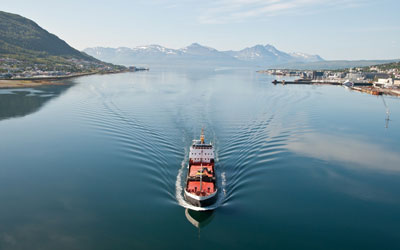
Large releases of oil from tankers have declined from 24.5 incidents per year in the 1970s to 3.2 incidents per year in the 2000s.The improved safety is due to modern vessels and technologies and crew training – even as maritime transportation of oil and petroleum products has nearly doubled since 1970.

More than 99.99 percent of oil delivered by tankers in the U.S. over the past decade reached its destination safely.
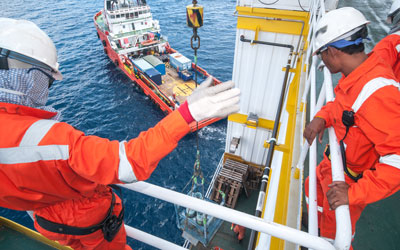
Offshore operators must have functioning Safety and Environmental Management Systems (SEMS), which are subject to independent, third-party audits and erect safety barriers that help prevent incidents that may occur from escalating.
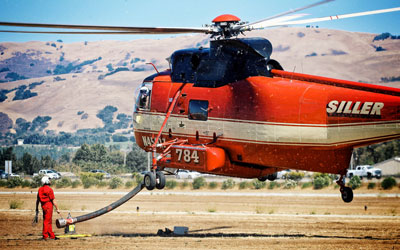
Transportation Community Awareness and Emergency Response (TRANSCAER®), is a multi-industry safety training program that helps prepare communities for potential hazardous materials incidents, by offering classroom and hands-on training, emergency planning assistance, support for community drills and more.158 The pipeline industry also hosts a free, online training program for first responders and emergency response personnel.
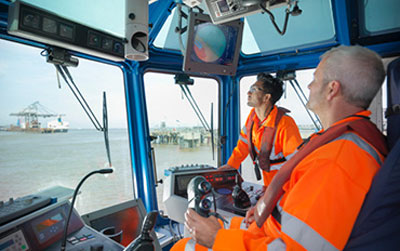
Preventing offshore incidents that could affect coastal areas is the chief objective of the Center for Offshore Safety. The Center assists offshore operators in developing a systemized approach to safety by establishing protocols and processes to prevent incidents and through training, leadership and auditable programs.
Policy Focus
ENERGY POLICY MATTERS. Sound policies that foster investment allow the United States to fully harness its natural gas and oil potential – keeping America strong at home and around the world.
Sustaining Our Ability To Power Past Impossible
The right policies will sustain and grow the ongoing energy renaissance, making America more secure and prosperous now and in the future. It can be a future where we protect the environment; innovate with new, advanced technologies; grow economically; and manufacture products for everyday living. American energy will continue to enhance the fabric of our communities.
Americans look to the industry and our nation’s leaders to get energy policy right today for a brighter future.
They want a country that is second to none in energy production, energy security and economic growth while protecting the environment – all of which lay a foundation for future Americans to power past the challenges we consider impossible today.
The following pages outline energy policies and outcomes that that are critically important to keep America powering past impossible:
Expand Access To Offshore, Onshore Reserves
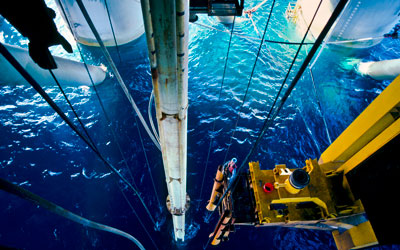
Increasing access to federal natural gas and oil reserves, offshore and onshore, is vital to strengthening the economy and our national security, now and in the future. New offshore access could add production of more than a million barrels of oil equivalent per day (see also reference and reference) and generate hundreds of thousands of good-paying jobs and billions of dollars in government revenues. This includes the Eastern Gulf of Mexico and areas off the Atlantic coast and the Alaskan Arctic. Access to federal onshore acreages also should be increased, supported by land management and regulatory policies that foster more natural gas and oil production. Expanded access to American energy will help keep our country secure and prosperous, and a global energy superpower.
Streamline Permitting For Infrastructure

The U.S. needs additional energy infrastructure to connect consumers all across the country with the benefits of surging natural gas and oil production. Increasing certainty, transparency and efficiency in permitting processes for pipelines, gathering lines, storage tanks, compressor stations, ports and other infrastructure will help ensure that American families, businesses and manufacturers fully realize the benefits of the country’s energy abundance. At the same time, building new infrastructure and/or expanding existing facilities could create millions of jobs across a range of industries in all 50 states – good-paying, middle class-sustaining jobs.
Sustain Environmental Progress
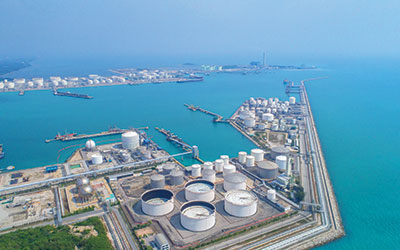
The United States leads the world in reducing carbon emissions, and methane emissions from natural gas systems have fallen – even as the U.S. leads the world in producing natural gas, oil and refined products. Meanwhile, ozone concentrations in the air have fallen 17 percent since 2000 with help from increased use of domestic natural gas. The U.S. has proved that significant progress in these areas can occur without sacrificing energy and economic growth.
A commonsense regulatory approach that acknowledges the industry’s technologies and innovations have contributed significantly to reducing emissions and key air pollutants is needed – and that industry, through initiatives such as The Environmental Partnership, is committed to continuous environmental progress through collaboration.
Repeal Or Reform The Renewable Fuels Standard
The federal Renewable Fuel Standard (RFS) is a broken program that should be repealed or significantly reformed. The program’s original objective of lowering crude oil imports is being accomplished by increased domestic oil production. The program’s mandates for increasing ethanol use in the nation’s fuel supply could potentially damage vehicle engines as well as consumer items. About three out of four vehicles on the road today were not designed to use higher ethanol blends like E15. The Congressional Budget Office found that forcing ethanol volumes to statutory levels dictated by the RFS could cost consumers up to an additional 30 cents per gallon for standard E10 gasoline and up to an additional 45 cents per gallon for petroleum diesel. Over more than a decade, another of the RFS’ chief goals – establishing a viable commercial market for cellulosic biofuels – has not been achieved.
Short of repealing the RFS, the program should be reformed to align it with market realities, protect consumers and preserve a place in the fuel supply for ethanol-free fuel for which there is important customer demand.
Pro-Growth Tax Reform

America’s natural gas and oil industry is a major driver of the economy, supporting over 10 million jobs, investing billions each year in capital projects and generating about $70 million a day in government revenues. The right pro-growth tax policies can accelerate the economic investments that generate all those benefits, and create more jobs while helping to provide affordable energy for consumers. Maintaining provisions that enable cost-recovery and implementing a new and more competitive international taxation system can help strengthen the U.S. energy renaissance and ensure continued benefits for American consumers and businesses.
Ensure Electricity Grid Reliability And Resilience

Abundant, affordable natural gas was the top fuel for U.S. electricity generation in 2016 and was on track to be the leader again in 2017. Natural gas-fueled generation defines reliability, furnishing dispatchability, ramp rates, frequency response and other important attributes that help ensure the health of the electricity grid.
The resilience of the modern natural gas system was demonstrated during last year’s hurricanes, with the system’s geographic diversity keeping supplies flowing. Markets, not government interventions should determine energy sources for power generation because they reward innovation and work toward lower prices and benefit consumers.
Grow U.S. Global Energy Leadership Through Energy Exports

As a growing exporter of crude oil and liquefied natural gas (LNG), the United States is able to help friends and allies abroad while strengthening its position as a global energy superpower. Energy exports boost U.S. trade, help spur domestic production and help grow the economy.
Our allies see the United States as a reliable, alternative energy supplier. In that way, supplying energy to allies supports our nation’s foreign policy goals. U.S. policy should strengthen the competitiveness of U.S. energy in the global marketplace, for example, by expediting federal approvals for LNG export facilities, allowing more U.S. natural gas to reach customers overseas.
Commonsense, Effective Regulation
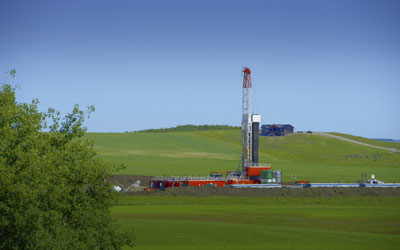
Maintaining the current, successful regulatory approach – a combination of federal and state oversight – is essential to continued natural gas and oil production that has made the United States the world’s leading producer, increasing our security and boosting our economy. The marriage of advanced hydraulic fracturing and horizontal drilling is the engine of the U.S. energy renaissance. It is safe – and well-regulated and will continue to play the major role in U.S. energy production, guided by a commonsense regulatory approach.
Modernize, Strengthen Free-Trade Agreements

Provisions in free trade agreements help ensure that U.S. companies – including those in the natural gas and oil industry – may compete on a level playing field around the globe. When they do, they win – and so does the U.S. These agreements help ensure access to foreign markets and that companies and their investments are protected from discriminatory, anti-competitive actions by foreign governments. Free trade benefits the United States by building demand for U.S. energy, which stimulates domestic production and supports jobs here at home.
Conclusion
The 2018 State of American Energy report highlights how the natural gas and oil industry powers our nation and the world past challenges, many of them thought to be impossible.
The natural gas and oil industry isn’t satisfied with today’s levels of performance, nor does it retreat from challenges others may consider impossible. The industry is about the future and consistently demonstrates that today’s impossibilities can be tomorrow’s reality. Americans look to the industry to get our nation’s energy policy right, today. They expect safe, unsurpassed energy production that makes them more secure and prosperous while protecting the environment – so Americans can power past what may be considered impossible.
This year’s report reminds all Americans of the fundamental benefits of natural gas, oil and refined products and in their daily lives. The once-in-a-generation opportunity provided by the 21st century American energy renaissance continues to strengthen our economic and national security today and is the foundation for a brighter future.
From the electricity that lights our homes, to the paint that adorns our walls, to innovative medical devices that save countless lives and more, the natural gas and oil industry is leading progress today and will do so tomorrow – capitalizing on the opportunity to build an American future characterized by energy abundance, greater selfsufficiency and security, and global leadership.
All while Powering Past Impossible.
2019 State of American Energy
On This Page:
Energy LeadershipEnergy for a Cleaner Environment
Energy for Modern Life
Energy for the Future
Policy Pathways
We Are America’s Generation Energy
Energy Leadership
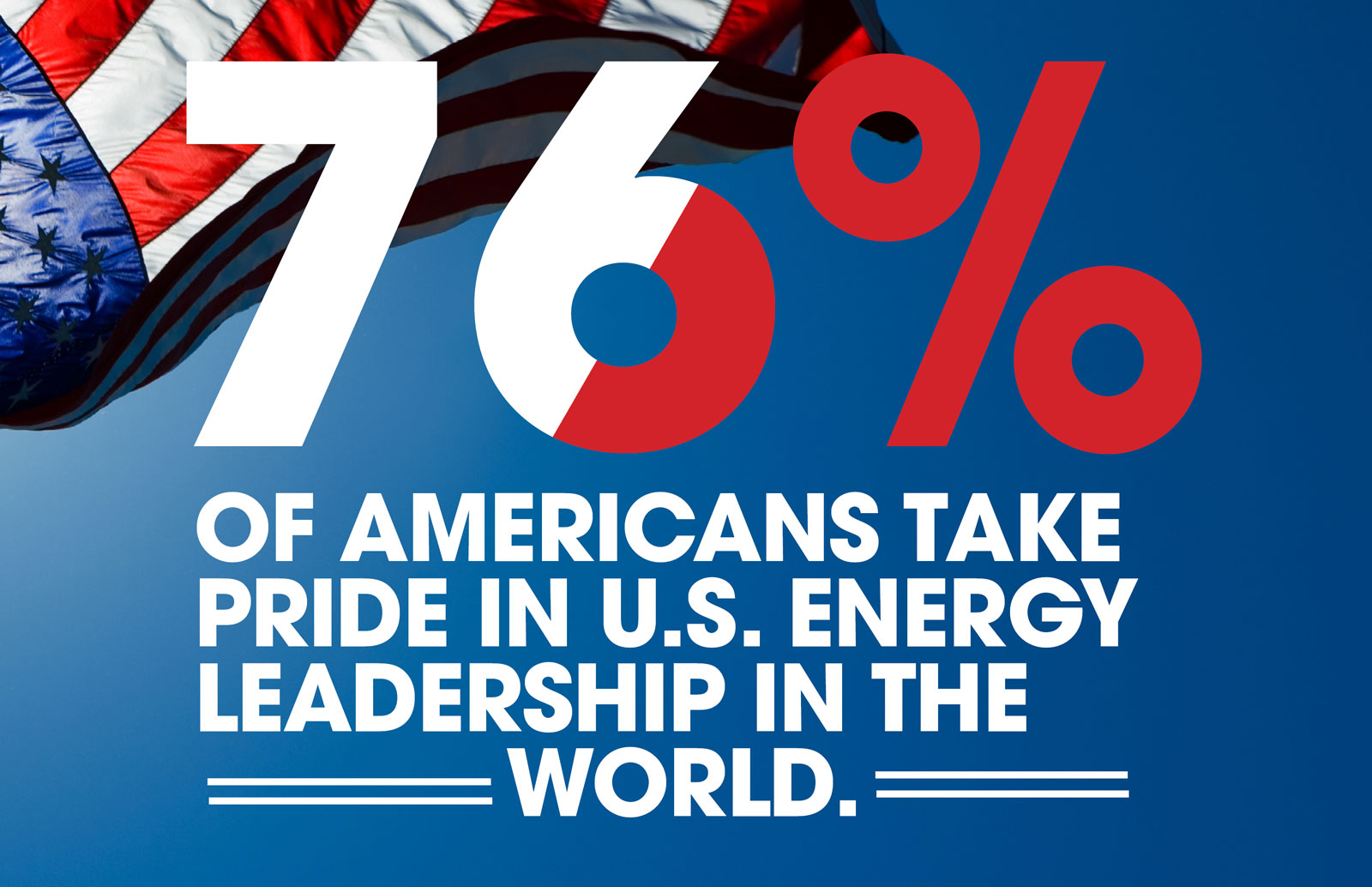
The United States is the world’s leading natural gas and oil producer and refiner. That energy leadership means America is stronger, more secure and more prosperous.
This Is Energy Leadership
Through ever-advancing technology and 21st-century innovation, the natural gas and oil industry provides the energy that has made the United States the world’s leading producer and refiner – both of which are foundational to American energy leadership in the world. Today’s natural gas and oil industry is invested in the brainpower, engineering and scientific initiatives that are developing reserves safely and efficiently so that the U.S. can fully harness the power of American energy.
“Despite the progress we made over the last five years we ought to see that move exponentially again over the next five and 10 years.”
– Ryan Lance, ConocoPhillips chairman and CEO
Lowest Net Imports Of Petroleum In More Than 50 Years
Thanks to U.S. global leadership in natural gas and oil production, petroleum imports (crude oil and refined products) are at their lowest level since the 1960s. Americans can look to the future from a position of energy strength – more self-sufficient, energy secure and able to provide leadership around the world, helping friends and deterring adversaries.
10.3 Million Jobs
The natural gas and oil industry supports 10.3 million jobs across the economy. This includes hundreds of thousands of well-paying jobs using cutting-edge technologies. Our industry is driving broad economic growth that benefits millions of Americans with greater opportunity and freedom to thrive.
World Leader In Reducing CO2
No nation on earth has reduced carbon dioxide emissions as much as the U.S. since 2005. Our CO2 emissions have fallen to their lowest level in 25 years – largely because of increased use of clean natural gas – while the rest of the world’s CO2 emissions have risen 50 percent since 1990.
Energy Leadership By The Numbers
Barrels of U.S. Oil Produced Per Day (2018 10-month average) – more than double levels a decade ago
Net U.S. petroleum imports lowered by 70% since 2005 due to domestic production
Cubic feet per day of U.S. natural gas and natural gas liquids marketed production making the U.S. the world’s top producer in 2018
Energy For A Cleaner Environment
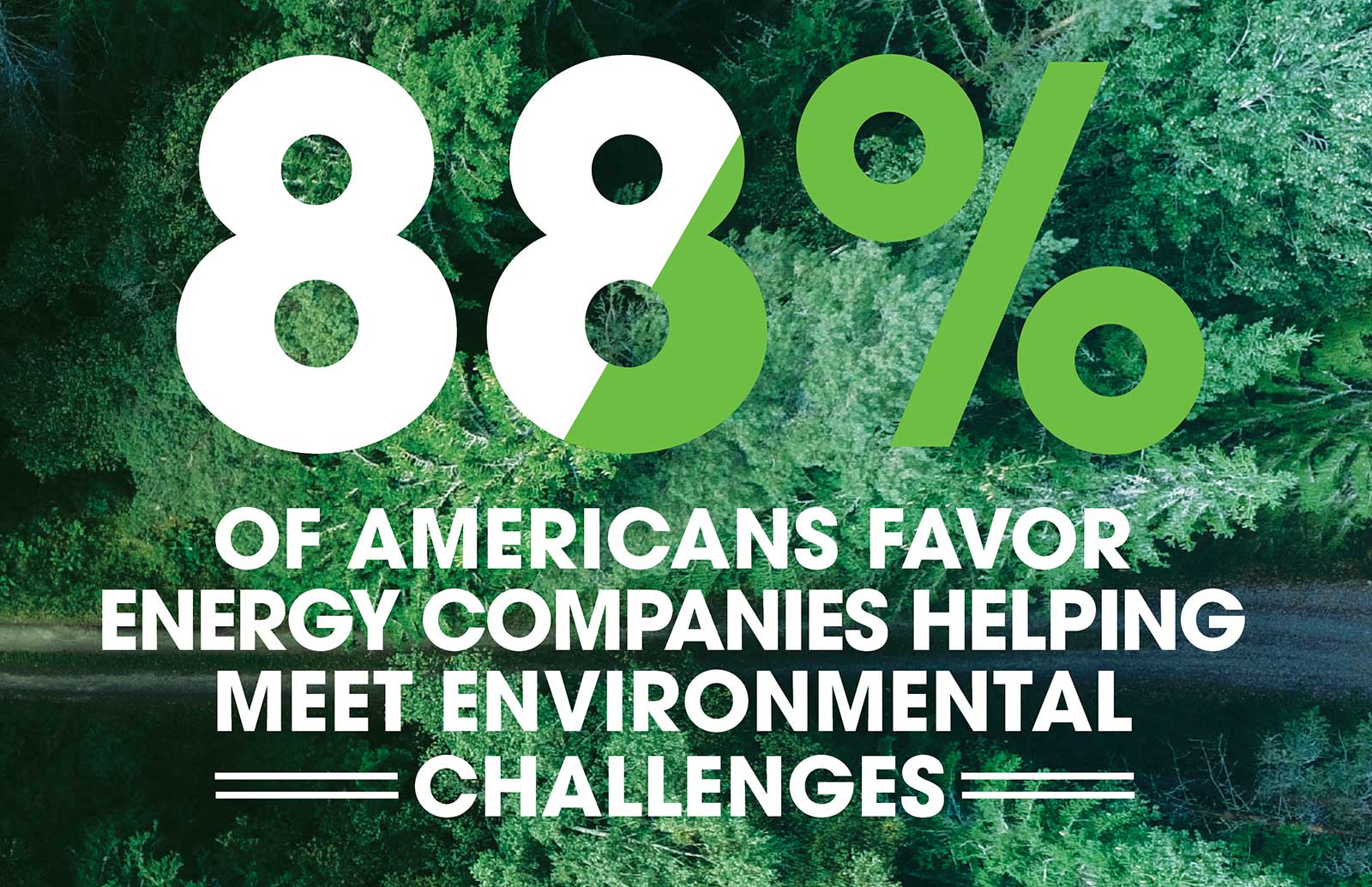
Energy is fundamental to the lives we want to live – free, safe and healthy, with broad opportunity. Delivering the natural gas and oil that powers and supports modern living means doing so with lower emissions and improved products and operations. In all of these, industry is helping lead the way.
This Is Energy For A Cleaner Environment
Cleaner operations, facilities and products – all are part of the natural gas and oil industry’s commitment to improve its environmental performance and accelerate society’s climate goals while producing the energy required by a modern economy. Developing natural gas and oil is an industrial process, yet its impacts can be managed using advanced technologies to protect the environment, our workers and the communities that host our operations.
For example, industry is highly motivated to use a variety of technologies to capture more and more methane during production that can be delivered to consumers as natural gas. Increased use of natural gas to fuel power generation is the No. 1 reason U.S. emissions of carbon dioxide have fallen to levels not seen in more than two decades.
“ We’re commited to doing our part.”
– Vicki Hollub, Occidental Petroleum President and CEO
99% Fewer Vehicle Emissions
U.S. refiners are producing cleaner gasoline and diesel fuels which, coupled with advanced vehicle technologies, means today’s new cars, SUVs and pickup trucks are about 99 percent cleaner for common pollutants than vehicles in 1970. Cleaner fuels played a significant role in a 73 percent reduction of the six Clean Air Act Criteria Air Pollutants between 1970 and 2017 – even as vehicle miles traveled increased 189 percent.
Cleanest Air In More Than A Decade
The increased use of clean natural gas in generating the nation’s electricity – in many cases replacing coal-fired generation – is the leading reason the air Americans breathe is cleaner today than it has been since the the turn of the century.
Methane Emissions By Natural Gas Systems Down 16%
Technologies – including more advanced leak detection equipment – helped decrease methane emissions from natural gas systems 16 percent since 1990 while natural gas production increased more than 50 percent. The Environmental Partnership is helping galvanize the continuing effort to reduce methane emissions through learnings and collaboration.
A Cleaner Environment By The Numbers
Natural gas is the primary reason the U.S. leads the world in cutting carbon dioxide emissions while global emissions are up
The reduction in U.S. air pollutants between 1970 and 2016, thanks in large part to cleaner fuels and more efficient engines
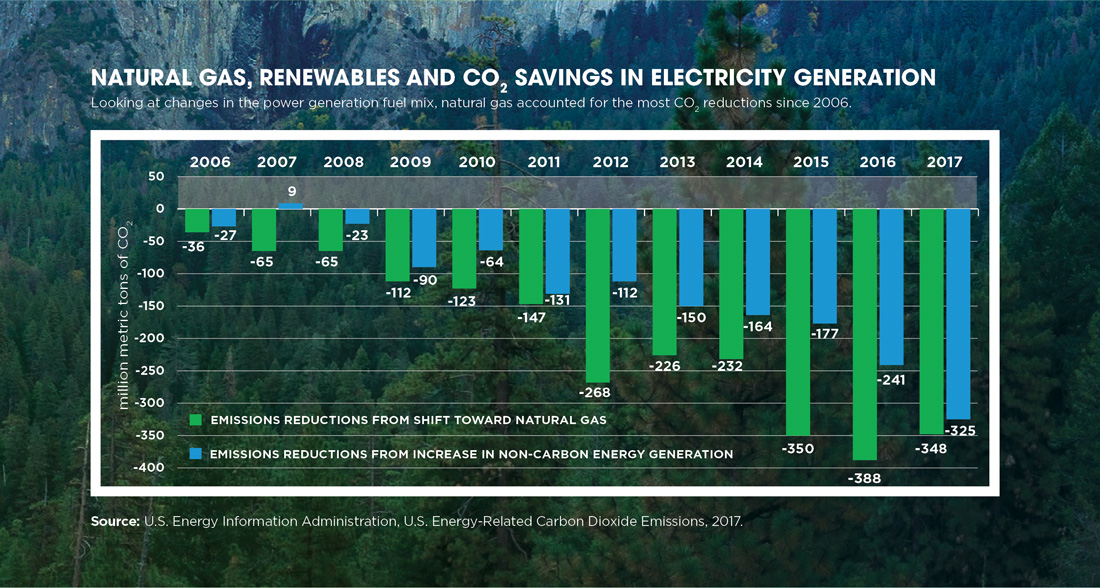
Energy For Modern Life
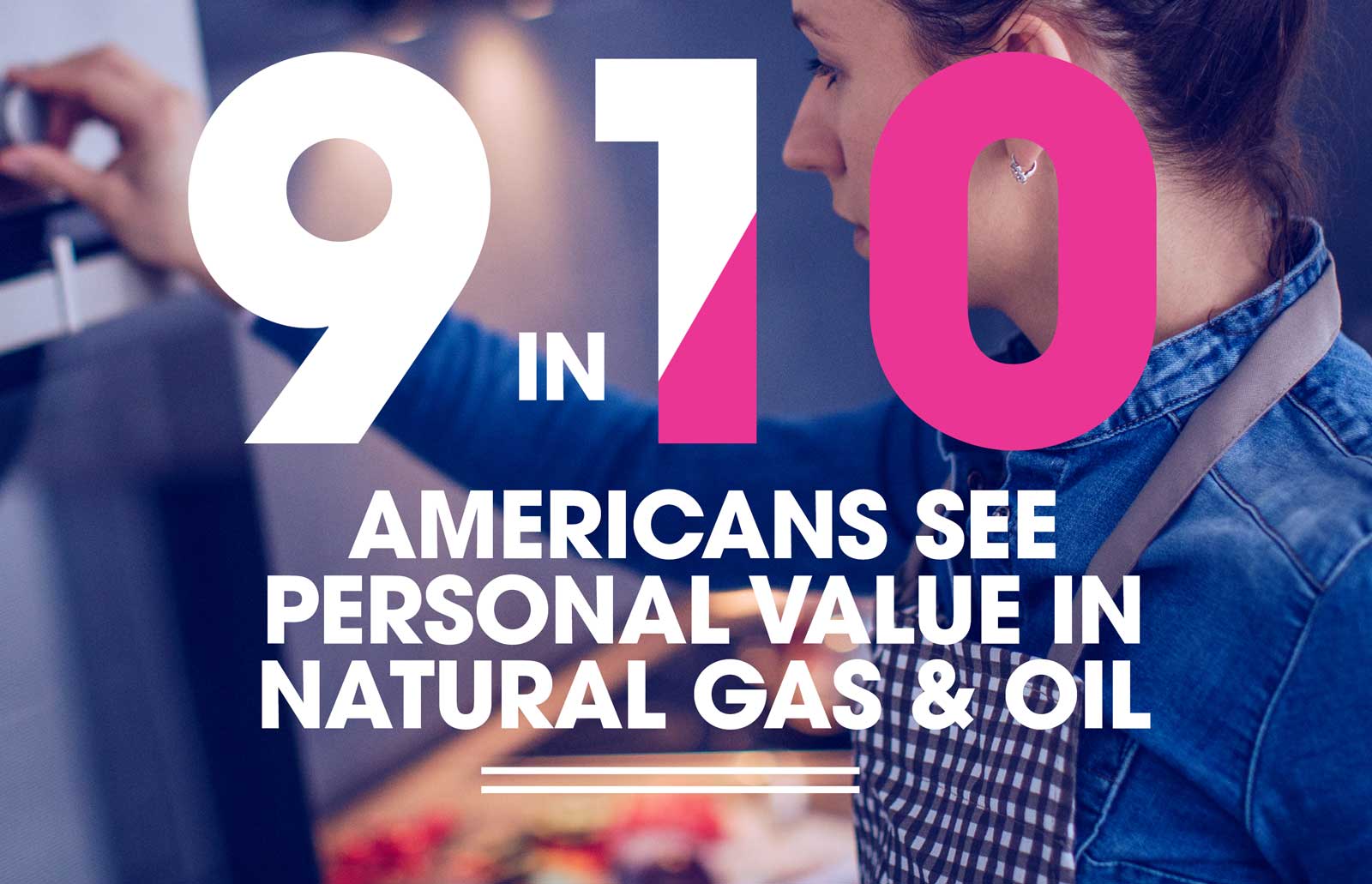
Natural gas and oil are integral in all parts of our modern lives – every hour, every day. They power and support our transportation and 21st-century electricity grid while making possible so many products that make life easier, healthier and safer.
This Is Energy For Modern Life
America’s energy abundance has produced lower energy costs for consumers and increased household disposable income. The reliability and availability of natural gas allows it to be the essential partner for the grid integration of intermittent renewable energies such as wind and solar.
Our industry is constantly working to develop cleaner fuels for the transportation sector of today and tomorrow. Meanwhile, data-assisted, technologically advanced well construction is safely unlocking vast deposits of natural gas and oil with an ever-smaller footprint.
“Energy underpins modern society.”
– Darren Woods, ExxonMobil Chairman and CEO
68% Of U.S. Energy From Natural Gas & Oil
Natural gas and oil provide power that is essential in Americans’ daily lives. Natural gas heats homes, prepares meals and fuels generation of a third of our electricity. Oil powers transportation, ensuring freedom of movement and supporting the broader economy. No other energy source can match natural gas and oil for reliability and consistency across a nation as large as the United States.
32% Of U.S. Electricity From Natural Gas
Natural gas is the leading fuel for U.S. electricity generation because it is abundant, affordable and reliable. Clean natural gas furnishes many attributes needed for a healthy electricity grid – quick ramp-up ability and capable of cycling on and off rapidly to meet changing levels of load due to increasing use of variable renewable energy on the grid. Natural gas long has provided reliable and continuous supplies to customers – including under adverse conditions.
The Products We Use – From A-Z
Natural gas and oil are present in virtually everything that makes modern life possible – as the building blocks for products and components associated with health care, clean water, education, entertainment, communications, art, agriculture and more – powering and supporting all of us.
Modern Life By The Numbers
To states, communities and American Indian tribes for education, infrastructure, conservation and other projects – from revenues generated by energy and minerals production in federal areas
Of U.S. power estimated to come from natural gas in 2040 in EIA’s high resource/technology case
Energy For The Future
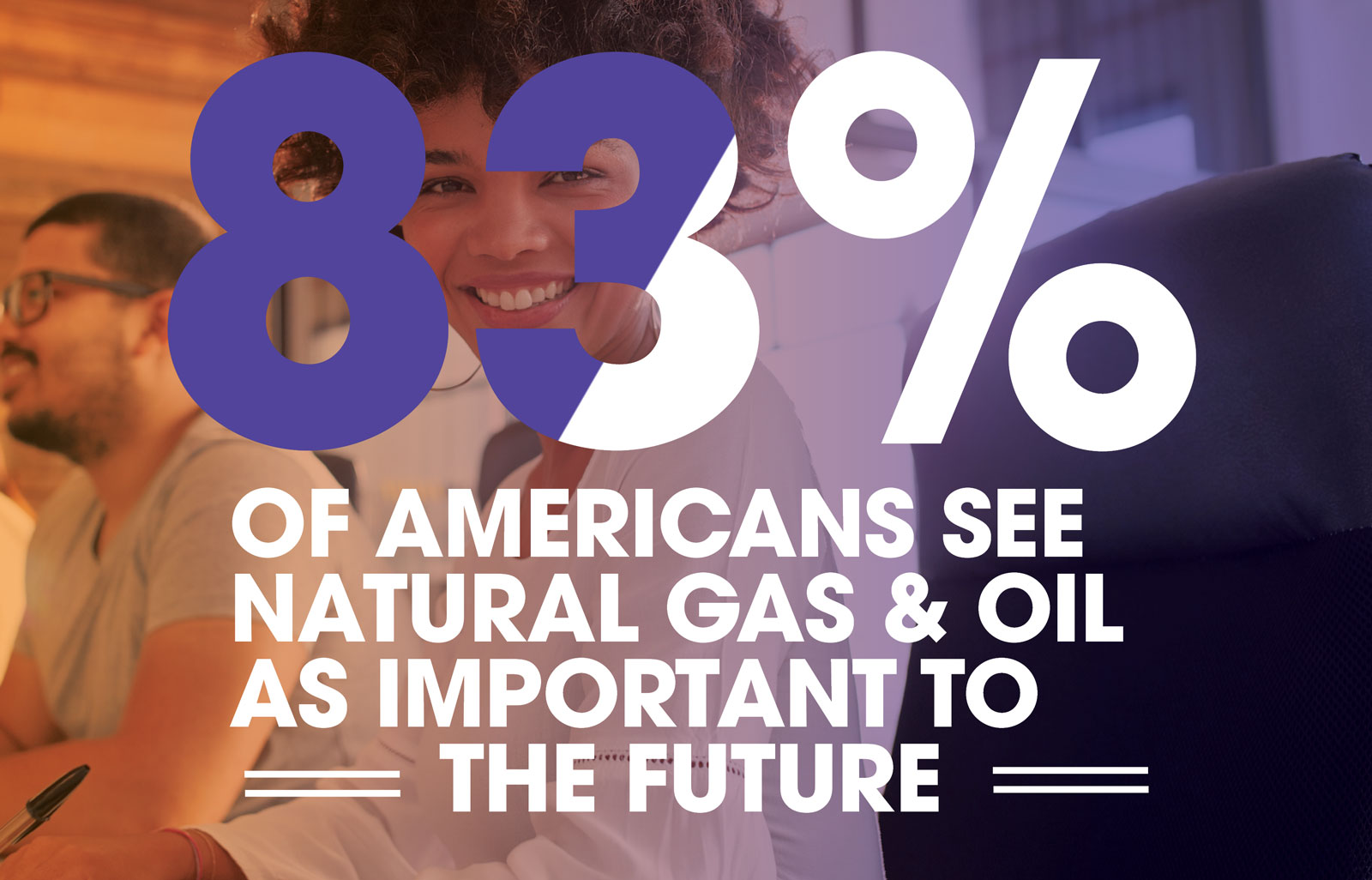
The future belongs to those who have access to energy – secure, abundant energy. Natural gas and oil are the leading energies to grow our economy and to help keep our country safe, today and tomorrow.
Our well-being as a society is directly linked to the energy to grow, invent and meet challenges of all kinds.
This Is Energy For The Future
The natural gas and oil industry is a leader in using advanced technologies, helping the nation capitalize on its domestic energy abundance – even as the country looks to an all-of-the-above energy future in which natural gas and oil partner with renewables.
Natural gas and oil are unsurpassed in the attributes that power a modern society, including portability and reliability. This is why energy forecasters project an energy future in which natural gas and oil continue to be leaders, here at home and around the world.
With the right policies, natural gas and oil can continue to power a modern economy while also providing economic lift of its own by creating jobs that pay well, capital investment and associated spending by companies and their employees throughout the economy. At the same time, industry is focused on its workforce of the future, creating more career opportunities for women, minorities and Millennials. The natural gas and oil industry values diverse perspectives and contributions as key to driving continued innovation in the energy space.
“Technology is really the heart and soul of our business, and really our industry.” – Jeff Miller, Halliburton CEO
Petroleum – The Best Energy There Is
Oil is energy rich and portable – valuable qualities for powering a modern economy. Natural gas and oil are adaptable and integral as feedstocks for an array of other products and technologies, ensuring their vital role for years to come.
2040: 66.6% Of U.S. Energy From Natural Gas & Oil
The U.S. Energy Information Administration, the International Energy Agency and other agencies project that natural gas and oil – today’s leading fuels at home and around the world – will be the leading fuels for decades to come.
2035: Well Over A Million More Jobs Supported
Pro-development policies could increase the total number of U.S. jobs supported by natural gas and oil by 1 million in 2025 and more than 2.3 million in 2035. Industry drives broad economic growth through its own jobs, its spending in associated sectors and through the personal spending of industry workers.
Energy For The Future By The Numbers
U.S. jobs supported by natural gas and oil
in private natural gas & oil infrastructure investment is possible out to 2035
In 2017, jobs in natural gas and oil extraction had an average salary of $165,670 nearly 3x the national average of $55,330
Policy Pathways
The natural gas and oil industry is focused on increasing energy production while also accelerating efforts to reduce emissions associated with a process that’s industrial in nature. To those ends, industry works with state and federal governments and other authorities to develop effective energy policies and regulations that support safe and responsible natural gas and oil production – to benefit the economy, U.S. security, the environment and the American people.
Energy policy must be forward-looking and help harness vast U.S. natural gas and oil reserves. Smart and effective regulation must include clear, common sense rules that consider industry’s innovation, advanced technologies and experience, as well as its demonstrated commitment to setting useful standards for operations, equipment and workers. All of these have strengthened industry’s safety culture.
The following pages describe the pathways to sound energy policy, smarter and more effective regulation of industry operations, onshore and offshore – all for managing the safe energy development America needs today and well into the future.
Expand Offshore And Onshore Access

- 94% of offshore federal acreage is off limits to development
- The United States is the World’s No.1 producer of natural gas and oil
The federal government should implement a robust, strategic offshore natural gas and oil leasing program to lay the foundation for critical production that will underpin America’s energy security for decades to come, while streamlining review and permitting processes to facilitate onshore development. Increasing access to the nation’s natural gas and oil reserves is vital to meeting the country’s energy needs. Offshore natural gas and oil reserves can take a decade or more to develop, so access now will help secure continued growth in the future. Expanded access increases production that promotes economic growth, generating hundreds of thousands of well-paying jobs and billions of dollars in revenues to governments.
Accelerate Emissions Reductions And Climate Progress

- 75% of Americans support the role natural gas is playing in reducing greenhouse gas emissions.
The natural gas and oil industry continues to address the significant risks of climate change – while also producing, delivering and refining natural gas and oil to power a growing economy. The United States has shown that climate and environmental progress occurs simultaneously with a growing economy and increased energy production.
The increased use of natural gas, cleaner fuels and new, efficient technologies have enabled the United States to lead the world in lowering emissions of carbon dioxide – even as these emissions have increased 50 percent elsewhere around the globe since 1990. Progress in reducing emissions can continue with a common sense approach that acknowledges the contributions made by advanced industry technologies, innovations and initiatives such as The Environmental Partnership.
The partnership includes more than 50 natural gas and oil companies that are focused on accelerating reductions in methane emissions through: shared learning about the latest industry innovations and best practices; working together to achieve improved environmental performance; and taking action with specific programs, based on EPA emissions data, that use proven, cost-effective technologies to further reduce emissions of methane and volatile organic compounds.
Build More Energy Infrastructure

- Promoting energy infrastructure across the nation could support 1 million jobs per year through 2035
- $1.89 trillion could be added to the U.S. economy between 2017 and 2035
- 84% of Americans support increased development of the country’s energy infrastructure.
U.S. energy infrastructure is an arterial network of pipelines, rail systems, storage tanks, export terminals, ports and waterways that delivers natural gas and oil from production zones to refining and processing centers, and then to consumers.
The U.S. pipeline network spans 2.7 million miles, yet some parts of the country remain under-served. So new or expanded capacity is needed to ensure that Americans in all regions may benefit from the nation’s natural gas and oil wealth.
Infrastructure development – including the development and maintenance of rail and marine infrastructure – supports good jobs, economic growth and U.S. security. Increasing efficiency, transparency and the certainty in federal permitting is important to align needed oversight with responsible and timely action on needed projects.
Ensure Fair Access To Power Markets For Natural Gas

- Natural gas is the leading fuel source of U.S. electricity
Markets, not government interventions, should determine energy sources for power generation. They reward innovation, work toward lower prices, reduce emissions in the power sector and benefit consumers. Because of natural gas’ abundance and flexibility, it is increasingly the fuel of choice for generating electricity. Markets should be allowed to function freely, without government putting its thumb on the scales. The increased use of natural gas has enhanced the reliability of the power system overall. Natural gas’ resilience has been demonstrated in the face of extreme weather events and other direct impacts. Clean natural gas is responsible for about 60 percent of the reductions in carbon dioxide emissions that have resulted from changes in the power sector’s fuel mix since 2005.
 Source: U.S. Energy Information Administration.
Source: U.S. Energy Information Administration.
Open Global Markets For U.S. Natural Gas & Oil Exports

- Record U.S. liquid petroleum exports totaled 7.8 million barrels per day in June/July 2018
- Record U.S. natural gas exports totaled 10 billion cubic feet per day in August 2018
As the world leader in the production and processing of natural gas and oil, the United States can meet the needs of a growing domestic economy and also supply energy to friends and allies around the globe. Thanks to surging natural gas and oil production here at home, the U.S. is a significant exporter of both crude oil and liquefied natural gas (LNG).
These exports strengthen America’s standing as a world energy superpower and are creating opportunities for the U.S. to use its energy for good around the world. Going forward, policies should support adding more LNG export capacity, which can help meet expected growth in global demand for natural gas. Policies also should facilitate increased U.S. energy exports – to boost trade, help spur domestic production and grow the economy.
Modernize And Strengthen Free Trade Agreements

- An integrated U.S.-Mexico-Canada energy market helps keep energy affordable for Americans
Free trade agreements – eliminating tariffs, creating energy trading zones and protecting U.S. energy investments in other countries – help open markets for American natural gas and oil, boosting production and job growth in this country. Provisions in free trade agreements help create a level playing field for U.S. energy companies around the world, which is fundamental to the competitiveness of U.S. energy.
Congress should ratify the proposed U.S.-Mexico-Canada Agreement (USMCA) to help strengthen energy trading relationships between the three nations – which, under NAFTA (preceding USMCA) saw Canada and Mexico become the leading export markets for U.S. crude oil and a number of refined products including kerosene-type jet fuel and finished motor gasoline.
 NOTE: Graphic is not scaled for energy content across different energy types
NOTE: Graphic is not scaled for energy content across different energy types
Sunset The Ethanol Mandate

- 74% of Americans agree that government regulation can increase the cost of gasoline for consumers
- Nearly 70% of vehicles on the road today are not designed to use E15
- 71% of Americans are concerned about government requirements that would increase ethanol in gasoline
The Renewable Fuel Standard (RFS) is outdated and broken, and its ethanol mandates can put consumers at risk. The program should be ended or significantly overhauled. In the interim, EPA should reduce the ethanol volumes required under the program.
The RFS’ objective of reducing crude oil imports has been made obsolete by surging domestic oil production. Its goal of launching commercially viable cellulosic biofuel production has not materialized. RFS mandates for increasing ethanol use in the nation’s fuel supply could impact consumers.
Gasoline demand in 2018 was 14 percent lower than was projected when the RFS was implemented more than a decade ago, which means there are fewer gallons available in which to blend ethanol. 33 As a result, more higher ethanol fuels, such as E15, could be forced into the fuel supply, potentially damaging vehicle engines.
Three out of four vehicles on the road today weren’t designed to use E15, based on manufacturers’ manuals. In addition, fuels with higher ethanol content can damage marine engines, motorcycle engines and outdoor power equipment.
Support Industry Cybersecurity Actions

Cybersecurity of the nation’s critical infrastructure is a top priority and industry takes seriously the responsibility to protect it, provide reliable energy for society and safeguard the public and environment. The cyber threats faced by industry are not unique to pipelines; they are prevalent across the energy system. Our companies recognize these threats and utilize a multidimensional approach to cybersecurity that incorporates high-level oversight and voluntary mechanisms including proven frameworks and public-private collaboration.
This performance-based approach, rather than prescriptive standards or regulations, is the best way to bolster the cybersecurity of industry companies and critical infrastructure. Government must recognize the limits of rigid mandates and guard against regulatory overreach and the imposition of rules that – in the world of information technology and cyber defense – quickly become obsolete as threats adapt and evolve.
“Our companies are providing the leadership, proactive solutions and ongoing coordination with federal agencies to help prevent future cyberattacks.”
– Mike Sommers, API President & CEO
We Are America’s Generation Energy
The people of the natural gas and oil industry are leaders in America’s Generation Energy. They live from one end of the U.S. to the other. We interviewed 13 of them for this report, to hear them talk about the importance of domestic energy, technology, science and an awareness that their work meets challenges much larger than themselves.

Hess’ Stacey Nachbaur is on point in the digital oil field.
Read More >>
Schlumberger’s Drew Pomerantz is helping industry capture methane.
Read More >>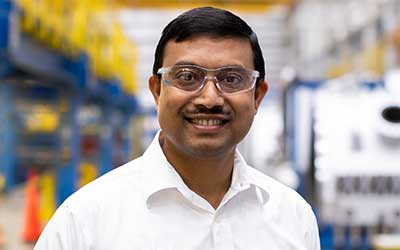
Siemens’ Pratyush Nag is developing the latest turbine technology to amplify natural gas’ role in powering Americans’ lives.
Read More >>
Jennifer Osterhaus of BP is using technology to responsibly harness America’s deep water energy.
Read More >>
Data and technology help Devon Energy’s Alex Biholar pinpoint America’s energy treasures.
Read More >>
Through advanced cybersecurity, Chevron’s Marisa Ruffolo protects vital energy infrastructure.
Read More >>
Alyeska Pipeline’s Klint VanWingerden and cutting edge technologies keep the Trans Alaska flowing.
Read More >>
Jennifer Smith of Enbridge listens, engages and builds relationships – one handshake at a time.
Read More >>
Shell’s ‘Mac’ McLendon brings his own energy to protecting offshore workers and the environment.
Read More >>
Cheniere Energy’s Tyler Pedersen—on the frontier of exporting U.S. natural gas.
Read More >>
For ConocoPhillips’ Karen Work, Reusing Water is Key to Good Stewardship in the Permian Basin.
Read More >>
Marathon Petroleum’s Fred Walas finds art in the science of crafting fuels for today and tomorrow.
Read More >>
Mike Kerby of ExxonMobil believes technology is vital to solve energy and climate challenges.
Read More >>Maximizing U.S. Energy, Minimizing Its Footprint

Hess’ Stacey Nachbaur Is On Point In The Digital Oil Field.

Eight hockey pucks sit lined up like black buttons on the white ice, about 6 inches apart, just above the red hashmarks at one end of the rink inside the RoughRider Center in Watford City, North Dakota.
Suited out in her hockey gear, Hess’ Stacey Nachbaur eyes the closest one, gripping her stick, knees bent and skates about shoulder-width apart. The backswing of Stacey’s slapshot brings the stick’s blade above her head, and then she whips it through the puck, driving the shot toward the net. After the first one she cranks the others rapid-fire – the report of each shot echoing across the mostly vacant ice surface.
The same competitive fire that drove Stacey as an elite athlete during her college hockey career is an important part of her approach to managing Hess’ natural gas and oil production from thousands of wells across hundreds of miles throughout northern North Dakota. The leverage she applies to her booming slapshot serves as a metaphor for the leveraging of people, data and technology to drive timely, efficient energy production.
Stacey is part of America’s Generation Energy: integrating advanced technology and teamwork to develop the energy resources that power the U.S. economy and Americans’ modern lifestyles while also reducing her company’s physical and environmental footprint.
She and her skilled team of engineers, operators and technicians represent a 21st-century natural gas and oil industry, whose production has made the United States the world’s leading natural gas and oil nation, created jobs and prosperity from one coast to the other and powered a U.S. manufacturing renaissance. It’s technology-driven, smarter, safer and increasingly more efficient.
“We’re working in the digital oil field,” she says. “From the surface of the earth to underneath, technology is integral to protecting and enhancing production. It keeps all aspects of operation interconnected to improve safety, reduce our footprint and increase our productivity, and we have to be equipped to leverage the best of high-tech advancements to maintain our competitiveness in the global market.”
Like many in the industry, Stacey sees the evolution of a modern natural gas and oil industry. More than a decade ago, industry combined advanced hydraulic fracturing and horizontal drilling to launch the U.S. energy revolution, typified by surging production using less and less surface space – reduced by as much as 90 percent compared to years ago.
Last year, U.S. crude oil production was on track to reach 10.9 million barrels per day – more than doubling output levels from the previous decade, according to the U.S. Energy Information Administration.35 EIA also projected that the U.S. would see record year-end dry natural gas production of 83.3 billion cubic feet per day and natural gas liquids production of 4.3 million barrels per day.
The Bakken shale play that covers the northwest quadrant of North Dakota and the northeast corner of Montana is where much of this production is happening. When Stacey joined Hess in 2010, the company produced 15,000 barrels of oil equivalent per day in the Bakken. Today, that number is closer to 118,000 barrels per day.
“You can see anywhere from 12 to 20 wells on a single pad today,” she says. “We’re increasing production while reducing the environmental footprint of operations.”
Stacey’s team uses exception-based surveillance technologies to maximize efficiency and safety. They analyze automated data-collection to assess pressures, flow rates, temperatures and other information from the field. These systems combine data points with production accounting information and enterprise-wide analytics to create signals that keep teams aware of the performance of every well. This enables her team to identify and prioritize wells for checks by workers – to better problem solve and optimize performance.
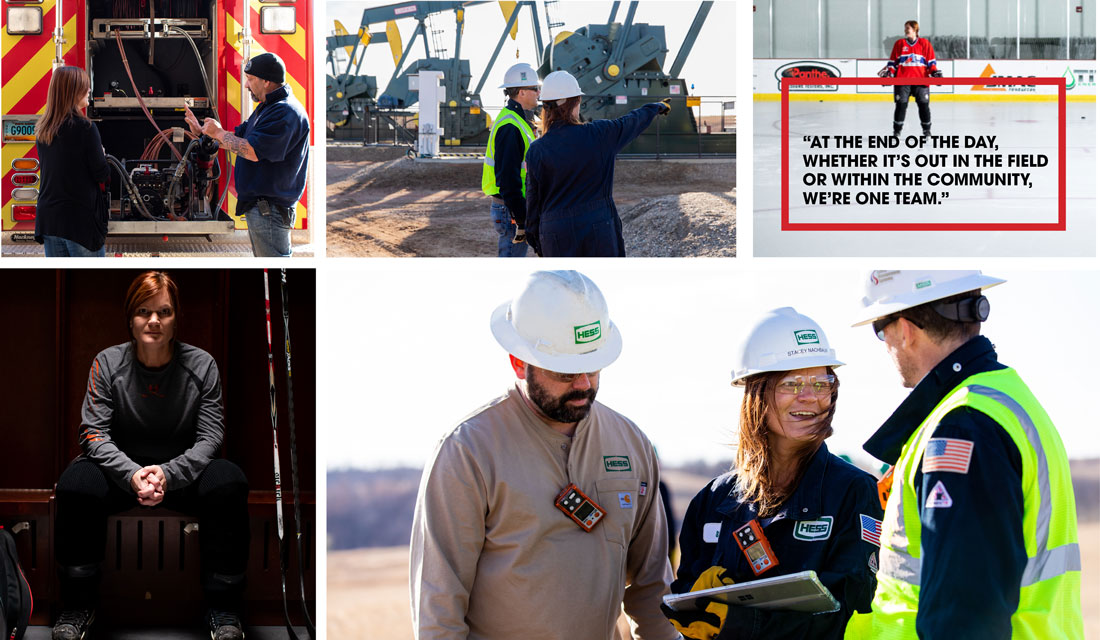
Technology also has revolutionized drilling. “Walking rigs” – fully assembled drill rigs that can move from one well to the next without being disassembled in between – let operators complete multi-well pads more quickly.
Stacey says the continuous integration of new technologies across the industry requires professionals to be nimble and flexible. A willingness to listen, learn and adapt for improvement is also why Hess is a trusted energy partner within the communities in which it operates. In addition to managing production operations, Stacey also serves on the company’s community liaison team within the region. In 2018 alone, Hess supported over 40 local community organizations across North Dakota and in the past five years has invested approximately $30 million on community initiatives to strengthen education, workforce development, health and human services as well as support disaster relief.
“We’re very much a part of the communities and we’re committed to donating our time and services whenever we can. These are the communities where our employees live. It’s where we see our friends and neighbors. We’re producing safe and reliable energy. We’re creating jobs and striving to improve the overall quality of life for everyone in some way.”
And it’s where Stacey gets to enjoy a pick-up hockey game every now and then. It takes her back to some of her most memorable times of her life on the ice – playing for the women’s team in the Canada Winter Games and at Brown University before completing her eligibility and earning her degree in engineering at the University of Regina in Saskatchewan, Canada.
For Stacey, producing safe and affordable energy for the U.S. and improving the lives of people throughout North Dakota and beyond is the ultimate win. “At the end of the day, whether it’s out in the field or within the community, we’re one team.”
The Science Of Emissions Reduction

Schlumberger’s Drew Pomerantz Is Helping Industry Capture Methane.

It’s the summer of 2017, and Drew Pomerantz, a principal research scientist at Schlumberger, is walking around in the 100-degree heat of San Antonio, Texas, with what he describes as a “Ghostbusters” backpack. Along with his colleagues, he is testing the latest detection technologies to help address one of the natural gas and oil industry’s most important challenges – methane leaks.
“I got into science because I was always interested in understanding why and how stuff happens,” Drew says. “Things like, why this object is a certain color, or why some molecules have a chemical reaction when they collide, and others don’t react at all.” He realized early on that he needed a way to channel that intellectual curiosity in his work. He saw that opportunity at the intersection of energy and the environment. Drew is part of America’s Generation Energy: cognizant of energy’s role in building a cleaner world; highly motivated to advance climate solutions by developing and implementing cutting-edge technologies that increasingly capture more methane, the primary component of natural gas. Today he is a Ph.D. chemist at the Schlumberger-Doll research center in Boston, Massachusetts. One of his main jobs is to figure out how the industry can better detect and contain methane emissions during natural gas and oil production.
Methane emissions from natural gas exploration through distribution declined 16.2 percent from 1990 to 2016 even as natural gas production increased by more than 50 percent during the same time frame. Thanks to increased use of natural gas to fuel electricity generation, U.S. carbon dioxide emissions have fallen to 25-year lows.
Even so, Drew says the research he is doing can drive those numbers even lower in the near term. Indeed, lowering methane emissions is one of the many ways the industry is exploring zero- and low-carbon technologies.
“In order for natural gas to fulfill its societal role as a primary fuel source today, and a long-term partner to more intermittent renewable energy, we must reduce the environmental footprint caused by methane leaks,” he says.
It’s this truth that led Drew, his fellow scientists, and partners at the Environmental Defense Fund to the dry plains of Texas. His team had spent the previous two years exploring the hundreds of methane detection technologies being produced by entrepreneurs, academics and private corporations. They evaluated the business case and specifications for each and then invited the top 15 technologies out for a field test.
During that week, the Southwest Research Institute created a methane “scavenger hunt” for the scientists, allowing them to experience the full capabilities of each system. The main purpose of these technologies is to detect leaks during production. Recent scientific studies find that more than half of the industry’s methane leaks occur during production.
Today, well sites are often tested manually by specialized work crews that travel from site to site, often in remote locations. Yet, Drew points out that, for locations that are inspected regularly, about 90 percent of the time a crew will check a well pad and find that nothing needs to be addressed. A better idea is to use automated technologies to pinpoint issues so that crews go only where there’s a known problem. Drew believes the new technologies will be more efficient, saving time and other resources while reducing emissions even further.
“These sensors under development range from a couple of bucks to millions of dollars and everything in between,” he says. “However, exploring all of these technologies is important because there is no one-size-fits-all

Drew’s team is evaluating on-site sensors, sensors carried by airplanes and helicopters and the use of satellite technology to aid in detection. He is also partnering with operators, academics, environmentalists and entrepreneurs.
This collaboration is important for his research and the industry. Working together to solve these challenges is a key focus for groups like The Environmental Partnership, a collection of more than 50 natural gas and oil companies committed to further reducing methane emissions and improved overall environmental performance.
To participate in the Partnership, companies must be taking active steps to detect and reduce methane emissions. The organization also emphasizes learning between companies and promotes joint efforts to find environmental solutions.
If you spend five minutes with Drew, it’s easy to believe that the solutions for better detecting methane emissions are within the reach of knowledge and technology. And, it is inspiring to see a scientist who, nearly 20 years after he first began to explore this intersection of energy and the environment, continues to ask why, how and what’s next.
“My job checks all of the boxes to keep me interested as a scientist,” he says. “I am working on compelling research and placing papers in academic journals. At the same time, the research could have an impact within the energy industry and even on the planet.”

FOCUS ON Geoscience
WPX Energy geoscientist Danielle Martin comes to the natural gas and oil industry after being raised on the East Coast – where she never imagined working in oil country. Her work involves tracking oil wells from the conception and planning stages to drilling. “I think it’s exciting – to know that you’re providing energy to the world,” Danielle says. “Oil and gas is used in so many sectors.”
She helps reservoir engineers discover the geologic intervals to be targeted and then estimates the tops of formations in the subsurface to feed back to drilling engineers.
“I think it’s exciting – to know that you’re providing energy to the world.”
– Danielle Martin, WPX Energy
“It’s all about finding the best rock,” she says. “We think about what’s actually drillable now based on economics and spacing, as well as future wells that will be drilled in the same formation.”
Danielle’s appreciation for the natural gas and oil industry has grown as her career in industry has developed. It has brought home the roles of natural gas and oil throughout modern society. “It heats your home and raises the quality of life for people everywhere.”
Smarter, Cleaner Power Generation

Siemens’ Pratyush Nag Is Developing The Latest Turbine Technology To Amplify Natural Gas’ Role In Powering Americans’ Lives.
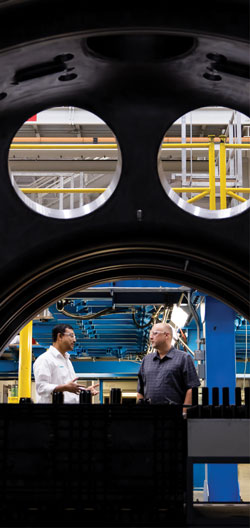
Every Sunday afternoon in Orlando, Florida, an all-girls middle school STEM team meets to work on designing and building a working car – from a mousetrap. At this age many students wouldn’t know where to start, but the award-winning trio made it to nationals last year and knows its stuff.
It helps having Pratyush Nag as coach – the father of one of the team members and the leader of natural gas turbine development at Siemens, where they know plenty about building a better mousetrap.
In the world of natural gas power generation technology, Pratyush brings the same excitement and commitment to meeting challenges and making the people around him better as he does while coaching his daughter’s STEM team.
Pratyush is part of America’s Generation Energy: thinking, creating and perfecting energy technology so that it better serves the people using it. At Siemens, it’s developing state-of-the-art electricity generation technologies fueled by natural gas. Pratyush’s team of world-class engineers collaborate 24/7 to build more efficient, economical and flexible power plants for the electricity that keeps our smartphones charged and our lights on while helping to reduce emissions by using clean natural gas as the generating fuel.
Access to reliable electricity marks a modern society, and this is underscored by America’s increasingly digitalized population. The cultural shift, which gained traction early in the 21st century, paralleled innovations in the natural gas industry – specifically, hydraulic fracturing and horizontal drilling. The marriage of these technologies made the fuel source more accessible and affordable for power generation. This is reflected in the marketplace, where natural gas increasingly is the generating fuel of choice by providers.
“Speaking from my own experience, the average residential electricity bill in the U.S. is relatively low,” Pratyush says. That’s of course because of significant American investment in fuel production, energy generation and distribution.
While affordability helped make natural gas the leading alternative to coal-fired generation, so did natural gas’ ability to reduce CO2 emissions. Thanks to its high-hydrogen and low-carbon content, natural gas can produce the same amount of energy as older, traditional generation sources, while releasing 50 to 60 percent less CO2, 80 percent less nitrogen oxides and particulate emissions, and virtually no sulfur dioxide and mercury emissions. This is one of the many reasons why Americans today are breathing cleaner air than they have in four decades.
Good is not good enough for Pratyush and his team. They wanted to create a natural gas turbine that could run more efficiently – producing more power from the same amount of fuel. So, they combined cutting-edge solutions with the best traditional technologies until they developed the H-Class gas turbine, breaking through the 60 percent efficiency mark – the energy conversion rate that’s a ratio of useful energy output from fuel input. This 60 percent efficiency barrier was a dream of engineers for several decades, during which combined cycle power plants have gradually inched from 45 percent toward 55 percent efficiency. “The air gets thinner, as we go toward the top,” he says. “It takes an incredible amount of technological advances to get to these last digits of efficiency improvements.”
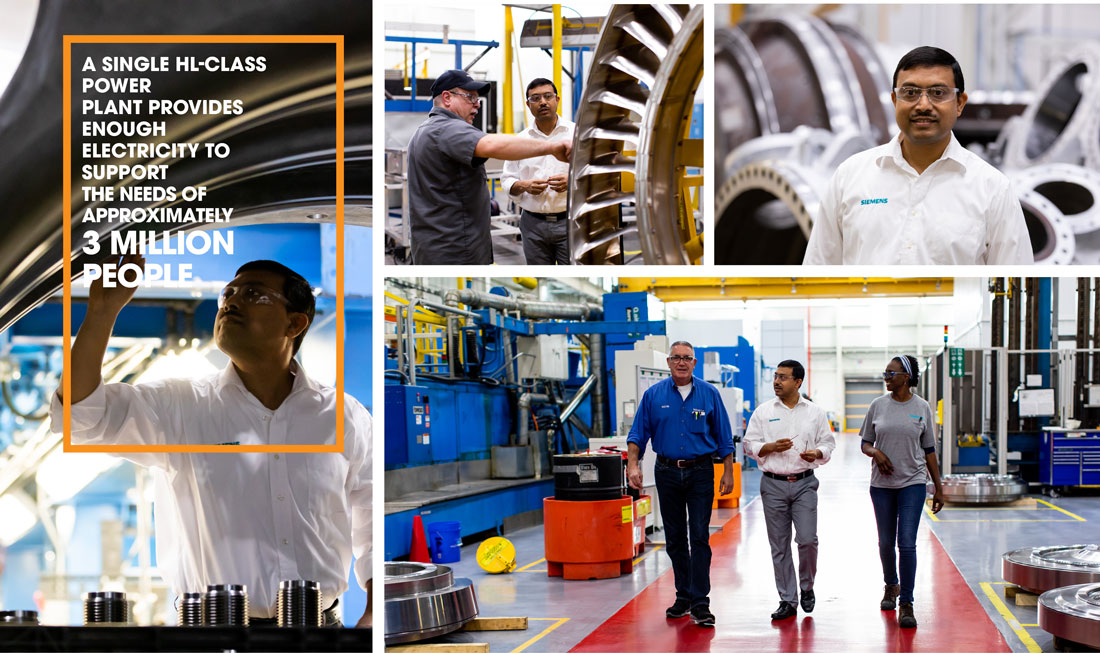
“We called it our Roger Bannister moment,” he says, referring to the legendary British miler who was the first man to run the distance in less than 4 minutes in 1954.
“Engineers had tried for decades to meet that level of efficiency, but we got there first.”
From that proven H-class technology, Pratyush’s team recently created the smarter and even more powerful HL-class of gas turbines. Operating above 63 percent efficiency, this next-generation turbine is pushing the limits of generation performance. A single HL-class combined cycle power plant provides enough electricity to support the needs of approximately 3 million people. While these single-digit gains may seem small, their impact is massive. Running more efficiently, natural gas plants can generate more electricity at lower cost. This increases the likelihood that grid operators will dispatch that plant to meet a region’s electricity demands – boosting the use of natural gas while saving money for customers. This also helps the environment, because a two percentage point efficiency improvement with a Siemens HL-class combined cycle power plant means a reduction of CO2 emissions by 63,000 tons per year – the amount of carbon captured by nearly 75,000 acres of forests in a year.
While they can generate more power, the HL-class is smaller than its predecessors. Siemens manufactures huge sections of the power-plants, and then assembles them on site, as Pratyush points out, like giant Legos. But they leave room within the machine to add innovative technologies that will help the turbine operate at high-levels throughout its life.
“In the 30-year lifecycle, we plan for three to four upgrades, so the engines can be brought back to their original performance,” he says. “Maintaining this operating efficiency gives cost benefits to the customer while remaining environmentally friendly by keeping emissions low.”
Like much of the industry, Siemens uses digital solutions to help its turbines in power plants run more efficiently. While employees carefully set parameters and monitor the turbines, a machine-learning algorithm, a digital twin, is constantly analyzing thousands of data points based on real-life conditions. Using that information, it can tune the turbines to optimize their efficiency and further reduce emissions.
The role of natural gas in advancing climate goals also is seen with renewable energies such as wind and solar. Natural gas is the essential partner to their growth, with the HL-class turbines providing flexible baseload power when the renewables are offline – rapidly ramping up to generate 400 MW of power within five minutes and keep electricity flowing to the grid.
“This product is designed to meet the changes of the market dynamics while complimenting the world’s future energy mix.” he said.
That energy mix, today and tomorrow, will include natural gas and oil, providing safe, reliable and affordable energy while taking part in advancing climate goals. And while Pratyush will never stop pushing the limits to develop the next, greatest natural gas turbine, it’s the people he works with that make it all worthwhile.
“I am absolutely delighted by the people I work with,” he says. “The technology is cool, but my passion is the people. Over the last 17 years or so I’ve recruited and developed a lot of people into different roles in the company and watched them grow, and that is my greatest reward.”
Data-Driven Offshore Efficiency And Safety
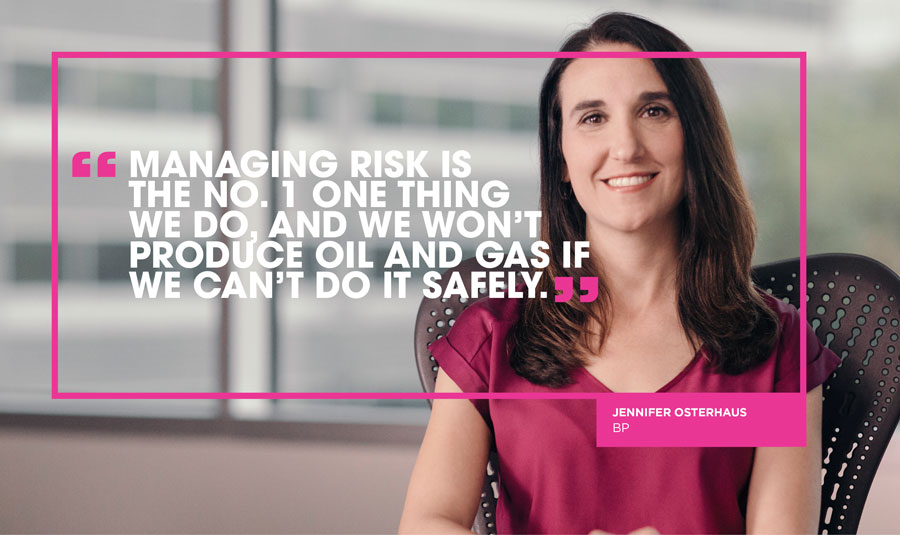
Jennifer Osterhaus Of BP Is Using Technology To Responsibly Harness America’s Deep Water Energy.

The house is quiet at 5 a.m. as Jennifer Osterhaus sips her cup of coffee and reviews the family schedule for the day. Her eldest son has a baseball game across town, her daughter has soccer practice closer to home, and there’s the daunting task of keeping the 4-year-old entertained through it all.
You don’t have to be a chemical engineer to remain imperturbable in the face of many moving parts – but it doesn’t hurt any. “It’s all about the kids when I’m not at the office, and they keep me very, very busy,” she says. “At the office” for Jennifer is leading the operations support team for BP’s Thunder Horse platform in the Gulf of Mexico, the company’s largest offshore natural gas and oil production platform. She smiles when asked which is the bigger multi-tasking challenge: juggling her active family’s schedule or managing a modern platform in the Gulf.
Thanks to technology, running an offshore natural gas and oil platform has never been more manageable. Using world-class computerized data analytics, Jennifer and her team can monitor and evaluate the “health” of Thunder Horse from BP’s headquarters in Houston. Every day they analyze millions of data points in real time, which allows them to know that the platform is operating as it should, manage efficient production and improve safety – for BP employees and the environment – and even head off potential problems before they arise.
Jennifer is part of America’s Generation Energy: adept at using the latest technologies and digital solutions to safely deliver the natural gas and oil that drive the 21st-century economy and Americans’ modern way of life. Jennifer and her industry counterparts are working smarter and more efficiently than ever before while supporting workplace safety, infrastructural integrity and environmental protection.
“The technology allows us to filter out the inconsequential data and highlight the important issues, so our engineers can take action where needed.”
Thunder Horse represents U.S. offshore development that’s integral to America’s energy security. Located 150 miles southeast of New Orleans, the platform can reach energy reservoirs more than 6,000 feet deep and can produce up to 250,000 barrels of oil and 200 million cubic feet of natural gas per day – enough energy to power every home in Miami for a month. “There’s a lot going on in a relatively small and very remote area,” she says with an engineer’s professional calm. “Keeping all of it operating safely and efficiently is a challenge, but it’s also the most rewarding part of my job.” The 300 women and men who live and work on Thunder Horse are like Jennifer’s second family. Though the platform is hundreds of miles from Houston, her team is effectively right there, able to simultaneously monitor and lead platform operations and analyze constantly changing conditions through the Plant Operations Advisor (POA) solution, a tool created in partnership with BP and Baker Hughes, a GE company (BHGE). The POA system keeps tabs on about 1,200 pieces of equipment across BP’s four platforms in the Gulf of Mexico, including Thunder Horse, to ensure that everything operates within unique parameters. The technology processes more than 155 million data points per day and alerts Jennifer’s onshore team and the engineers on the platform if a component moves outside those parameters. Then, an employee on the platform, following personal and process safety protocols, takes action to gather onsite information.

“The technology allows us to filter out the inconsequential data and highlight the important issues, so our engineers can take action where needed,” she says.
That intel is combined with data about operations from that day, as well as trends over time, from POA. Accessing this information in the past could have taken weeks, but now it can be compiled in a matter of hours. If there’s an incident, the details help Jennifer and her colleagues perform a root-cause analysis, so BP can understand what happened, why it happened and what they need to do reduce the possibility it could happen again.
“The POA system will change the game,” she says. “We spend less time managing data and more time managing the overall health of the plant.”
Applying digital solutions to natural gas and oil operations across the country has created a vast collection of data. Access to it helps fine-tune operations, ultimately driving improvements in safety, efficiency and reliability. As the amount of information grows, next-generation technologies will use it to predict events months ahead of time and alert engineers before something has a chance to occur.
BP isn’t alone in achieving these objectives. All across the industry, operators are using similar and other technologies to help them meet and often exceed regulatory benchmarks.
Overall, industry’s success in these areas is based on its ability to be advancing new innovations for specific purposes, with operational flexibility.
Seeing Through Rocks
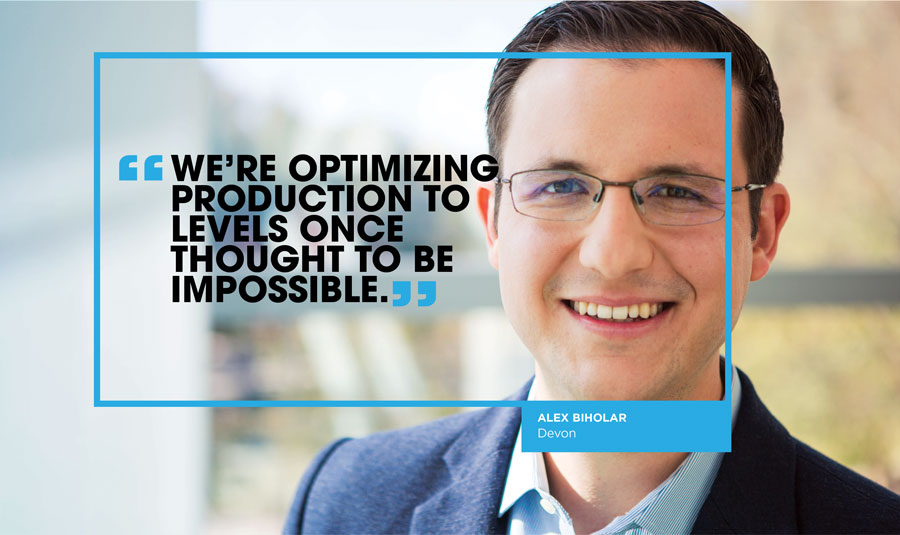
Data And Technology Help Devon Energy’s Alex Biholar Pinpoint America’s Energy Treasures.

Alex Biholar loves getting lost in the granite cliffs and natural springs found among Oklahoma’s thousands of acres of parks and wildlife refuges. Lugging his camera and tripod, he hikes for miles on any given weekend, capturing picturesque landscapes and closeups of granite-capped prominences that are more than 500 million years old.
The petroleum geophysicist for Devon Energy loves rocks and their history. He says that when you look at rock formations, you’re looking at time – time and also the energy riches that those formations create and hold: natural gas and oil. His work is a continuous quest for new discovery, capitalizing on technologies and analysis of massive amounts of data to reveal the earth’s otherwise hidden secrets.
“We’re optimizing production to levels once thought to be impossible,” Alex says. “As we continue to leverage new technologies that tell us even more about the earth’s subsurface, the opportunities within petroleum geophysics will continue to grow.”
Alex is a part of America’s Generation Energy: a modern-day treasure hunter whose discoveries help build American energy leadership, economic growth and the consumer benefits yielded by natural gas and oil and the countless products made from them.
Like other industry geoscientists, Alex uses “big data” analysis, high-tech computing and other technologies to develop a clear picture of the earth’s interior. Seismic surveys are vital in locating potential natural gas and oil reservoirs. Though seismic research has been around for decades, innovations in the technology have taken survey results from a 2-D “picture,” merely identifying the existence of underground deposits, to today’s detailed, 3-D seismic images that greatly reduce the possibility of drilling dry holes.
During the survey process, when sound waves sent into the ground hit rock, they bounce back to the surface and are recorded by multiple nearby geophones. The recordings are uploaded onto super computers and integrated with other acquired data. Combined, these create 3-D images that illustrate the underground layers, thousands of feet below the earth’s surface.
From his office in Oklahoma City, Alex reviews the collected field data to understand the depths and orientations of rock formations and determine the sweet spot for exploration and production. These advancements provide companies with greater certainty in exploration, help to maximize production, reduce costs to consumers and minimize the industry’s footprint.
“We analyze and interpret immense amounts of data, terabytes each day, to build our own treasure maps and essentially see through the rocks,” Alex says. “And thanks to the integration of advanced technologies, we do this with amazing precision.”
Everyone has seen photographs of “gushers” that signified striking oil back in the industry’s early days. Today, science and technology point to natural gas and oil miles underground. The exhilaration is the same once the reservoir is confirmed, he says.
“These projects become your baby. You work tirelessly to identify the best locations to drill. And as they produce and even break records in production as we recently did in southeastern New Mexico, the feeling is indescribable. It’s beyond rewarding to know that we’re a part of the work that’s powering the world.”
While in-depth analysis from experts is critical to selecting the right drilling location, today’s highly digitized industry is collecting and synthesizing natural gas and oil data on an unprecedented level. Progress in data analytics is accelerating. And the use of seismic techniques doesn’t stop at the prospecting stage. Today, 4-D seismic data, which is made by overlaying the 3-D readings of a single location over time, shows the patterns of movement for subsurface natural gas and oil. These views enable companies to plan future operations.
Alex notes that while high-tech supercomputing has significantly enhanced all aspects of the industry, the physical exploration of the natural world is just as important. Hence, the satisfaction he gets from those weekend hikes.
“Modeling is an approximation of reality. Some of the best geoscientists are those who’ve seen the most rocks, those who constantly yearn for a deeper and wider understanding of the subsurface.”

“To understand rocks and depositional systems and what they’re capable of, you have to experience them in their natural habitat. It’s pattern recognition. That’s how you maximize predictive analytics.”
Natural gas and oil companies are ranked among the largest employers of geophysicists. For Alex and his colleagues across the industry, the work is about safely uncovering resources for today and tomorrow, ensuring that the hunt for natural gas and oil is precise, production is optimized and the environmental impact of operations is minimized.
“That’s treasure hunting at its best.”

FOCUS ON WELL PRECISION
Halliburton’s Shobhana Mani is the company’s director for technology, drill bits and services, and was part of the company rollout of Cerebro in-bit sensor technology that sends data directly from an operating drill bit and analyzes it to optimize performance and efficiency.
The technology captures downhole vibration and motion data – including lateral and axial vibration, torsion resistance and other factors – that can affect drilling speed and efficiency. The information helps operators pinpoint where bit damage occurred and when optimal performance is not achieved due to inconsistent design or operating parameters.
“For the first time we have a look at what’s happening downhole,” Shobhana says. “It is extremely exciting to see what the potential of that data is, and it really helps us imagine the drill bit in ways that we never did before.”
“To me, as a technology person, it’s extremely exciting, and it opens up a world of possibilities.”
– Shobhana Mani, Halliburton
On a recent set of runs, Cerebro acquired information that allowed the operator to utilize a more assertive cutting structure to increase drilling efficiency and reduce well time. This data also showed that higher drilling speeds could be used in softer sections of the well without vibration limitations. “To me, as a technology person, it’s extremely exciting,” she says, “and it opens up a world of possibilities.”
Always On Guard

Through Advanced Cybersecurity, Chevron’s Marisa Ruffolo Protects Vital Energy Infrastructure.

It’s before dawn as Marisa Ruffolo flows from one yoga pose to the next before heading off to work. Her mind is calm and singularly focused. The class is a kind of controlled endurance trial. It’s a fitting workout, especially the mental preparation, for the kinds of challenges she faces every day as a cybersecurity enterprise architect at Chevron.
Marisa is part of America’s Generation Energy: deploying technologies to support best-in-class cybersecurity standards, protocols and collaborations that safeguard industry and help maintain American energy leadership.
As the job title above suggests, Marisa is a designer and builder. Not of physical structures, but of solutions – measures to defeat cyberattacks targeting industry operations and intellectual property, from corporate offices to well pads to pipelines – which if successful could impact U.S. energy and national security. The threat never rests; neither do Marisa and her industry counterparts. “At some point you come to terms with the fact that the adversaries are out there, and that there will always be those who are looking to do you harm,” she says.
The digital solutions of the 21st century have increased the reliability, efficiency and safety of natural gas and oil operations to unprecedented levels. Advanced security means Americans can have reliable access to cleaner and more affordable energy options that power their modern lives.
With these benefits also come a growing number of cyber-based attacks on the operational technologies that monitor and control rigs, wells, pipelines and refineries.
Countering the threat are today’s industry cybersecurity professionals, who represent a diverse and well-trained cadre of specialists. Collectively, they protect the industrial control systems – the digital brains of physical assets – as well as the information technology, which stores and protects intellectual property and other corporate data, preventing energy disruptions that could harm national security and the public. All but gone are the days when hackers living in their parents’ basement dreamed up nuisance attacks for kicks.
“Sharing helps us better understand whether a threat is just focused on one company or is an industry-wide attack.”
According to Marisa, the modern hacker – or “adversary,” as they are known in cybersecurity circles – is as highly skilled, motivated and proficient as the experts assigned to protect against their attacks.
“Today’s hackers are educated engineers and computer science professionals who have been hired by nation states or cybercriminal organizations to develop attacks against companies and governments,” Marisa says.
Recognizing today’s realities, natural gas and oil companies recruit talented professionals to stay a step ahead in a cyber chess match that’s anything but a game. Marisa is one of the leaders in her field. An electrical engineer by training with a doctorate from Northwestern University, she spent seven years at a national laboratory, exploring the role of cybersecurity in national defense applications.
These days, well-educated cyber professionals have the attention of industry’s C-suite executives, helping natural gas and oil transition to a new, state-of-the-art level of preparedness. A number of corporate boards and executives are actively engaged with their growing cybersecurity departments as they execute defense-in-depth approaches to cyber protection. Marisa says that executives focus on cybersecurity because they see it as enterprise-wide risk management, placing it among the highest levels of corporate priorities.
The focus on security is prevalent even at the most basic operational level. Safety briefings before worker shifts at refineries, pipelines and well sites long have been an industry practice. Marisa notes that Chevron now also focuses specifically on cybersecurity concerns, such as phishing attacks and critical security updates, during these safety briefings.

In addition to this focus, she says that information sharing across the industry and with government agencies makes a real difference in identifying and addressing attacks. Threat information and indicators of potential security breaches are shared by the U.S. intelligence community with cybersecurity experts from natural gas and oil companies as well as industry collaborations like the Oil and Natural Gas Information Sharing and Analysis Center (ONG-ISAC) on an ongoing basis. Threat countermeasures are continually incorporated into company cybersecurity programs.
“This sharing helps us better understand whether a threat is just focused on one company or is an industry-wide attack,” she says. “When we have a better understanding of the adversary’s target, we can more efficiently respond.”
That response is built on international standards and proven guidelines including a Cybersecurity Framework established by the National Institute of Standards and Technology (NIST) with five core focus areas: identify, protect, detect, respond and recover. This same framework is used across U.S. industries from banking to manufacturing. A disciplined approach to protection is necessary because the fight is never over.
“The energy industry is so important to our economy, so it makes sense that adversaries would want to disrupt it through cyberattacks,” Marisa says.
Her day ends much as it began on the yoga mat – with unwavering focus. Fortunately, the natural gas and oil industry – and a country that counts on secure, reliable energy – has cyber defenders like Marisa Ruffolo.
Optimizing Pipeline Performance

Alyeska Pipeline’s Klint VanWingerden And Cutting-Edge Technologies Keep The Trans Alaska Flowing.
In a garage near Anchorage, Alaska, Alyeska’s Klinton “Klint” VanWingerden is preparing for the Iron Dog – the world’s longest, toughest high-speed snowmobile race, covering 2,000 miles of some of the most remote and rugged terrain of America’s Last Frontier.
Klint and his partner form the “Sons of Thunder” racing team, and they have a pair of brand-new snowmachines (as Alaskans call them) for the next Iron Dog: one they beat up during rigorous testing before the race, and another that the “Sons of Thunder” will tweak and fine-tune for the real competition, using what they learned during pre-race trials.
Cutting-edge technology, preparation and a solutions-oriented approach win snowmachine races. All three also apply to running a modern energy pipeline like the Trans Alaska Pipeline System (TAPS), which Klint and others manage from Alyeska’s Operations Control Center in Anchorage.
Klint is part of America’s Generation Energy: committed to using the most advanced technologies, engineering and pipeline management systems to ensure safe delivery of crude oil – in the case of TAPS, oil from one of the United States’ largest reserves.
In service since 1977, TAPS is key to U.S. oil supplies of today and tomorrow, thanks to additional resources that may be tapped in the Beaufort and Chukchi seas off Alaska’s northern coast and on the coastal plain of the Arctic National Wildlife Refuge.
At the control center, Klint and his team have remote visibility and control of TAPS, stretching 800 miles from Prudhoe Bay on Alaska’s North Slope down “south” to Valdez, the northernmost ice-free port in North America.
Alyeska’s expert controllers constantly monitor flow through the pipeline in the state-of-the-art control center, enabling quick adjustments to any operational fluctuations. This helps ensure safe and efficient operations of the pipeline, its multiple pump stations, and the Valdez Marine Terminal, where crude oil is measured, stored and loaded onto tankers for transport to the Lower 48.
As one of the world’s largest pipeline systems, TAPS is the lifeblood of Alaska’s economy. According to reports, the natural gas and oil industry supports nearly one-third of all jobs in Alaska. In 2017, natural gas and oil revenues represented 65 percent of the state’s unrestricted revenue.
For Alaskans, the natural gas and oil industry is as much a part of the state’s rich culture and way of life as its diverse terrain, mountains and abundant wildlife.
“The same fuel that powers my snowmachine, dirt bike and even my family’s love of hunting and the great outdoors allows us to enjoy our great state in so many other ways,” says Klint.
This is Klint’s life’s work, as it was for his father, Doug, and is for his brother, Kristopher. Doug worked for BP on the North Slope for more than 30 years, doing all kinds of work across the field and eventually advancing through the company to support the operations, safety and integrity of the system before he retired. Kris is a controls and automation engineer for BP, supporting its pipeline operations on the Slope.

This same industry funded Klint’s way through college. An Alaska Native, he received scholarship aid from the natural gas and oil industry, which helped him earn his bachelor’s degree from the University of Alaska-Anchorage’s science and engineering program. His education has helped him stay nimble professionally as the industry grows and transitions, and as more operational segments are leveraging cutting-edge technologies.
“As technology continues to evolve so rapidly, the Trans Alaska Pipeline is equipped to transform with it – to improve operations as well as to bring more oil to market from untapped resources,” he says. “That’s important to the future of Alaska, and we’re proud of the innovation and advancements that are bringing more diverse work opportunities to Alaskans.”
Klint talks of artificial intelligence and other technologies that continue to be integrated into the natural gas and oil business and how advances are letting industry use machines for the action- and reaction-oriented tasks that previously were performed by workers out in the harsh Alaskan terrain. Remote diagnostics, in particular, allows highly skilled experts to remotely guide local technicians to specific points along TAPS to maintain equipment – keeping more workers in safer environments and increasing the pipeline’s effectiveness at the same time. Alyeska and other industry partners won one of the federal government’s Unmanned Aircraft System Integration Pilot Program spots, so they’ll be testing drones for various types of operations along the pipeline.
“These advancements allow the industry to be more proactive and enable our workforce to perform higher-level thinking – the work that is more complicated to automate.”
Klint’s enthusiasm for the industry and where it’s headed is largely driven by the opportunities he believes lie ahead for future generations.
Connecting Communities And Natural Gas & Oil

Jennifer Smith Of Enbridge Listens, Engages And Builds Relationships – One Handshake At A Time.

Jennifer Smith tells a story from a few years ago when she represented Enbridge at a township council meeting as the pipeline company was preparing to add pump stations to one of its lines. Folks had frank questions, yet after a conversation that lasted a couple of hours, there was common ground. The effort earned her a rare honor: an invitation.
“This council member asked me to stay for cake,” she recalls – specially baked by a member’s wife for an invitation-only refreshment session. By the end of the evening she felt like she was part of the family, “adopted” by the community because she was invested in it – engaged in constructive dialogue and mutual understanding. It’s her job and her gift: the ability to listen and engage transparently.
Jennifer is part of America’s Generation Energy: an advocate for U.S. natural gas and oil, their infrastructure and the way they power and support modern society.
As a community engagement professional for Enbridge, Jennifer’s role is connecting Americans with the benefits of safe and responsible natural gas and oil development, pipelines and other energy infrastructure – while listening to and addressing their questions with the goal of forging lasting partnerships.
“People don’t realize how much we rely on these products,” she says. “We enjoy a nice quality of life here in the U.S., and the natural gas and oil industry is an important reason why. When I talk to people about the benefits of natural gas and oil, I always love to see that lightbulb turn on when they realize the role our industry plays in supporting that quality of life.”
Foremost is the reality that energy projects, such as an Enbridge pipeline, support economic growth and value in hosting communities – from good jobs with family-sustaining salaries to support for other businesses, including grocery stores, restaurants, hotels and more. The energy industry adds tax revenues that support local school systems, roads and emergency services, and its employees help strengthen the overall quality of life in the communities where they live by joining, volunteering and participating in local activities.
Based in Duluth, Minnesota, just across Lake Superior from Enbridge’s Superior, Wisconsin, liquids terminal – through which more than 2.5 million barrels of crude oil pass daily – Jennifer’s real office is wherever there are people to engage in conversation about the benefits of pipelines. Out there, she relies on what she calls “eye-to-eye” time and “a listening ear” to be effective.
“Pipelines are a linear asset, and you have to travel to reach all the communities along our systems,” she says. “I love getting out there and taking that time to form relationships built on trust and respect. We meet with anyone willing to talk and transparently answer their questions, bringing in our experts whenever we can to ensure everyone is knowledgeable about our work.”

Sometimes the work can be challenging. She remembers sitting next to a gentleman on a flight who clearly was skeptical about the industry. The gentleman expressed his concerns about the industry, and Jennifer listened. By the end of the flight, they came to better understand each other – so much so that he invited her to visit his dress shop the next time she was in town.
A big part of Jennifer’s approach is interacting with people as a fellow member of the community. A sign over the fireplace in her home reads, simply, “Family.” She, her husband and their two teenagers are enmeshed in life in Minnesota. Chicago-area transplants, their daughter is a fast-pitch softball player and their son is a rising hockey player. (Hockey is another opportunity: She tries to help her son and his friends understand that the hockey pads, jerseys and helmets they wear on the ice all are made from or with the help of petroleum.)
Enbridge encourages engagement in all forms from its employees, she says, to develop a sense of giving back to the places where they live and work.
“Who is a more credible spokesperson for this industry than someone who really lives here and is invested in what’s best for this community?” she asks. “I am proud to be a part of these communities, and I am proud of Enbridge because I know how important our work is for this country, and I see the passion of the people operating our pipelines.”
Whenever she feels fatigued by the cause, Jennifer doesn’t hunker down in her office. She looks again to the communities she serves. “Whenever I start to lose some steam, I go out and do some outreach because it is amazing. People all have their own stories and perspective. When we share our views openly with each other, we find common ground and can work together.”
Living The Safety Culture

Shell’s ‘Mac’ McLendon Brings His Own Energy To Protecting Offshore Workers And The Environment.

It’s the first cool day New Orleans has seen all year, and Lautrice “Mac” McLendon isn’t letting it go to waste. As part of Shell’s effort to give back to the community, McLendon and 20 of his co-workers are making upgrades to a Mid-City home damaged by hurricanes.
Before he dabs sealant on a new backyard fence, Mac replaces his everyday bifocals with plastic protective glasses. Safety first. Whether he is helping revive still-recovering neighborhoods of the Crescent City or working toward a zero-incident day with one of Shell’s many Gulf of Mexico assets, safety always comes first.
Mac is part of America’s Generation Energy: focused on safe offshore operations for all of Shell’s employees and contractors, and its drilling and production platforms – protecting both them and the marine environment.
Mac and his industry counterparts are dedicated to safety processes and collaborations that help improve offshore energy development – itself strategically vital to U.S. energy security.
The natural gas and oil industry has long devoted significant resources to continuous improvement of operational safety in remote and challenging offshore environments. The 2010 Macondo incident led to the creation and strengthening of more than 100 industry exploration and production standards,42 the establishment of the Center for Offshore Safety and a new generation of collaboration by companies, regulators and experts to broaden industry’s offshore safety culture. Many professionals like Mac are charged with making offshore safety happen in real time, and no one is more excited about it.
“Every person is not only entitled to shut down the facility if they see something going wrong, they are expected to do so.”
This commitment to safety begins before wells are constructed. Shell and other offshore operators take virtual pictures of the rock beneath the sea floor using 3D seismic imaging. This helps them better understand the geological makeup and potential energy opportunities in the area, allowing for more precise exploration and safer well designs. By reducing the number of test wells drilled, there’s also less impact on the surrounding environment. Shell also runs the Robert Training and Conference Center near New Orleans to train employees and contractors before sending them offshore, using virtual reality, control-room trainings, lifeboat simulations and more. It’s evidence of industry’s offshore safety commitment that other companies are welcome to send their workers to the RTC for training. Once a platform is built – basically, a self-sufficient city on the water – it’s populated with scores of skilled workers. They, like Mac, leave families for weeks at a time to produce the energy that powers and supports the U.S. economy and Americans’ lives. Mac’s offshore story actually started as an electronics technician in 1998, working his way up to his present position as Shell’s general manager for safety and environment for all of the company’s Gulf producing assets. When he worked away from his wife and three kids, Mac saw his offshore co-workers as his second family. Unlike a traditional family structure, where parents have the last say, everyone has a say in the interest of safety. On a platform miles from shore, not only is everyone empowered to speak up, they’re expected to alert superiors if they see something. “When we say, ‘Goal Zero,’ we want every person, every day on every task to do the right thing, even at the expense of production,” he says. “Every person is not only entitled to shut down the facility if they see something going wrong, they are expected to do so.”

Though he spent many years in the Gulf of Mexico, Mac is now based in New Orleans – home to one of Shell’s Real-Time Operations Centers. Running 24/7, the center monitors every aspect of specific platforms and alerts engineers offshore if variables move out of an ideal operating range. For example, they can detect potential leaks by carefully monitoring pressure and temperature changes. They also use vast amounts of data collected to predict and prevent potential events. Across the industry, similar measures are deployed to meet or exceed regulatory requirements. Industry’s overall success is linked to the ability to continuously advance new technologies for specific purposes with operational flexibility.
On the platform itself, many engineers and technicians are using tablets to receive real-time information, constantly checking operations against baseline safety management system protocols. Safety is augmented in a highly digitalized era. Yet, as Mac notes, the offshore’s digital transition is carefully managed. Even the most innovative technologies are thoroughly vetted, tested and piloted before being implemented on an offshore platform. These support 24/7 vigilance by skilled professionals, regulators and other third-party inspections.
“We’re of the mindset,” says Mac, “that we must perfect every technology to the point that we’re not introducing another hazard into a challenging environment.”
And though this culture of safety is foundational across Shell’s worldwide operations, Mac and his colleagues are always looking for ways to strengthen it. So, they work with academics, technical experts and fellow natural gas and oil companies to regularly share best practices and apply lessons learned. This is critically important in the Gulf of Mexico, which Shell and other operators have made one of the United States’ most productive offshore reserves.
“My biggest reward and also my greatest challenge in this job is collaborating with my onshore and offshore colleagues effectively because, as I always say, one Gulf of Mexico is simply safer.”
Mac’s efforts also support something greater for Louisiana and the Gulf Coast. In the Gulf of Mexico, Shell currently operates many kinds of platforms and systems. Shell has been an offshore pioneer in the Gulf for more than six decades and has achieved technological milestones in the design, construction and operation of offshore production, to which safety is fundamental.
Properly implementing and educating people on these practices and standards is a passion of Mac’s. So he does whatever it takes – from managing discussions between onshore and offshore engineers every day to collaborating with industry leaders across the Gulf. The results are very good. In 2016 the U.S. Interior Department’s Bureau of Safety and Environmental Enforcement reported a 35.6 percent drop in offshore incidents compared to 10 years earlier.
For Mac, it’s more than a statistical trend line. Safety is personal. “I’ve always had a passion for people and educating them,” he says, “so they can go home to their families.”

FOCUS ON SAFETY
Corena LeDonne has been with Chevron for 28 years and a firefighter with the company’s Richmond, California, refinery for the past 16. Chevron is the only refinery with a full-time fire crew, additionally supported by a volunteer fire brigade. This means that the Chevron crew responds to incidents not only at Chevron’s refinery but at any refinery in the region.
Refinery firefighters are responsible to Chevron, to the Richmond community and to fellow Bay Area firefighters. No day is typical. “Every day is never the same,” she says, “you never know what you’re going to get.” Her department answers medical calls and manages work permits whenever there’s a job that involves any type of spark, such as welding.
Corena’s passion for boating led her to jump at an opportunity to introduce a fire boat to her department and train a crew to use it. The fireboat is used mostly for security rounds for the tankers. But it’s also outfitted to respond to on-water incidents, and having its own boat makes her department more nimble in response in these situations. “I’m very happy,” she says. “I never get bored.”
“I’m a lucky girl. This is a great job.”
– Corena LeDonne, Chevron
Extending U.S. Energy Leadership

Cheniere Energy’s Tyler Pedersen—On The Frontier Of Exporting U.S. Natural Gas.

Bell City, Louisiana, is little more than a post office, a school, a stop sign and St. John Vianney Church – all collected around an elbow jog in state highway 14, about 25 miles southeast of Lake Charles and 30 minutes north of the Gulf of Mexico.
It’s rural, which is the way Cheniere Energy’s Tyler Pedersen likes it. It’s where he learned skills that led to a rodeo scholarship at McNeese State University and where he’s taught his children how to put in an honest day’s work on the family farm – room to rope and ride and enjoy a unique culture that’s a throwback to America’s pioneering era. Tyler and Cheniere are pioneers as well.
America’s natural gas abundance, coupled with the construction of new infrastructure to export liquefied natural gas (LNG), has opened new frontiers for the United States as a global energy leader, helping friends and allies, growing trade and supporting energy jobs here at home. Tyler, a supervisor of pipeline and midstream reliability services for Cheniere, senses the next-generation moment afforded by plentiful domestic energy.
“Being at the forefront of a rapidly expanding industry happens once in a lifetime, if you’re lucky,” he says. “At Cheniere, we’re setting the pace and cutting the trail for the rest of the U.S. when it comes to exporting LNG. And being part of their team is incredibly rewarding.”
Tyler is part of America’s Generation Energy: secure and outward facing because of America’s energy wealth. He and his team of highly skilled engineers work every day to ensure safe, reliable delivery of U.S. LNG to the global marketplace, using innovative technologies to support a pipeline network that brings natural gas from the field to Cheniere’s liquefaction plants for chilling to liquid form and export.
The notion of the United States as a natural gas exporter was unheard of a decade ago. At that time, it looked like the U.S. was running out of natural gas and was building import facilities. Then came the U.S. energy revolution. Because of advanced hydraulic fracturing and horizontal drilling, the country has been able to access natural gas and oil trapped in shale and other tight rock formations. Now there’s natural gas abundance – to supply domestic uses that benefit U.S. consumers and allies as well.
“Our ability to proactively maintain pipelines absolutely positions the American energy industry as one of the most ”
In 2016, the first LNG vessel departed Cheniere’s Sabine Pass terminal, located on the Louisiana-Texas state line. In 2017, the U.S. became a net natural gas exporter for the first time since 1957.
America’s place as an energy superpower continues to grow. The U.S. is projected to be the second largest natural gas exporter in the world by 2022. This helps create jobs and economic growth across the energy sector and other U.S. industries, while also providing friends abroad with a cleaner, reliable energy source, making them less vulnerable to others who would use energy for political advantage.
Tyler appreciates the bigger picture. “We’re able to provide a dependable, affordable fuel source,” he says. “In my opinion, the one thing that sets our industry apart is the dependability that you can expect from the United States and its energy.”
Providing energy on schedule takes a lot of work. Once extracted, processed and compressed, the natural gas travels through interstate and then Cheniere-owned pipelines to the company’s export terminal in southwest Louisiana. Tyler and his team monitor and maintain those pipelines so that the natural gas moves safely and efficiently.
Digital tools play a big role. The entire pipeline system is mapped out with GPS technology, which means Tyler can use an aerial application to pinpoint exactly where his attention should be focused. This allows the company to more efficiently use its crews in the field. Tyler and his team can use thousands of operating data points to quickly analyze performance.
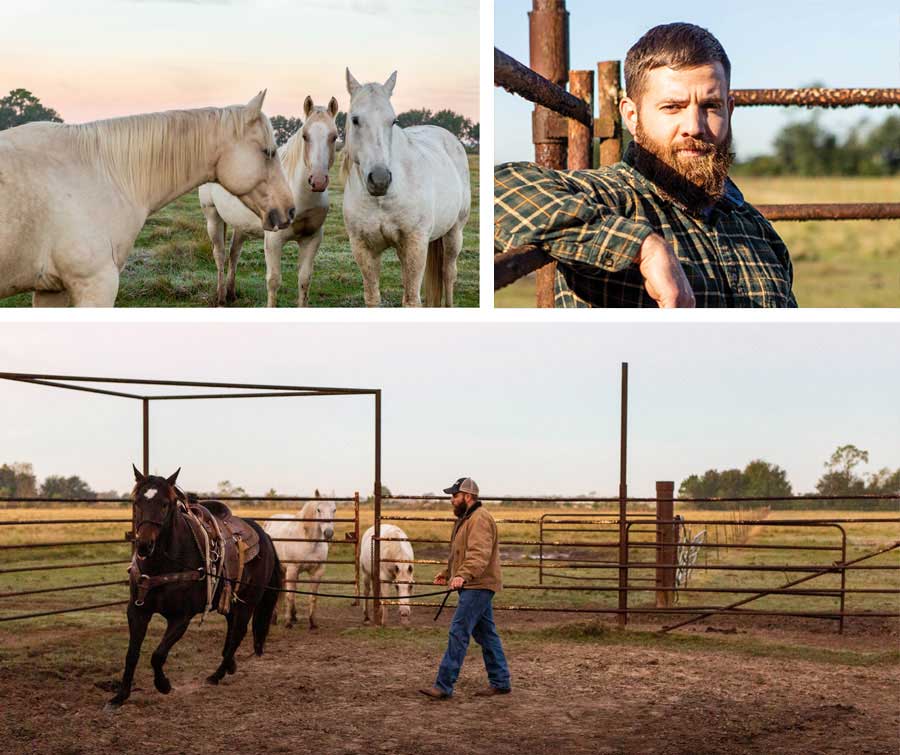
“Proper construction and ongoing maintenance drive dependability,” says Tyler. “Our ability to proactively maintain pipelines absolutely positions the American energy industry as one of the most efficient and reliable in the world.”
Cheniere works hard to ensure the safety of its employees and the surrounding environment. When filling tankers with LNG, massive ships are attached to the terminal with a loading arm that can automatically close and quickly detach from the vessel if necessary. Even in the shipping of LNG, clean natural gas makes a difference: Many LNG tankers are themselves powered by natural gas, which can reduce the ship’s greenhouse gas emissions by up to 30 percent.
“I think manufacturers see an abundant, clean energy source and are figuring out ways to make this fuel user-friendly for the trucking and shipping companies,” Tyler says. “You also see changes in regulations becoming more stringent, so the market demand is there as well.”
Increased access to clean natural gas for electricity generation is the main reason U.S. carbon dioxide emissions are at 25-year lows.47 Also exportable is this natural gas model that can help other nations reduce their emissions.
“We are very lucky to live in a politically and economically stable country that is rich in resources, like natural gas. Not everyone does,” he says. “I’m honestly proud to be part of an industry that’s having a global impact – making the world a more secure and cleaner place to live.”
The Conservation Mindset
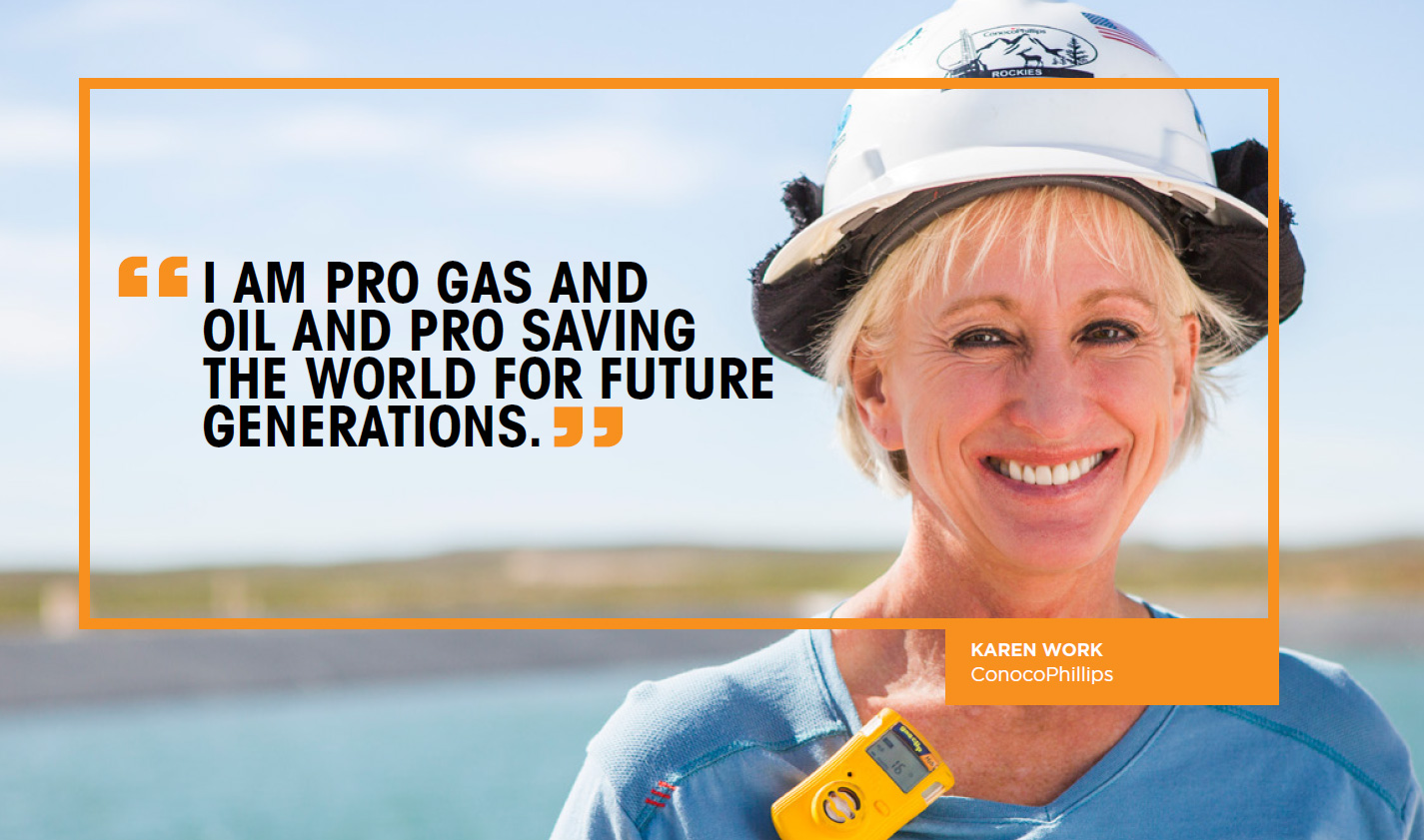
For ConocoPhillips’ Karen Work, Reusing Water Is Key To Good Stewardship In The Permian Basin.

Karen Work tells a story about a project she did with her children when they were still in elementary school. They calculated the water savings from turning off the faucet while they brushed their teeth, as well as from putting a brick in their toilet tank to reduce the amount of water needed to elevate the shut-off float. The experiment stuck. To this day she’ll shut off the water when husband Jim brushes his teeth. “I hate to waste,” she says.
Karen is the perfect fit to be managing ConocoPhillips’ innovative water-recycling project in hardscrabble West Texas, where water is precious – an initiative that’s projected to save millions of gallons of water from local sources each year in the company’s natural gas and oil operations when it goes online in early 2019. “To me, if we can take that water and recycle,” she says, “it’s a perfect example of how this industry is doing the right thing for the environment and the communities where we operate.”
Karen is a part of America’s Generation Energy: pioneers using new technologies and innovations to develop the natural gas and oil that power and support modern living – while also protecting the environment.
This includes responsible water management in the Permian Basin, which is underscored while navigating with Karen in her truck along dry, chalky roads that twist through greasewood plants and other scrub vegetation. Just north of a little dot on the Texas map called Orla, you’ll find two man-made water reservoirs on a rise overlooking the seemingly endless landscape. Together they hold 1.5 million barrels of water, which is integral to the company’s water recycling plans in the area.
The concept is simple: Reduce the amount of fresh water needed for hydraulic fracturing operations by reusing water that returns to the surface during well development as produced water. Well development involves injecting a water/sand mixture into the well bore to create tiny cracks in shale layers, releasing natural gas and oil trapped in the rock.
ConocoPhillips’ plan is to treat the produced water, store the treated water in Karen’s reservoirs and then pump it to the next well under development via lay-flat surface lines. The company estimates this will save about 500 million gallons of water a year.
Bottom line: Even though the industry’s water use is tiny compared to society’s overall use, reusing water is a key part of industry’s commitment to operate responsibly and efficiently and reduce its environmental footprint. Again, it’s part of Karen’s nature to be thrifty with resources.
She graduated from Texas Tech with the help of a scholarship from Phillips (which merged with Conoco in 2002 to become ConocoPhillips). The eager student from rural Fritch, Texas, then followed in the footsteps of her father and older brother – both engineers in the natural gas and oil industry. Later, as a single mom, she worked outside of industry, when she says conserving resources was a life necessity. When a new industry opportunity opened up she grabbed it, met Jim (who also works for ConocoPhillips) and now seldom looks back.
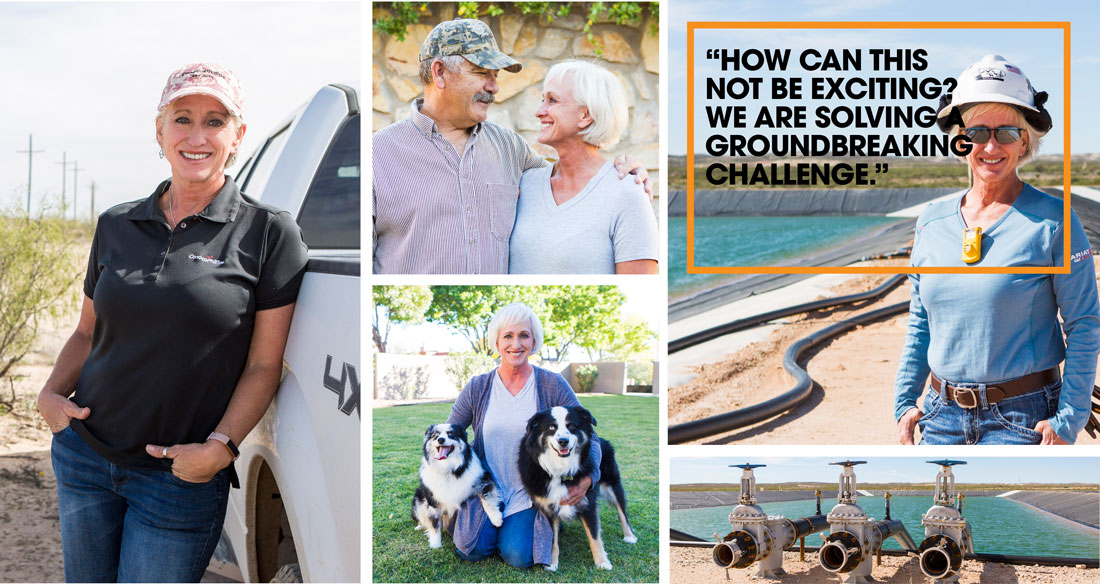
Karen and Jim live in Carlsbad, New Mexico, about 50 miles north of Orla, with their Australian shepherds, Gilbert and Gabby. Each day Karen and Jim commute down state highway 285 to ConocoPhillips’ base in Loving, New Mexico, and then across the Texas line to the company’s well pads. Currently, more than half the active oil drilling and production rigs are located on the lonely plains of the Permian Basin – making it an ideal location for environmental stewardship.
The scale of activity in the region requires an equally scalable recycling effort. Karen and her team work a project that is meeting the challenge. She anticipates the operation could save the amount of water held in 750 Olympic-sized swimming pools.
“I am pro gas and oil and pro saving the world for future generations,” she says, perched on the tailgate of her truck. “If we can conserve valuable resources and give people the many benefits of natural gas and oil, that is a win for everyone.”
It’s an approach that’s spreading in industry. Other companies working in the Permian frequently discuss best practices and implement advanced technologies at their locations. Karen often references the more than 100 lessons learned during her project and how she is sharing the knowledge with other operators.
Though Jim is from New Mexico, Karen is Texas through and through – direct, optimistic and self-sufficient. Over the doors leading from their patio into the house is a metal cutout of Texas overlaid with the Zia sun symbol found on the New Mexico state flag. It captures their close partnership at home and in the field.
Her team’s recycling project also is a symbol – representing a natural gas and oil business that’s working hard to provide much-needed energy while responsibly minimizing the effects of industrial operations.
“We are all in this together,” Karen says. “The fact that we are willing to share our experience is a tremendous example of industry collaboration. How can this not be exciting? We are solving a groundbreaking challenge.”
Fuels For The Next Generation
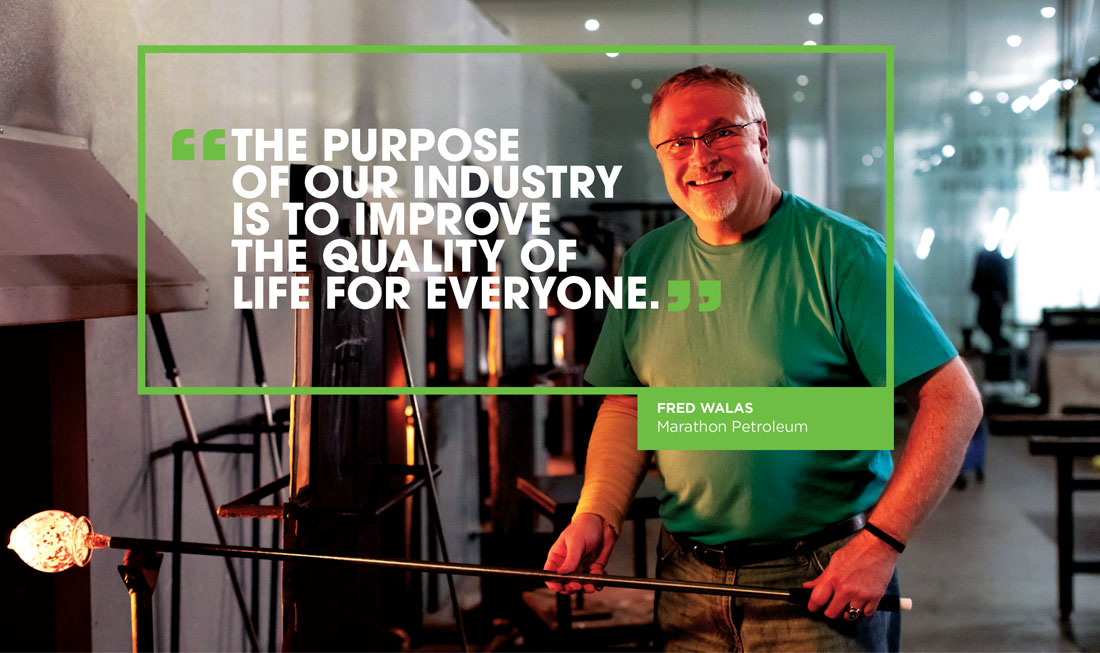
Marathon Petroleum’s Fred Walas Finds Art In The Science Of Crafting Fuels For Today And Tomorrow.

At the end of a long metal tube sits a glowing, semi-molten chunk of glass, slowly being worked by primitive tools in a kind of hypnotic dance – turning and shaping it against the backdrop of a red-hot furnace – to craft something useful before the 2,500-degree material starts cooling.
The steady hand controlling the glass-blowing process belongs to chemical engineer Fred Walas, a 38-year veteran of Marathon Petroleum, who picked up the hobby several years ago and loves a creative process that’s equal parts art and science. It’s an ancient metaphor for the very modern work Fred does by day – working with petroleum molecules to develop ever-cleaner transportation fuels for today and tomorrow.
“Crude oil has thousands of components,” he says, “and it’s our mission during refining to figure out how we combine those molecules into the right mix to work in engines that are constantly being updated to gain more efficiency.”
Fred is part of America’s Generation Energy: exploring, researching and applying the latest energy technologies to improve life. At Marathon Petroleum, Fred works every day to ensure that fuels are manufactured to meet the ever-evolving needs of automobiles – and to help his company think about what’s next. To him it’s a science challenge – and a little bit of art.
Fred talks about the cross-functional teams needed to make this happen. Marathon Petroleum brings together chemists, mathematicians, engineers and economists to consider all angles of fuel creation. He says more than 150,000 fuel stations across the country rely on his segment of the industry to make choices that best meet their customer needs. And he notes that the industry’s work to continually reinvent and improve fuels, in partnership with automobile makers, has reduced emissions from cars and trucks by more than 90 percent during his career.
Fred is a member of the Coordinating Research Council (CRC), a working group of the leading automakers and the natural gas and oil industry. For the past 75 years, CRC has played a major role in helping to chart the course that matches cars and trucks with the fuels needed to get Americans and commerce where they need to go while also helping lower emissions and improve air quality.
“Start with a blob of molten material or crude oil and you can work with it and shape it into something useful. When you get done, you look back and say, Wow that’s pretty satisfying!”
“We look at multiple time windows,” Fred notes. “Car companies are always designing on a three-to-five-year schedule. They also are thinking more long-term, out to a decade in the future. Fuel refiners like Marathon have to do the same.”
Part of his work is explaining these changes in fuel and engine design to Americans and U.S. policymakers. He recalls a car-ride conversation with his daughters a few years ago, when they were 10 and 13 years old and wanted to know how gasoline is made from crude oil. He figures the approach he used to answer their question is a good guide for communicating technical topics with non-technical audiences.
As the largest refiner in the nation, Marathon Petroleum is a big player in advanced fuel development. This includes biofuels such as ethanol and biodiesel that are made from corn, sugar cane and soybeans. However, Fred points out that biofuel creation is a limited answer to existing challenges because it is essentially accessing old technology for modern use.

“Creating biofuels follows the same process that you would use to create beer or bourbon. It’s fermentation of starches to produce sugars to produce ethanol. That’s something humans have been doing for 5,000 years.”
As an amateur hard cider brewer in his spare time, he understands the process well. But he says that biofuels are unlikely to be the most important player in developing the next generation of transportation fuels. The holy grail of fuel development is increased energy density, which he explains by comparing electric and gasoline-powered vehicles.
“The challenge for electric cars today is the amount of power available as it compares to weight. A modern gas-fueled car can go 100 miles on about 10 pounds of gas. An electric car would require 350 pounds of battery weight to do the same. That is a big disparity.”
He notes that batteries will get lighter and more efficient, but according to the U.S. Energy Information Agency, fuels made from crude oil will still play a significant transportation role for at least the next 30 to 40 years. These projections highlight the importance Fred sees in his work.
“The purpose of our industry is to improve the quality of life for everyone. If you go to the third world, you see that much of the day is spent seeking energy and food. Here in America, we don’t give that a second thought. Our access to low-cost and plentiful sources of energy make the difference.”
So, he continues to help shape regulations, engine standards and transportation fuels to meet the needs of the more than 250 million cars and trucks on America’s highways. Along the way you can see his consistent passion to form something new from a base material, whether it is refining crude oil or glass making.
“It’s really kind of interesting to think you can start with a blob of molten material or crude oil and you can work with it and shape it into something useful. When you get done, you look back and say, ‘Wow that’s pretty satisfying!’”
Innovating For A Cleaner Tomorrow, Today
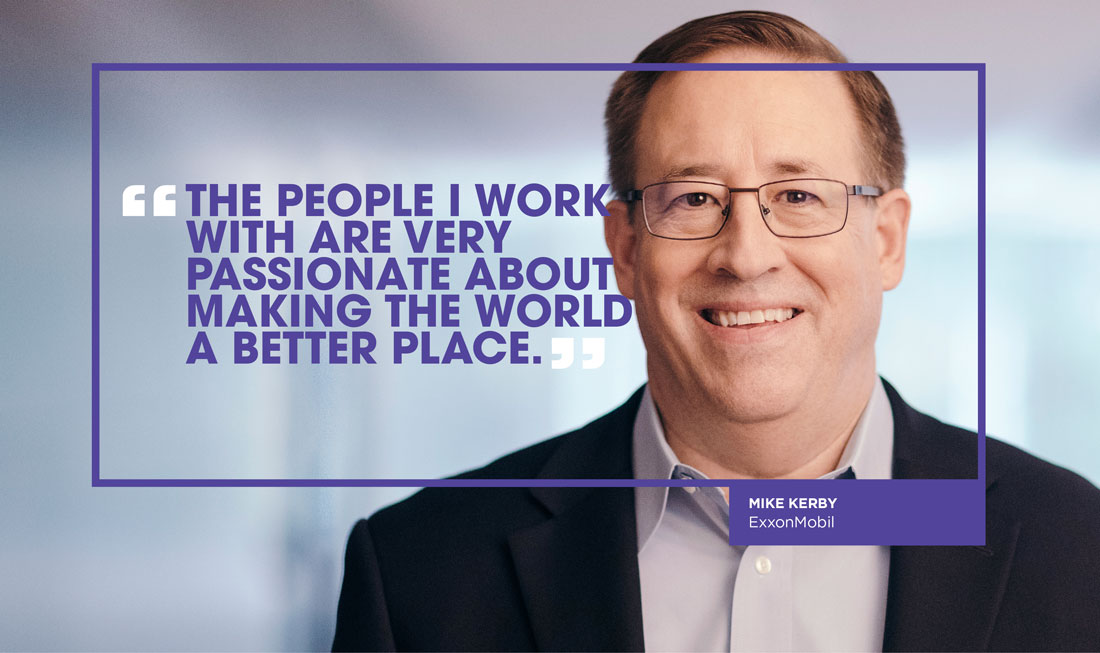
Mike Kerby Of ExxonMobil Believes Technology Is Vital To Solve Energy And Climate Challenges.

As a child, Mike Kerby loved watching his model train round the tracks every day after school. One weekend, inquisitiveness overpowered that love when Kerby carefully dismantled the train to examine the engine, as he wanted to make it go faster. While Mike’s dad wasn’t thrilled – “I couldn’t help myself and thought it was so cool,” Mike says – it suggested the baseline curiosity of a scientist in the making.
Mike is part of America’s Generation Energy: helping to identify and meet energy challenges through solutions born of innovative technologies and collaboration. Industry scientists like him are developing new technologies, methodologies and landmark breakthroughs that are making the development and use of natural gas and oil cleaner, safer and more efficient, while pushing the boundaries of science to meet global energy needs.
“Energy underpins modern society,” ExxonMobil Chairman and CEO Darren Woods said at the 2018 World Gas Conference. “In fact, energy is essential to everything we do: improving living standards and lifting people out of poverty, growing economies and providing for healthy, vibrant communities.” But as we produce the energy that makes the world go, we realize we must do so in a way that safeguards our environment. This includes finding solutions that address the risks of climate change.”
The natural gas and oil industry’s history is filled with surmounting challenges. The ongoing U.S. energy renaissance, which has made the United States the world’s leading natural gas and oil producer, was spawned by fundamental inquisitiveness and innovation, leading to solutions.
A significant example is technologically advanced hydraulic fracturing and horizontal drilling, which have unlocked vast reserves held in shale and other tight-rock formations previously thought inaccessible. Surging domestic production is supporting the economy, strengthening American security in the world and benefiting consumers. At the same time, increased use of abundant natural gas to fuel electricity generation is the primary reason U.S. carbon dioxide emissions have fallen to 25-year lows.
Mike and others are focused on meeting global energy needs while also finding climate solutions. “Meeting growing energy demand while reducing environmental impacts, including the risk of climate change is what we, at ExxonMobil, call the dual challenge,” Mike says. “This dual challenge is one of the most important issues facing society today.”
Figuring out solutions to solve this challenge is the fuel that motivates Mike and thousands of scientists and engineers at ExxonMobil and the universities, national labs and businesses they partner with every day. The focus is on the transportation, power-generation and industrial process sectors which are responsible for generating the most emissions. The task is to identify ways to improve efficiency and reduce greenhouse gas emissions.
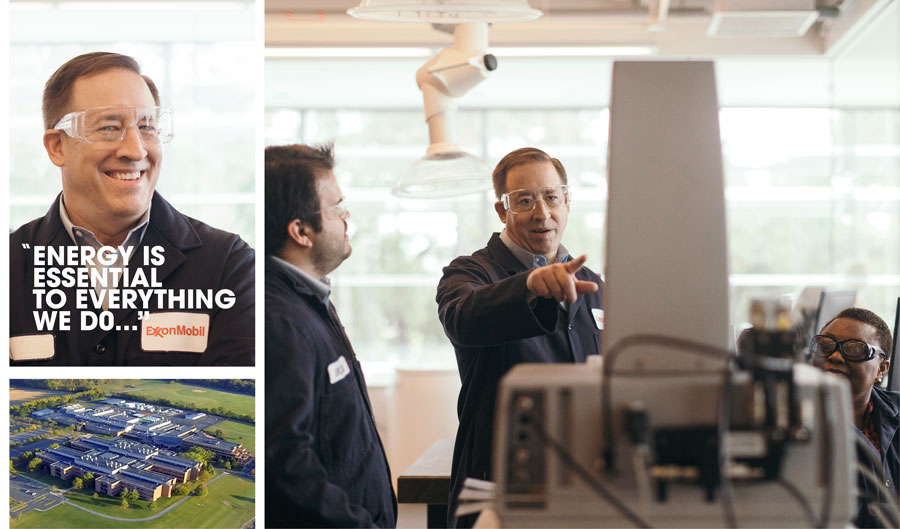
“If you understand the fundamental physics, math and chemistry that underlie most of the challenges we’re dealing with, you can attack them in a totally different way and push what’s possible to the limit,” Mike says.
In the transportation sector, ExxonMobil’s diverse mix of biologists, physicists and engineers are studying renewable sources to supplement diesel. They see algae – a non-food, organic substance that live in brackish water – and cellulosic sugars, from sources like agricultural waste, as two paths to developing advanced biofuels. With ease of integration in mind, these fuels might one day be processed in existing refineries and power heavy-duty diesel trucks or jets without having to rework their engines. From concept to test tube to indoor tanks and outdoor algae ponds, the company is analyzing how these fuels could be scaled up so they’re affordable and accessible while helping to reduce greenhouse gas emissions.
In power generation, ExxonMobil is developing carbonate fuel cells to concentrate CO2 while generating power, as well as methods to safely store it in geological formations, as solutions to capture and sequester CO2 before it reaches the atmosphere. They’re also looking at ways to reduce the amount of energy used in industrial processes through novel approaches, for example developing membranes that can separate chemical building blocks at much lower temperatures, which could have a significant reduction in emissions.
ExxonMobil devotes $1 billion each year to research and development, in addition to the $9 billion it has spent since 2000 on technology on lower-emissions energy solutions. The funding supports laboratories and the equipment needed to produce major breakthroughs. Still, Mike believes it’s the human element – a unique mix of skills, interests and diverse inputs – that makes advances possible.
“The people I work with are very passionate about making the world a better place,” he says. “I can walk down the hall and bump into world-class scientists and engineers in any discipline you can imagine. And that’s where you get the richness and diversity of ideas.”
This fountain of ideas springs partly from the sense of wonder that always has been part of Mike’s makeup. It’s what pushes him ahead, years into his professional career – that and the desire to discover things that can make lives significantly better. To make a difference.
“At the end of the day, we challenge paradigms and look for breakthrough technologies, that some call dreams,” he says, “But we don’t dream, we apply fundamental science and engineering to turn dreams into reality. That’s what we have done at ExxonMobil for decades. And we are excited about the programs we are working on today and the impact they can have toward addressing the dual challenge.”

FOCUS ON PARTNERING
Noble Energy’s Adi Amir Knoll is involved in a collaboration between Noble’s engineers and volunteers and Ta’asiyeda instructors in Israel. It’s a curriculum project that introduces 7th and 8th grade students to the world of energy, encourages technological studies and promotes innovation. The students combine what they learn with their imagination to create a model “smart” city that is powered by natural gas.
“I think the best moment was meeting the kids, seeing them present the city and seeing how much they enjoy it,” Adi says. “It makes everything we’ve worked for worthwhile – to see them light up about it, to see them excited.”
The children liked the program because it used games and activities to stimulate their thinking and creativity. “It’s very important to us that the children have the knowledge about … the world of energy,” says Dr. Avital Laufer, a local education official.
“The best moment … was meeting the kids. … It makes everything we’ve worked for worthwhile, to see them light up about it, to see them excited.”
– Adi Amir Knoll, Noble Energy
Educators say learning about energy is important because of Israel’s significant natural gas reserves just off its coast. “Noble Energy … let all our next generation to understand about the treasure that we have down in the sea,” says Yael Aviv, Ta’asiyeda’s director of education programs.
2020 State of American Energy
On This Page:
America’s Progress at Risk: The Impacts Of A Fracking BanPolicy Pathways
Energy in Communities: Aurora, Colorado
Energy in Communities: Moon Township, Pennsylvania
Energy in Communities: Red Wing, Minnesota
Energy in Communities: Lansing, Michigan
Energy in Communities: Las Cruces, New Mexico
Energy in Communities: Virginia Beach, Virginia
Energy in Communities: Eau Claire, Wisconsin
America’s Progress at Risk
The Impacts of a Fracking Ban
Hard-earned economic progress and opportunity – illustrated in Colorado, Pennsylvania, New Mexico, Minnesota, Wisconsin, Virginia and Michigan, thanks largely to America’s energy transformation – could be lost if the U.S. energy revolution is halted by banning fracking or ending new federal natural gas and oil leasing, as some advocate.
Ending hydraulic fracturing would cause significant impacts to the U.S. economy and household energy costs, and increase our dependence on foreign energy, according to soon-to-be-released independent analysis.
Today the U.S. is No. 1 in the world in natural gas and oil production but ending hydraulic fracturing would mean:
- $900 Billion increase in U.S. Household energy costs through 2030
- $6.3 Trillion less for families to spend on priorities
- $7.1 Trillion in potential losses to the U.S. economy by 2030
- Up to 7.3 Million fewer U.S. jobs by 2022
- The U.S. would import 40% of our oil and petroleum products by 2030 and 29% of our natural gas by 2030
- Even with more renewables, the U.S. would use more coal to generate electricity, with a 40% increase in coal generation over today.
Policy Pathways
Policy Priorities To Continue U.S. Energy Progress
Natural gas and oil power America’s 21st-century economy, strengthen our nation’s security and support U.S. global leadership in reducing greenhouse gases.
The U.S. is No. 1 in the world in natural gas and oil production – thanks to abundant reserves and today’s modern, technologically advanced industry.
Now is no time for turning back. To grow American energy leadership, we must look to the future and prepare for projections that global energy demand will rise with policies that support safe, responsible domestic natural gas and oil production. The following pages describe forward-looking polices that will foster sound, well-managed development that benefits American families, creates opportunity and helps secure our country well into the future.
Expand U.S. Energy Infrastructure

To keep pace with rising energy demand, over $1 Trillion Is Needed For Infrastructure investments through 2035
API RP 1173, Pipeline Safety Management Systems: helps pipeline operators benefit from a safety management system (SMS) and systematically manage pipeline safety and measure progress to improve overall performance
Delivering Affordable, Reliable Energy
U.S. energy infrastructure, including pipelines, export terminals and ports, is a complex and extensive network that seamlessly delivers energy to consumers.
Pipelines are the safest and most efficient way to transport natural gas and petroleum for everyday use. Over the past five years, liquids pipeline mileage increased by nearly 12% to accommodate America’s energy production growth. Infrastructure expansion will ensure that our abundant, homegrown energy reaches American households, businesses and U.S. trading partners.
Increasing efficiency, transparency and certainty in federal permitting is essential to aligning smart regulations with responsible and timely investment in necessary projects.
For example, modernizing the National Environmental Policy Act’s (NEPA) maze of permitting rules is necessary to the sustainable development of the nation’s vast energy resources.
Support American Energy Development

2.37 Million Acres of parks, forests, and recreation areas in 50 States federally funded primarily by offshore energy royalties
API RP-75, Recommended Practice For Development Of A Safety And Environmental Management Program For Offshore Operations And Facilities: ifoundational offshore safety and environmental management standard that reflects state-of-the-art systems to drive safety and environmental protection in offshore operations
Access To Energy Key To Security
With global energy demand projected to increase more than 45% by 2050, access to energy is more important than ever. Safe and responsible production in the U.S., including on federal lands onshore and offshore, is critical for a reliable, affordable and cleaner energy mix. In addition, investments in natural gas and oil support communities by contributing to lower household energy costs, more jobs, and greater state revenue for education and public projects.
The federal government should expand offshore natural gas and oil leasing opportunities to promote continued domestic production since offshore natural gas and oil reserves can take over 10 years to develop and will help to secure our country’s long-term security.
Transparent, streamlined and expedited federal permitting processes are necessary for the timely review of natural gas and oil production – which in turn promotes economic growth for local communities, investments in parks, roads, and schools, and good-paying jobs.
Remove U.S. Trade Barriers And Open Global Markets

In 2019, the U.S. produced 12 Million barrels of oil per day
89,000 barrels of oil per day in U.S. Exports
Free Trade Agreements Support U.S. Jobs And Investments
Free-trade agreements like the USMCA – that eliminate tariffs, create energy trading zones, and protect U.S. energy investments in other countries – help open markets for the American natural gas and oil industry, boosting domestic production and job growth. Provisions in free-trade agreements, including the elimination of tariffs on products, create a level playing field for the U.S., which enables greater energy trade and investment all around. That benefits energy consumers and energy security for the U.S. and our partner countries in these agreements.
Policymakers and regulators must insist on international agreements that strengthen free market energy trading relationships between the U.S. and the rest of the world, coupled with domestic policies that allow for exports to the global market.
This includes de-escalating trade disputes with China and other nations that take America in the wrong direction. The U.S. needs to de-escalate the trade war with China: through commitments that remove U.S. tariffs that still remain on hundreds of industrial components that are used in the U.S. natural gas and oil industry and that remove retaliatory Chinese tariffs against U.S. exports of crude oil, LNG, and chemicals products. And the U.S. needs to remove tariffs on imports of specialty steel used in the American natural gas and oil industry that we import from our allies, working together rather than against our allies to address the unfair trade practices of other nations. Trade wars block American progress and the global competitiveness of the U.S. natural gas and oil industry.
The U.S. recently became a net exporter of energy for the first time since the 1950s – a milestone that brings with it a slew of economic benefits, including lower energy prices and renewed investment in resource development, processing, and transportation.
These exports strengthen America’s standing as a world energy superpower and create opportunities for the U.S. to use its energy to alleviate poverty and reduce emissions around the world. Going forward, policies should support additional export capacity, which will help meet expected growth in global energy demand, boost energy trade, spur domestic production, and grow the economy.
Level The Playing Field For Transportation

80% of all federal EV subsidies have gone to individuals making $100,000 or more
E15 and other higher ethanol volume fuels Can Damage:
- Boat engines
- Outdoor power equipment
- Vehicle engines
- Motorcycle engines
API Standards [ILSAC GF-6A, GF-6B And API SP]: improved performance standards for engine oils that will provide greater protection and fuel efficiency for today’s gasoline-engine-powered cars and trucks
Protecting U.S. Consumers
Consumer-friendly transportation policies require a free-market approach to ensure a level-playing field for all Americans. Government mandates and subsidies harm consumers by unfairly disrupting market decisions.
For example, biofuel mandates distort the marketplace to use products that can damage vehicles, while electric vehicle (EV) tax credits subsidize upper-income households purchasing luxury vehicles at the expense of taxpayers.
The Renewable Fuel Standard’s (RFS) objective of reducing crude oil imports is obsolete given growing domestic oil production, and its goal of producing commercially viable cellulosic biofuel has never materialized. Today, about 70% of vehicles on the road weren’t designed to run on E15 fuel, per manufacturers’ manuals, and no boats, small engines or motorcycles can use the product. The outdated ethanol mandates puts consumers at risk by incentivizing higher ethanol blends in the fuel supply.
Electric vehicles can and should coexist with internal combustion engine vehicles (ICEV) on our roadways in a vibrant, free market. However, subsidies for EV purchases disproportionately advantage upper-income households, and many federal and state transportation policies exempt EV owners from paying their fair share for road maintenance and repair. Those same households also get assistance by having the EV charging infrastructure paid for by electricity rate payers regardless of whether they own an EV or not.
Fuel policies should safeguard consumers against unfair subsidies and mandates that do not harm all U.S. consumers.
Adopt Climate Solutions

$108 Billion invested in greenhouse gas mitigating technologies between 2000-2016
API RP 50, Natural Gas Processing Plant Practices For Protection Of The Environment: for natural gas processing to help companies reduce methane and other greenhouse gas emissions
Api engages on climate policy from a principled approach and supports bipartisan legislation to incentivize research and development of ccus, including the use it act (s. 383) And the leading act (s. 1685)
Investing In A Cleaner Energy Future
The U.S. natural gas and oil industry is laser-focused on delivering affordable, reliable, and ever-cleaner energy to businesses and consumers around the world.
The increased use of natural gas in power generation, industry’s leadership and continuous innovation, and creation of state-of-the-art standards have driven U.S. carbon dioxide emissions to their lowest levels in a generation, even as global emissions are on the rise.
Now that the U.S. is the world’s leading producer and a net exporter, cleaner natural gas is more readily available in areas that experience energy poverty – reducing global emissions, raising standards of living, and supporting the uptake of renewable energy.
API and its members commit to delivering solutions that reduce the risks of climate change while meeting society’s growing energy needs. We support global action that drives greenhouse gas emissions reductions and economic development.
The natural gas and oil industry is part of the global solution and plays a vital role in developing and deploying technologies and products that continue to reduce GHG emissions while advancing human and economic prosperity and that are essential to extending the benefits of modern life to all.
Unlock Innovation And Cultivate Partnerships

67% Decline in methane emissions relative to production, 2011 – 2018, in five of the major producing areas.
Since 1990, methane emissions from natural gas systems nationally have Dropped 14% while natural gas production has increased More Than 50%.
Energy Progress Is Not Done Alone
It has always been a mixture of industry leadership, opportunities to innovate, and partnerships with the best minds – from academia to government scientists, such as those in U.S. national labs. The natural gas and oil industry’s continued advancement of engineering technologies over time, such as hydraulic fracturing and horizontal drilling, benefit the nation’s economic strength and energy security.
Constant innovation, smart regulations, collaborative efforts, and industry initiatives, help to ensure that industry is providing affordable and reliable energy to consumers, while reducing its environmental footprint and emissions.
For instance, The Environmental Partnership, which is comprised of companies in the U.S. oil and natural gas industry committed to continuously improving the industry’s environmental performance, serves as a model of industry leadership. The U.S. leads the world in producing natural gas and oil and is committed to reducing emissions relative to production in basins across the country.
API works to constantly evaluate and strengthen industry standards to drive progress in safety, environmental protection, and efficiency across the industry. API’s Global Industry Services (GIS) drives safe production globally through critical partnerships, including signing four memoranda of understanding (MOU) with international parties and working with emerging nations on standards adoption.
Additionally, API partners with energy trade associations around the world to cultivate partnerships focused on global sustainability. We work together with associations including IPIECA and IOGP to convene and produce standards and guidance that our member companies use globally to conduct operations in a safe, environmentally responsible manner that is responsive to communities around us.
Energy in Communities:
Aurora, Colorado
Natural Gas And Oil Partner With Aurora In City’s Steady Growth
For more than 40 years, the Nuñez family has been serving home-style Mexican recipes from the same restaurant location in Aurora, Colorado. Today, Alfonso and his wife, Doña, proudly keep the family business going — serving dishes made from scratch, including handmade tortillas, using recipes passed down from his parents, while also infusing creative touches of his own.
La Cueva, with its neon green sign and turquoise booths, is a staple within the community and a landmark in a city that looks much different today than it did in 1974. Alfonso says La Cueva was the first Mexican restaurant to open in East Colfax, an area within Aurora’s center.
La Cueva, with its neon green sign and turquoise booths, is a staple within the community and a landmark in a city that looks much different today than it did in 1974. Alfonso says La Cueva was the first Mexican restaurant to open in East Colfax, an area within Aurora’s center.
“The natural gas and oil industry is an important sector that helps to maintain economic stability throughout the Denver metro area, and the entire state of Colorado.”
– Michael Orlando, Economist, University of Colorado Denver
Nuñez has seen much change over the years, and he’ll be the first to say that not all the changes have been easy. However, La Cueva stands as a warm and comforting reminder that, just like a good meal, stability and growth in many aspects of life often require a nod to tradition, a good mix of fresh and local ingredients, and a spirit of innovation.
This is Aurora. Tradition, new ideas and innovation combining to help the city and the surrounding area emerge from the shadow of nearby Denver. It’s the home to more than a dozen thriving business sectors, with 11 development deals bringing thousands of jobs and driving nearly $290 million in capital investments in 2017. In this, abundant natural gas and oil energy, much of it home-grown from the nation’s 7th-largest energy producer, has played an important, empowering part.
The city of Aurora has seen the success that comes with staying true to its identity, while also creating a path for economic growth. Kevin Hougen, Aurora Chamber of Commerce president, describes the Aurora as a former bedroom community for Denver. Today, the city is vibrant, yet relaxed in its true form, and as diverse in culture and industry as it is in its appeal to people from all walks of life. From bio-science and healthcare to cybersecurity, aerospace and the military, Aurora has it.
Job growth, along with quality of life, outdoor activities, and what Hougen calls “attainable housing,” are perhaps reasons why Aurora’s population grew by more than 6,000 from 2017 to 2018.
Economist and University of Colorado Denver professor Michael Orlando says the state is shaped and strengthened by its varied industrial mix. “Colorado’s economy exhibits more diversity than the industrial balance of the nation,” says Orlando, who points to the significant contribution from natural gas and oil.
“The natural gas and oil industry is an important sector that helps to maintain economic stability throughout the Denver metro area, and the entire state of Colorado.”
30,000 Jobs
As of 2017, Colorado’s oil and gas sector provided roughly 30,000 direct and indirect jobs within the state
$13.5 Billion
As of 2017, Colorado’s oil and gas sector added about $13.5 billion to the state’s domestic product
Education
The industry also provided 81% of the distributions made to Colorado’s School Trust, which supports public K-12 education.
Orlando led a recent study that shows natural gas and oil gas add twice as much to Colorado’s economic output, as compared to the industry’s share of GDP nationwide. And significant tax revenues from the industry support a variety of public expenditures, including education, conservation and infrastructure.
- Supports 24,900 jobs – almost 6% of the district’s employment
- Directly and indirectly adds more than $3.3 billion each year – 7.5% of the district’s total economy
The industry adds to the community in other ways. Volunteer and community programs from the industry include cleanup days with area students, mental health crisis help groups, active area churches and school volunteer programs all tie communities together.
And those ties continue to strengthen. The front range region around Aurora is a prime example. The area serves as a collaborative learning laboratory of sorts among natural gas and producers and nearby residents. Orlando notes that the industry integrates community input into its operations, and how all parties are becoming more engaged in ways that could serve as a model for the nation.
This engagement is part of a broader industry commitment to be a good neighbor — to hear and respond to local concerns, improve operations and safety and to protect the environment. In turn, the environmental performance of industry facilities, fuels and other products has been improved.
In Aurora, young, entrepreneurial ventures are bringing new values to innovation. Extraction Oil & Gas, a Denver-based exploration and production company, was formed in 2012 and co-founded by then 27-year old Matt Owens, now the company’s president.
But it didn’t take the industry’s relative newcomer long to make an important mark on Colorado. Extraction Oil & Gas has landed on the Denver Post’s “Best Places to Work” list three times in the company’s seven-year history.
For Brian Cain and his colleagues at Extraction Oil & Gas, social responsibility is just as important as economic impact, and speaks to much of what has led to the company’s success.
“Extraction Oil & Gas solely operates in Colorado and so much about the lifestyle we, as fellow residents, enjoy centers around our natural environment and the outdoors. We take pride in being good stewards and good community partners,” says Cain.
Along with corporate social responsibility, the company believes its commitment to leveraging proven technology is foundational to business. Still growing, Cain sees a sweet spot for Extraction Oil & Gas.
“We want to remain agile. That will enable us to effectively leverage cutting-edge technology like automation, and add techniques like remote monitoring that reduce costs, as we continue to invest in workforce training,” says Cain.
Extraction Oil & Gas recently began installing engineered polymer sound walls and utilizing other noise reduction technology during well drilling operations.
“This is a win-win for our workers as well as neighbors in areas where we operate,” Cain says. “More than anything, it serves as a testament of how innovation can enable safe operations, economic growth and a good quality of life to all coexist.”

Lilla Ramos, La Cueva Restaurant – Aurora, Colorado
Colorado has seen the fruits of its energy production in more ways than one — underscoring energy’s empowering capacity.
Like economic growth, the city’s energy use is well planned and managed. Electricity rates are about 10% lower than the national average for commercial use and more than 13% lower for residential. Aurora demonstrates the importance of good stewardship of rich natural gas and oil resources, as well as infrastructure. That includes the Magellan Chase Pipeline, which begins in Aurora.
The oil and natural gas industry adds more than $3.3 billion each year to the economy of Colorado’s 6th Congressional District, where Aurora is located, or 7.5% of the district’s total economy. Jobs include everything from petroleum engineers, environmental experts and rig hands to truck drivers, caterers and contractors. Whatever the skills or specialties, all benefit from local energy-related economic activity.
And Aurora has its sights set on continued economic growth with a number of exciting development projects underway.
Colorado Air and Space Port, located six miles from Denver International Airport, is slated to serve as a U.S. hub for commercial space transportation, research and development.
The Gaylord Rockies Resort & Convention Center, located in Aurora, opened its doors in December 2018 and stands as the largest combined resort and convention center in Colorado.
Back at La Cueva, Alfonso says that while the population and development have grown exponentially in recent years with a number of projects slated for the city’s near future, like his family’s recipes, the heart of Aurora remains as true as ever. But he also knows firsthand the importance of spicing things up. After all, it’s what’s kept La Cueva thriving for more than four decades.
Energy in Communities:
Moon Township, Pennsylvania
Energy Empowers Western Pennsylvania Comeback Stories
The Coraopolis Bicycle shop is celebrating 50 years in business. Walk through its unassuming front door and Dick Wolf, the shop’s quiet owner, appears from the back room where he rehabs gears, brakes and tires for customers young and old. His story is a tale of Western Pennsylvania.
When Wolf opened his store in 1969, he sold a little of everything, including bicycles. You could think of his original shop as akin to a today’s Dollar Stores. However, the big box companies began to put pressure on his business, so he transformed the Fifth Street storefront into a pure bicycle repair and sales operation.
“This industry provides people with optimism instead of pessimism.”
– Sam DeMarco, Council Representative at Large, Allegheny County, PA
Wolf has served generations of riders by surviving economic cycles, like the closing of the nearby steel mills, and changes to his own business model. Much like Wolf, the town of Coraopolis, about 15 miles northwest of Pittsburgh, is a survivor that is once again thriving thanks to a decade of natural gas development in the Marcellus shale – as well as the broader economic benefits of abundant domestic energy.
Despite its up-and-down past, the region today is experiencing significant growth. Information Technology jobs are up 18%, Transportation and Warehousing have grown about 12%, Arts, Entertainment and Recreation 11% and Mining, Quarrying, Oil and Gas Extraction are up 8% since 2013.
Area business owners will tell you that the opening of the Marcellus Shale for natural gas production in 2008 spurred strong and lasting growth in revenues, wages and land values. Moon Township, where Coraopolis is located, boasts an unemployment rate under 3%, and the median income was well over $70,000 annually (compared to about $60,000 nationally) in 2017. It doesn’t matter if your collar is blue or white, it seems everyone has an opportunity to earn a good living these days.

Dick Wolf, Coraopolis Bicycle – Coraopolis, Pennsylvania
“New industry benefits everyone here, and this region has really exploded over the past 20 years,” Wolf says. “This progress is good for all of our businesses. I have a lot of loyal customers from all over Western Pennsylvania, Ohio and West Virginia, and I am proud of the businesses here in town like mine that have survived for two and three generations.”
Standing in front of the shop, you see a steady flow of traffic go by, supporting a town on the rise. Located along the Ohio River, you can still feel the community’s steel and manufacturing roots even as its 21st-century economy shines through.
Job Growth:
Information technology
Transportation and warehousing
Arts, entertainment and recreation
Mining, quarrying, oil and gas extraction
Nick Haden from Reserved Environmental Services grew up in Moon and describes what happened when his natural gas and oil services company began to expand. “At the time, our employees would say things like, ‘Thank you, this is going to be the best Christmas we have ever had.’ Hearing that from your employees means a lot.”
Haden’s company provides water recycling services to the natural gas and oil industry – an integral part of industry’s commitment to energy development that is safe for communities and the environment, while lowering emissions. Today his company has 90 employees and will soon open its third recycling plant – just one piece of the puzzle in a thriving economy.
- Supports 18,390 jobs – almost 5% of the district’s employment
- Adds more than $1.78 billion each year – 6% of the district’s total economy
Ann Flask came out of college with a criminology degree and worked as a fraud investigator for the banking industry. But like so many others, she experienced job loss. On a whim, she visited a job fair and met a recruiter for Pittsburgh’s local Steamfitters union. Soon after that, she became a welder, a job that today is in high demand as new manufacturing and infrastructure projects continue to be approved. This includes a multi-billion-dollar chemical plant being built in the area to turn natural gas into the building blocks for plastics. At the peak of the construction phase, the project is supporting an estimated 6,000 jobs.
“There was a buzz about this project, and we are all excited about the job creation, not just for the steamfitters but for everyone,” Flask says. “It’s been a great provider for me, and I am excited to be part of something that is going to provide for the long term.”
The challenge for the Steamfitters and other local businesses is how to best staff the jobs flowing into the region. With opportunity comes competition. Manufacturing, energy and other expanding industries in the region pay well. A competitive labor market increases wages even further. An Allegheny Conference on Community Development study, “Inflection Point,” projects 80,000 skilled workers will be needed to fill these high-paying jobs by 2025.
Local business owners, craft labor unions, educators and public officials are coming together to meet this challenge. Efforts are underway to build new training and apprentice programs, expand and retool university and community college curricula, and develop additional mentoring opportunities to build the skills needed across the area.

Hunter Truck Sales’ Mike Fischer (left) and Dustin McClanahan – Butler, Pennsylvania
One hour north of Moon township, leaders at Hunter Truck’s corporate headquarters needed qualified workers so badly they decided to build their own training center. The company has seen more than 40% growth since 2008. And it all started with a little gamble.
“About 10 years ago, our vice president of sales decided to buy 80 water trucks without any orders because he heard there was a real need in the industry,” says Nancy Hunter Mycka, one of the third-generation owners of the company. “We all thought he was crazy at the time, and then all but one of those trucks sold before they even arrived. And the last truck sold the same day it got here.”
Hunter needed to attract new talent fast. The company gave raises throughout the organization and then went to work recruiting during one of the largest expansions in its 80-year history. The team claims that a CDL driver’s license can be as valuable as a Ph.D. these days in Western Pennsylvania.
When you talk to politicians in Allegheny County and the greater area, they will tell you that opening the Marcellus Shale helped local residents’ weather the recession during the first decade of the 21st century and delivered hope to people who didn’t have it before.
“This industry provides people with optimism instead of pessimism,” says At-Large County Councilman Sam DeMarco. “Right now, the unemployment rate in Pittsburgh and Allegheny county is the lowest it’s been since we started recording it in 1976. That means thousands of residents have good sustaining jobs.”
And it goes beyond jobs. DeMarco says utility bills in the region have dropped sharply, helping seniors, low-income residents and other vulnerable groups. There are even unforeseen benefits like investments in new passenger terminals at Pittsburgh International Airport. He said the natural gas companies also re-invest in the community, funding projects like park and public space rehabilitation, new recreation projects, and improved roads and bridges.
Back in Coraopolis, a long-term customer brings his bicycle into Dick Wolf’s shop for a tune-up. A quick inspection shows a good deal of rust and a big job ahead. But much like the town he has loved for so long, Wolf shows a quiet resolve to keep moving forward. He patiently wheels the broken vehicle into the back room, confident it has a strong future under his steady hand and never-give-up approach.
Energy in Communities:
Red Wing, Minnesota
Energy Empowers Industry, Agriculture In Southeastern Minnesota
The morning sun rises over the bluffs that frame the town of Red Wing in southeastern Minnesota, hugging the Mississippi River’s southern bank about 55 miles from Minneapolis. In the nearby fields and pastures the soil is black and fertile, supporting a cornucopia of planted grains, as well as cattle ranches and chicken farms. Soon, the bounty raised here will make its way to American dinner tables all over the country.
A few miles north, an industrial corridor is home to Red Wing’s robust manufacturing sector. There, scientists and engineers at research and design centers uncover new technologies and applications, while production teams build products that will be packaged, sold and distributed around the world.
“Low-cost energy helps to keep our facilities operating so that families here can continue to earn a decent living.”
– Mike Goggin, State Senator, MN
Together, industrial manufacturing and farming have driven the Red Wing economy for more than a century. Today, perhaps more than ever, both are thriving in this part of the country because of abundant U.S. natural gas and oil – energy that empowers all sectors, benefits consumers and helps protect the environment. Red Wing native and state Sen. Mike Goggin recognizes the vital role affordable energy plays across the regional economy.
“Manufacturing is energy-intensive, and it’s our bread and butter,” Goggin says. “Low-cost energy helps to keep our facilities operating so that families here can continue to earn a decent living and enjoy all the things that make Red Wing so special.”
Statewide, the natural gas and oil industry supported more than 117,000 jobs, or more than 3% of Minnesota’s total employment in 2015. The industry provided more than $7 billion in wages and contributed more than $14 billion to the state economy – including $4.5 billion to the second congressional district where Red Wing is located.
But industry’s impact is more than it and its suppliers. It’s energy that fuels and produces across all sectors – manufacturing, construction, logistics, banking and more. Energy is foundational to growth and the opportunity to prosper. They’re seeing it in Red Wing and the surrounding area.
The home of headquarters for global players including Red Wing Shoe Company, 3M, Riedell and BIC Graphic – the parent company of a half-dozen other well-known brands – the town of 16,000 has an oversized impact on the world. Just up the road, Marathon Petroleum’s St. Paul Park refinery produces essential fuels for the nation’s transportation sector.
Overall, things are good here. The area’s unemployment rate of 3.1% (as of September) is about a point lower than the national rate. There’s growth, and energy is playing its part. Just ask Tito Warren, a top executive at Red Wing Shoe Company.
“From the natural gas used to power Red Wing manufacturing facilities and retail stores to the fuel we rely on to transport products, and the hard workers who rely on our products, energy is tied to everything we do,” says Warren, vice president of global sales.
Red Wing is one of the world’s oldest work boot makers. Workers in farming, construction, manufacturing, natural gas and oil, and a number of skilled trades swear by Red Wing footwear. The company’s first flagship retail location still sits along Red Wing’s Main Street. A 16-foot-tall, Size 638 ½ boot was parked there to mark the company’s centennial in 2005.
Besides boots, the company makes protective workwear, gloves, safety glasses and more. These items are particularly important to natural gas and oil industry workers, from the Permian Basin of West Texas to Southeast Asia. Other heavy industrial trades rely on Red Wing products, too. Warren calls the boots a “symbol of American manufacturing everywhere.”
Others point to energy’s positive role as well. David Ybarra, president of the 9,000-member Minnesota Pipe Trades Association, says the U.S. energy revolution helps support much-needed job growth at a critical time.

Bill Hanisch, Hanisch Bakery & Coffee – Red Wing, Minnesota
“The commercial and residential segments of the pipefitting industry were hit hard during the recession and we didn’t have a lot of other options,” Ybarra says. “The shale boom sustained us, drew more people to pipefitting and led to jobs at nearby refineries and natural gas plants that are just as important to trade workers today.”
These are great times for the locally owned bakery and coffee shop. But Hanisch remembers 2007, when things weren’t so great. As natural gas and oil prices were at some of their highest levels, Hansich’s operating costs skyrocketed.
Energy in Communities:
Lansing, Michigan
In Lansing, Michigan, Energy Helps Write New Growth Narrative
It’s 8 a.m. at Blue Owl Coffee in East Lansing, Michigan, the twin city to Lansing, the state capital. Blue Owl sits just a few blocks from Michigan State University and prides itself on serving “community driven coffee.” Locals, college students and faculty alike know Blue Owl’s baristas by name. Like many other locally owned businesses throughout the area, Blue Owl is hiring.
That’s a small clue to a big story. People here can remember when things were much different: double-digit unemployment and folks talking about the entire state approaching an economic abyss. “There was a bumper sticker on cars all over town that read, ‘Will the last person leaving Michigan please turn off the lights?’” recalls Rich Studley, president and CEO of the Michigan Chamber of Commerce. “The city was at risk of losing General Motors, which at the time, was one of our last major manufacturers.”
“Energy infrastructure enables our plants and skilled workers to build some of America’s best cars.”
– Rich Studley, President and CEO, Michigan Chamber of Commerce
Those unhappy days are a memory. The unemployment rate in the Lansing-East Lansing area is about 3.6% today . Jobs have increased over the past year and local officials are optimistic the area is positioned for growth in the years to come. GM stayed; Lansing is home to the automaker’s two newest manufacturing plants. Playing a significant role here and in other parts of the country: abundant domestic natural gas and oil, helping grow the local economy and empowering people, businesses and manufacturing.
Studley says the area’s energy infrastructure was a significant factor in GM’s decision to stay and has supported growth. “Manufacturers need access to safe, reliable and abundant energy,” he says, “and we’re proud that Lansing has the energy infrastructure that enables plants and skilled workers to build some of America’s best cars.”
Of course, natural gas and oil also mean fuels for consumers and consumer-serving sectors. In December 2017, the Lansing Board of Water & Light (BWL), the municipal utility, announced it would replace the last of its coal-fired generation facilities with a $500 million natural gas-fueled power plant. BWL broke ground in mid-2019. The station is expected to be completed by 2021 and will be capable of generating 250 megawatts of electricity.
BWL General Manager Dick Peffley says the plan is vitally important for the future of the Greater Lansing region. “Natural gas enables BWL to provide clean, affordable and reliable electricity to our customers while reducing our carbon footprint,” Peffley says. “As we work to integrate wind and solar, natural gas will also serve as an important backup for our growing renewable power systems.”
Overall, Michigan’s natural gas-fueled generation has increased 130% over the past 10 years. Carbon dioxide emissions from electric power generation declined more than 25% between 2007 and 2017, mirroring the national trend of energy-related CO2 emissions reaching their lowest levels in a generation. Total statewide CO2 emissions declined 16% over that period.
Peffley says BWL’s upgrades are benefiting consumers while also helping to drive economic development, along with road and other infrastructure improvements. “When we built our natural gas plant downtown, 90% of the buildings along Washington Avenue in Lansing were vacant,” he says. “We’re a much different city today. The street is lined with several new restaurants, coffee shops and more.”
In Michigan’s 8th Congressional District, where Lansing is located, the natural gas, oil and petrochemicals industry:
Directly adds $222 million in labor income – wages, salaries and benefits that go to the district’s workforce
Industry supports more than $1 billion in labor income across other sectors
Industry also adds more than $1.7 billion each year to the district’s overall economy – nearly 5% of the total
Indeed, Blue Owl Coffee’s Lansing shop sits just steps away from the BWL headquarters and the REO Cogeneration Plant, the utility’s first natural gas-fueled power plant. Other locally owned businesses have benefited, too.
In 2004, Jennifer Van Dyke was teaching sculpture and design courses at Virginia Commonwealth University in Richmond, when she got a call from her father. Swan Electric, their family-owned electrical construction firm, had been chosen for a large GM project in Lansing, and he needed her help.
Today, Van Dyke and her brother, David, are third-generation co-owners of the business that does natural gas and oil-related work across the state. “Whether we’re working with oil and natural gas companies, utilities or large industrial manufacturers, most of our work is tied to energy in some way, and we’re proud to provide jobs within our communities,” she says.
Swan Electric has supported BWL on projects over the years. This includes the construction of a new 130-megawatt electrical Central Substation in 2018, located just south of Lansing’s downtown.
For companies like Swan Electric, BWL and Blue Owl Coffee, natural gas is powering their success and that of Lansing as a whole. Across Michigan, the natural gas and oil industry contributed $14.6 billion to the state’s economy while supporting more than 159,000 jobs, or nearly 3% of the state’s total employment in 2015. Yet, natural gas and oil’s part is larger than the jobs they create or the vendors who support their operations. For growth all across the economic spectrum, it takes energy.
“American oil and natural gas play an important role in our economy,” Van Dyke says. “Lower energy costs attract industrial manufacturers to Greater Lansing, and that leads to more work for tier-two suppliers like Swan Electric and businesses of all kinds.”
Energy in Communities:
Las Cruces, New Mexico
Abundant Natural Gas, Oil Boost Economic Sectors Across New Mexico
The sun sets on the valley of the Rio Grande River near Hatch, New Mexico, splashing rows of green chilé pepper plants with one last burst of warmth. It’s a scene that has been re-enacted here since the conquistadors introduced the spicy plant to the region. Far removed from these conquerors of the past, the industry today is getting a boost from a new benefactor – the natural gas and oil industry.
This is the desert Southwest where, surprisingly, agriculture long has been a pillar of the regional economy. As you drive down Interstate 25, patches of green crowd around the banks of the river, following its winding path through the high mountain plateau. These fertile green fields and others across the state provide more than 40,000 New Mexicans with a living – including Marshall Wilson, who joined Adams Produce when he was just 18. More than a decade later, he walks through the chilé fields he manages with a deep appreciation for the interwoven relationship between energy and agriculture.
“Energy fuels everything. It’s not just economics. It’s also building infrastructure, investing in education, letting businesses thrive and providing a way for everyone to have a life that they can enjoy”
– Luis Morales, Researcher and Entrepreneur, New Mexico State University
“Energy affects everything we do, whether it’s the fertilizer that’s produced from natural gas or the diesel fuel for tractors, pumps and transportation. These are all bottom-line considerations for farmers,” says Wilson. “Even the power we use on-site to process the crops and support electric well pumps ties back to energy production.” The U.S. Energy Information Administration reports that more than 35% of the state’s power needs are provided by natural gas.
Wilson’s chilé fields are hundreds of miles from the nearest natural gas and oil well. Yet, he is acutely aware of the broad, empowering nature of abundant energy. This includes direct industry benefits – jobs, investments and generated revenues for governments – as well as the foundational support that affordable energy provides for virtually all other endeavors. It’s a realization hitting home across industries and economic sectors across the state.
Natural gas and oil are produced in only a handful of New Mexico’s 33 counties, and yet state and local government agencies are seeing a funding renaissance from industry’s activities — operations and pipeline and other infrastructure builds to maximize the benefits of energy production. The New Mexico Oil and Gas Association says its members contributed more than $2.2 billion to the state’s general fund in 2018. That’s money for schools, bridges, water treatment plants and a number of other critical state and local priorities for growing municipalities like Las Cruces.
Located 40 miles south of the Hatch chilé fields, Las Cruces is the second-largest city in the state. The county seat of Doña Ana is a hub for military installations, educational institutions, space flight companies and retirees – none of which would be possible without significant infrastructure upgrades.
Sue Padilla served as county manager for Doña Ana and speaks about the promise additional funding from natural gas and oil development brings to the state. “If we go back 10 or 15 years and look at where we were with growth in the county, we see a dramatic increase that could never have occurred without a significant infrastructure build-out supported by natural gas and oil revenues.”
She notes that in past years local governments like Las Cruces were more dependent on state funding, but the boon from natural gas and oil has given these governments a new ability to provide services and capital improvements that would have been impossible before. This is especially true for the state’s school systems.
In New Mexico’s 2nd Congressional District, where Las Cruces is located, the natural gas, oil and petrochemical industry:
Accounts for more than 8% of the district’s jobs
Supports 51,100 jobs overall, more than 15% of the district’s total employment
Adds more than $6 billion each year – almost 20% of the district’s total economy.
Statewide studies reveal that the industry poured more than $1 billion directly into the state’s school systems in 2018. That’s an average of $2,472 for every student in New Mexico. Most of this funding was earmarked for k-12 education, but there is also a significant allocation for the state’s university system. Going further, Gov. Michelle Lujan Grisham has proposed free college tuition for all state residents – largely funded by natural gas and oil revenues. “I could spend well longer than 30 minutes telling you about the benefits of what’s going on in the state of New Mexico because of what’s going on in the oil and gas industry — opportunities that we haven’t seen, ever,” Grisham said last fall. If the plan is approved, it will help remove educational barriers for aspiring future entrepreneurs and business leaders like Luis Morales. He’s 36, holds a doctoral degree in biochemistry and is CEO of a startup company that is creating an advanced pipeline coating to protect the infrastructure for transporting natural gas and hydrogen. A product of New Mexico State University in Las Cruces, Morales is well aware of the important link between the industry and educational institutions for the future success of new entrepreneurs. “Energy fuels everything,” he says. “It’s not just economics. It’s also building infrastructure, investing in education, letting businesses thrive and providing a way for everyone to have a life that they can enjoy.” Indeed, additional infrastructure – pipelines and other projects – are critically important to development, here in New Mexico and other parts of the country.

Luis Morales, H-Trap One, Las Cruces, New Mexico
Morales grew up locally and was inspired by one of his high school teachers to become a scientist. Today he lives and works all over the world, pursuing the vision for his fledgling company. His success story is a hopeful theme you hear regularly repeated across the nearby desert highlands.
Local residents sense Las Cruces is poised for a time of growth and prosperity that directly reflects the regional expansion from El Paso to the Permian Basin near Carlsbad. Sue Padilla has a clear-eyed view of how important it is to seize this moment.
“My husband and I worked hard all of our lives to get where we are today,” Padilla says. “But that wouldn’t have happened without opportunities afforded us by economic development in the region.”
Back in Hatch, Marshall Wilson breaks a pepper off a plant and enjoys an afternoon snack as he surveys the fields that have become his home and workplace. A semi-truck piled high with peppers rumbles by on the nearby highway. That’s prosperity and progress – built on a foundation of responsibly produced natural gas and oil.
Local residents sense Las Cruces is poised for a time of growth and prosperity that directly reflects the regional expansion from El Paso to the Permian Basin near Carlsbad. Sue Padilla has a clear-eyed view of how important it is to seize this moment.
“My husband and I worked hard all of our lives to get where we are today,” Padilla says. “But that wouldn’t have happened without opportunities afforded us by economic development in the region.”
Back in Hatch, Marshall Wilson breaks a pepper off a plant and enjoys an afternoon snack as he surveys the fields that have become his home and workplace. A semi-truck piled high with peppers rumbles by on the nearby highway. That’s prosperity and progress – built on a foundation of responsibly produced natural gas and oil.
Energy in Communities:
Virginia Beach, Virginia
Energy Supports Military, Empowers Shipping And Tourism Economy In Virginia’s Hampton Roads
Just footsteps from the Great Dismal Swamp in southeastern Virginia, an inconspicuous warehouse is Donnie Mills’ business headquarters. From this facility and another, both located in Suffolk, workers from Mills Marine & Ship Repair deploy to the shipyards of Hampton Roads, Virginia’s economic dynamo. They service electrical and HVAC systems, fuel tanks and more aboard commercial and military vessels, including massive U.S. Navy aircraft carriers and submarines.
“Low energy bills mean households have a better chance to thrive.”
– Esmel Meeks, Executive Director, Citizens for Energy Equity
Mills’ company is the culmination of a career of more than 30 years, linked to the water culture of Hampton Roads and its member communities – Suffolk, Virginia Beach, Norfolk, Chesapeake, Newport News and more. And everywhere you turn, abundant energy is playing important empowering roles.
An industry that supports the Navy and commercial shipping, as Mills’ company does, relies heavily on skilled workers and natural gas and oil. From the heavy machinery that shipwrights use to assemble and maneuver key parts and equipment, to the marine fuels, lubricants and other petroleum-based products, natural gas and oil help empower sea-going vessels cruising the world over, connecting the United States with important trading partners and defending American interests. For Mills, business equals opportunity.
“Ship repair and servicing is a stable industry where people can get trained without incurring any student loans or debt and make $55,000 or more working on marine hydraulics right out of high school,” he says.
Energy also is foundational for the armed forces’ sprawling regional presence, the largest concentration of military personnel outside the Pentagon. More than 75 federal facilities and defense installations.
Virginia produces the 17th most natural gas in the U.S., and these abundant, low-cost domestic energy resources are essential to the work these men and women do every day. Helping ensure the availability of that energy is a sophisticated network of pipelines, terminals and storage and distribution facilities that safely supply military installations with gasoline, jet fuel and other petroleum products.
In Virginia’s 2nd Congressional District, where Virginia Beach is located, the natural gas, oil and petrochemicals industry:
Directly adds $122 million in labor income – wages, salaries and benefits that go to the district’s workforce
Indirectly supports an additional $546 million in labor income
Directly and indirectly adds more than $1.2 billion each year to the district’s overall economy
Others recognize energy’s significance as well. Virginia Beach native Esmel Meeks says affordable domestic energy boosts the state’s economy, supports the area’s robust tourism industry and improves the overall quality of life for all Virginians – especially the commonwealth’s lower-income citizens.
“I want community leaders and those who work on behalf of our most vulnerable residents, to understand the importance of smart energy policy and what access to reliable, low-cost domestic energy means for everyone,” says Meeks, executive director of Citizens for Energy Equity, a statewide nonprofit that works to ensure Virginia energy policy remains focused on people, their families and their livelihoods.
“Low energy costs lead to price stability and job creation for businesses and industries,” Meeks says. “That translates to opportunities for families. And low energy bills mean households have a better chance to thrive. … Energy education at the community level is a must in order to move Virginia forward.”
Certainly, a part of that education is understanding the benefits that safe offshore oil and natural gas development could bring to Virginia – tens of thousands of jobs and billions in industry spending and economic contributions to the state. But only if federal offshore areas beyond Virginia’s shores are opened for development.
The benefits of abundant energy, stable energy costs and record U.S. natural gas production are seen throughout Hampton Roads.
According to Jim Kibler, president of Virginia Natural Gas (VNG), the region’s gas utility, homes and businesses throughout the area save more than $1,000 annually in energy costs. He attributes much of this to new techniques in natural gas and oil production that have helped to stabilize energy prices and support the area’s workforce.
As an example, Kibler says VNG invested $40 million on pipeline replacement projects in 2019 and plans to invest up to $70 million annually going forward to modernize more than 453 miles of aging pipeline infrastructure through 2024.
“The 350 full-time VNG employees and nearly 600 contractors take pride in providing clean, safe, reliable and affordable natural gas to more than 300,000 customers across Coastal Virginia,” says Kibler.
And with the growing number of energy jobs comes a greater need for a skilled workforce. The utility, through its workforce training program, is tapping into the area’s large veteran population. In partnership with area colleges, Virginia Natural Gas offers a three-year training program on local campuses. Once complete, candidates can qualify for 23 credits that go toward an associate degree in industrial management.
From his Suffolk warehouse, Donnie Mills echoes Kibler’s passion to recruit and train skilled workers. “These are career opportunities that can change the trajectory of someone’s life forever,” Mills says. “The shipbuilding industry needs skilled workers and there are people in the area who need income. If we can attract more workers and fill positions, it’s a win for everyone.”
Energy in Communities:
Eau Claire, Wisconsin
Energy Revolution Helps Set Up Eau Claire For Bright Future
When James Hanke completed his undergraduate studies at the University of Wisconsin–Eau Claire in 2001, staying around after graduation wasn’t the plan. A native of Chippewa Falls, about 20 miles to the northeast, Hanke expected his future would unfold elsewhere.
Today, Hanke’s glad he stayed – a member of Wisconsin’s “sticky population,” natives who stay put instead of migrating elsewhere – and to be part of an economic comeback in the northwestern part of the state, closely tied to another comeback: U.S. natural gas and oil.
“We weathered the recession thanks to the energy projects that created jobs and opportunities.”
– Terry Hayden, President, Wisconsin Pipe Trades Association
“America’s natural gas and oil renaissance catapulted the region’s industrial sand mine industry, and in turn, created a path for economic stability and ultimately, growth for Market & Johnson, our employees and workers across a number of sectors,” Hanke says.
Abundant domestic natural gas and oil are economically empowering well beyond the industry itself – as fuel for transportation or power generation, as a component in materials that make Americans’ lives more comfortable, as building blocks for manufacturing processes and more. Natural gas and oil are the leading energy sources that drive the United States’ 21st-century economy.
Western Wisconsin is home to some of the best industrial sand quarries in the country. Market & Johnson helped build processing facilities in states across the U.S. where hydraulic fracturing has been used to develop natural gas and oil. Eau Claire sand is used in the majority of the shale plays in North Dakota, Oklahoma and Texas.
Frac sand mining and other industries associated with natural gas and oil have helped transform Eau Claire, a relatively quiet, small Wisconsin town of just under 68,000. Today, the “Indie Capital of the Midwest” is varied and vibrant, attracting indie music lovers, foodies and fans of locally brewed beers.
Eau Claire’s unemployment rate is under 3%, and the median family income tops $76,500 (compared to about $76,400 nationally). The cost of living index is 93.9 – compared to the national average and the Twin Cities’ index of 105 in 2018.
Benn Haas, owner of The Plus, a popular bar downtown, has seen Eau Claire’s thriving economy benefit small business owners like himself. During the 1980s, large shopping malls drew people out of the city center, putting a damper on small businesses. But the city, reinvigorated as it helped support production of U.S. energy, worked to bring people back downtown.
In Wisconsin’s 3rd Congressional District, home to Eau Claire, the natural gas, oil and petrochemicals industry:
Supports 19,960 jobs – almost 5% of the district’s overall employment
Directly and indirectly adds more than $1.5 billion each year to the district economy
Haas was part of the area’s revitalization. In addition to The Plus, he also owns an arts supply store, a framing store, a tea shop and a cupcake shop, and he lives in and leases the apartments above The Plus. His next venture? “A restaurant,” he says, “but only if it comes with a parking lot.”
Terry Hayden, president of the Wisconsin Pipe Trades Association, credits Eau Claire’s transformation to a mix of private and public investments, including natural gas and oil.
“It’s heartwarming to see that Eau Claire has gone from being simply a good place to live to a city people are drawn to with so much to do,” says Hayden.
Nearby Chippewa Valley Technical College has 18,000 students enrolled in associate degree, technical diploma or vocational continuing education programs to support the area’s demand for manufacturing, distribution and other skilled laborers.
“We weathered the recession thanks to the energy projects that created jobs and the opportunity for young people to come into our industry,” says Hayden. “These are lifelong careers that provide a good life in Wisconsin, and it’s important to us to provide training resources to prepare them for a bright future.”
SOAE Report Template

U.S. NATURAL GAS AND OIL BUILDING TODAY, TOMORROW AND THE FUTURE
Americans appreciate the inextricable links between energy from natural gas and oil and prosperity and security. In the sections that follow, see how our industry is focused on keeping America growing and secure by providing a firm, reliable and resilient energy foundation – safely and responsibly developed to protect the environment as well as the communities in which we operate – Today, Tomorrow and in the Future.


BUILDING TODAY
America is the globe’s energy leader, with high-quality natural gas and oil reserves and a strong, technologically advanced industry that has been integral to every chapter of modern U.S. history. Our industry has the size and resources to help lead a national economic recovery. Energy empowers American progress; it takes energy to grow and adapt, to innovate and move forward – and to build a better future. Today, we’re powering the lives of Americans from coast to coast – keeping the lights on, heating homes, getting people to work, helping family budgets with lower energy costs, reinvigorating U.S. manufacturing and providing the building blocks for the technologies of tomorrow. We’re supporting jobs, strengthening small businesses and helping U.S. companies across a variety of sectors compete in the global marketplace. We’re meeting the challenges of today for a stronger economy and a brighter, cleaner future.
Powering Economic Recovery and Spurring Job Growth

American global energy leadership means increased self-sufficiency and the ability to help Americans find opportunities for better lives – through high-paying industry jobs that are valued by union and non-union tradespeople alike, as well as those industry supports across the economy. Industry supports more than 10 million jobs and contributes billions to U.S. GDP. According to government and private data, we’re driving nearly $290 billion of capital investments currently being maintained or under construction – from pipelines, refinery and petrochemical expansions to processing, storage and export facilities. These kinds of high value-added projects can transform communities and states, contributing an array of benefits throughout the economy not seen in the U.S. in a generation.
Committing to the Highest Performance through
New ‘Energy Excellence’ Initiative
API members affirm their commitment to continuously improving safety, environmental, security and sustainability performance through a new Energy Excellence program. It includes 13 core elements – from corporate leadership and community engagement to emergency preparedness and risk management – that every API member is expected to pursue and reach. The program is a roadmap for applying API/industry standards (see developing professional standards section below), implementing workforce training, participating in performance initiatives and sharing best practices. Members will show progress through annual, transparent reporting, assuring accountability and sustained effort. The goal is API-wide conformance by 2025.

Leading the World in Natural Gas and Oil Production
Natural gas and oil are the most important energy sources for the U.S. and other modern economies – affordable and reliable now and potentially for decades to come. The U.S. is the global leader in natural gas and oil production, built through innovative technologies, including advanced hydraulic fracturing, 4D imaging and horizontal drilling, that harnessed the country’s vast shale reserves – resources that once were economically unavailable.
U.S. Natural Gas and Oil Production
Quadrillion British thermal units

Developing Feedstocks at Refineries That Go Into Products Americans Use Every Day
Refineries provide petrochemical feedstocks that are used principally for the manufacturing of chemicals, synthetic rubber and a variety of plastics found in a variety of everyday products. These include soaps and detergents, solvents, medicine, fertilizers, pesticides, synthetic fibers, paints, epoxy resins, flooring and insulating materials – all things that make daily life better.
Did you know that petroleum is a key ingredient in:
Creating Safe Connections Between Energy and Consumers Through Infrastructure
Every day, Americans can count on the delivery of crude oil, natural gas and products through a vast infrastructure network that has grown 12% over the past five years. Transmission and distribution lines total more than 2.6 million miles. Total crude oil and petroleum product barrels delivered by pipelines totaled more than 21 billion barrels in 2017. These are fuels and other finished products that power Americans’ personal mobility and the country’s commerce. They are the components used to manufacture countless consumer items. U.S. pipelines safely deliver products to Americans virtually all of the time, and industry is committed to its goal of operating with zero incidents through a robust safety program. Beyond pipelines, properly investing in both coastal and inland waterway infrastructure ensures that the natural gas and oil industry – in addition to all of the other industries that rely on the U.S. waterway system – can continue to safely transport energy into, out of and around the U.S.


Lowering Household Energy Costs and Supporting Communities
Abundant domestic energy has helped lower energy costs for American households, providing $203 billion in annual savings – about $2,500 a year for a family of four, according to a 2019 White House report. And electricity generated using low-cost natural gas has contributed to even more savings through lower heating bills. Further, gasoline prices in 2020 were about 39% lower than they were in 2011. Meanwhile, the natural gas and oil industry sends billions of dollars to federal, state and local treasuries through taxes, royalty payments and fees. Severance taxes, the vast majority from natural gas and oil activity, contributed more than $14 billion to state treasuries in 2019. Industry pays its fair share in taxes and then some, with an effective tax rate of 34% between 2013 and 2017, compared to 26.7% for the S&P industrials.

Continuously Improving
Our Environmental Performance
Producing More Energy While Lowering Methane Emissions
Methane emissions rates – emissions relative to production – were down nearly 70% in five of the largest producing regions in the U.S. between 2011 and 2019, according to data from EPA and EIA.
Promoting Technologies and Protocols to Reduce Flaring
Participants in The Environmental Partnership, industry’s coalition focused on continuously improving environmental performance, have committed to sharing technologies and best practices to reduce flaring.
Making Products that Perform Better and Cleaner
U.S. refiners are producing cleaner gasoline and diesel fuels which, coupled with advanced vehicle technologies, means today’s new cars, SUVs and pickup trucks are about 99% cleaner for most tailpipe pollutants than vehicles in 1970.
Falling Methane Rates in Natural Gas Production From Key Basins
Metric Tons CO₂ equivalent per million cubic feet produced

Being Good Neighbors

Supporting Conservation and Preservation in All 50 States


Understanding Public Interests, Strengthening Community Relationships

As the industry expands or maintains natural gas and oil infrastructure, pipeline operators must establish local relationships, address performance issues and engage community stakeholders. Critically important is communicating the value of infrastructure to businesses, families and individual consumers. Energy infrastructure creates opportunities for local economic growth and other benefits for communities. The industry’s commitment to being a good neighbor throughout a pipeline project requires ongoing dialogue with local communities and other key stakeholders. API’s Community Engagement Guidelines for Pipeline Projects provide actionable strategies for identifying interests, issues and concerns.
Developing Professional Standards to Protect Workers and Communities
Safety – for industry workers, the facilities where they work and the surrounding community and environment – has been advanced for nearly 100 years through API industry standards. The natural gas and oil industry does not wait for legislation or regulation to advance safety. With more than 700 standards covering all segments of the industry – developed through a rigorous process accredited by the country’s foremost certifying organization, energy development has never been safer.
Click on the image to learn more

BUILDING TOMORROW
Natural gas and oil will continue to play a foundational role in the world’s energy mix for decades to come, according to the U.S. Energy Information Administration and the International Energy Agency. Consider: Even if the United States participated in meeting the aggressive sustainability goals of the Paris Climate Agreement, natural gas and oil would be needed to supply close to half of the world’s energy in 2040. Affordable, reliable natural gas will continue to partner with renewables, including wind and solar, so that consumers are served 24/7, rain or shine. Oil will continue to be integral to fuel the world’s transportation sector – supplying 62% or more of energy demand in 2040 – and to others, including manufacturing, pharmaceuticals, consumer products and more. We’ll do this and reduce emissions while we’re doing it through continued innovation and new technologies. These include the broad deployment of carbon capture, utilization and storage, fuel cells, more efficient gasoline- and diesel-fueled vehicles and others. The natural gas and oil industry is at the forefront of next-generation energy research and development that will shape America’s tomorrow and the future. Natural gas and oil are here for the long haul.
























